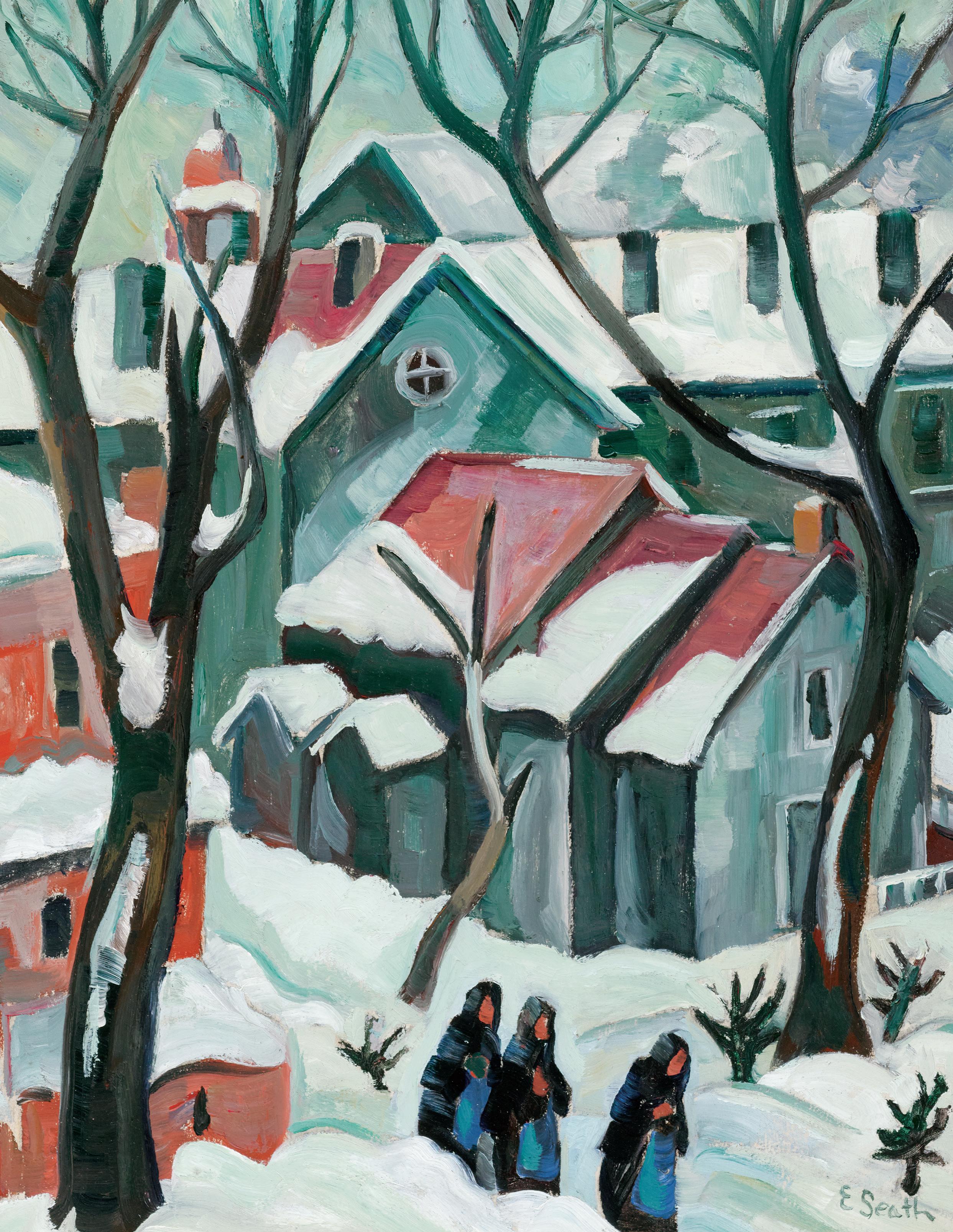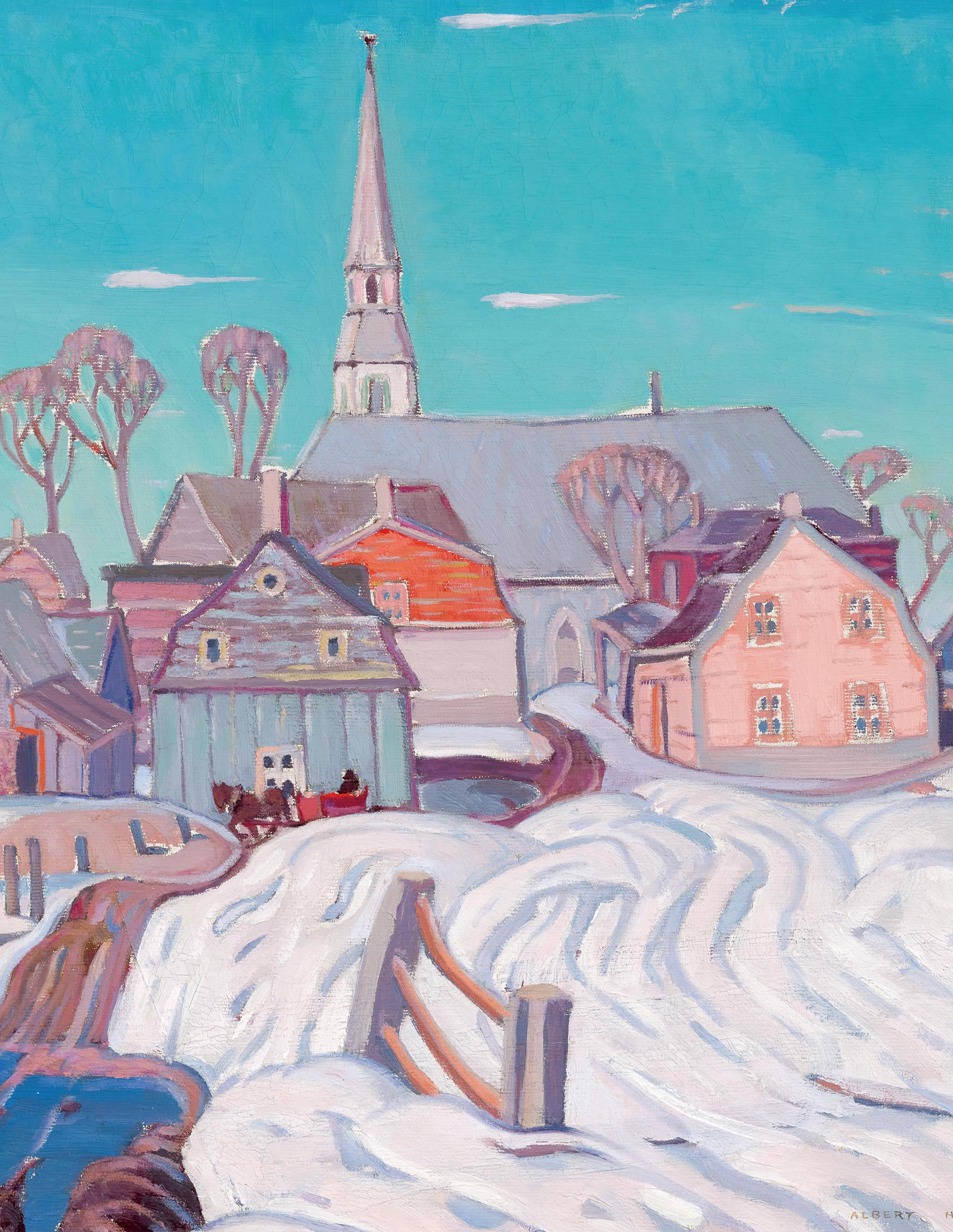
Aucton of Select Important Collectons May 30th, 2024
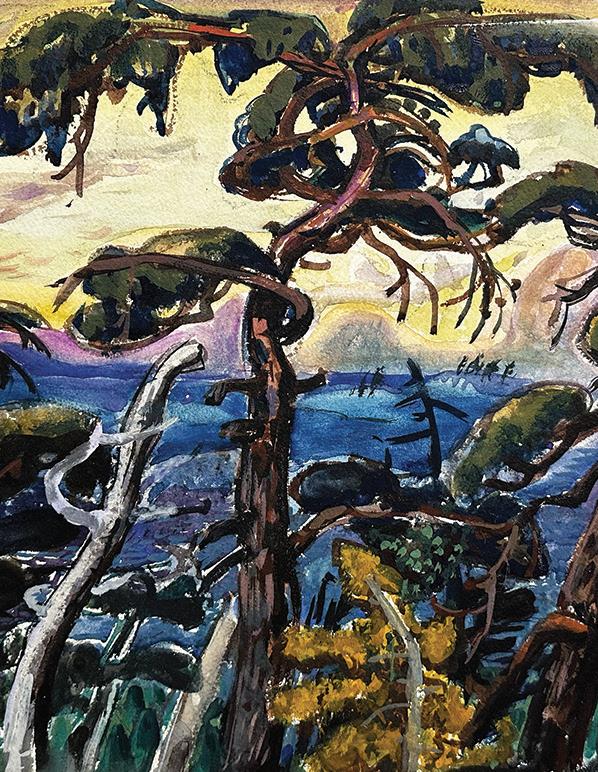

LIVE AUCTION
Thursday, May 30th at 7 pm EST
To follow Session 1
The Globe & Mail Centre
351 King Street East, 17th Floor, Toronto, Ontario
AUCTION OF SELECT IMPORTANT COLLECTIONS


PREVIEW EXHIBITIONS
Winnipeg
A selection of artworks will be on display.
Mayberry Fine Art 212 McDermot Ave
Wednesday, May 1 st to Saturday, May 4 th 10:00 am‒5:00 pm
Toronto
Cowley Abbot
Saturday, May 11th to Thursday, May 30th Monday to Friday: 9:00 am‒5:00 pm Saturdays and Sundays: 11:00 am‒5:00 pm Thursday, May 30th: 9:00 am‒noon
AUCTION PARTICIPATION
In‒Person Bidding
Please contact our offices to reserve your seat and to register for bidding.
Live Stream
A live stream of the auction will be available at CowleyAbbott.ca on May 30 th .
Absentee & Telephone Bidding
Electronic submission of bids & printable bidding forms can also be found at CowleyAbbott.ca.
Online Bidding
Online bidding is available to our clients via Aucton Mobility at live.CowleyAbbot.ca, allowing real‒tme bidding via web browser or Apple/Google app.
Please note that purchases through the Auction Mobility online platform are subject to a 21% Buyer’s Premium.


With over a decade of exemplary service to the art market in Canada, Cowley Abbot contnues to exceed the expectatons of our clientele. Ofering aucton, private sale and appraisal services, the Cowley Abbot team has the experience, relatonships and reputaton to provide the highest level of assistance.
THE COWLEY ABBOTT TEAM















326 Dundas Street West Toronto, Ontario M5T 1G5 416‒479‒9703 | 1‒866‒931‒8415 (toll free)
mail@cowleyabbot.ca
Lydia Abbot
Rob Cowley
Sydney Rodrigues
Eryn Brobyn
Katherine Meredith
Anna Holmes Ryan Mayberry
Perry Tung
Catherine Lacroix
Peter Ohler
Nicole Plasket
Leah Carey
Julia De Kwant
Mathew Ohler
Patrick Staheli
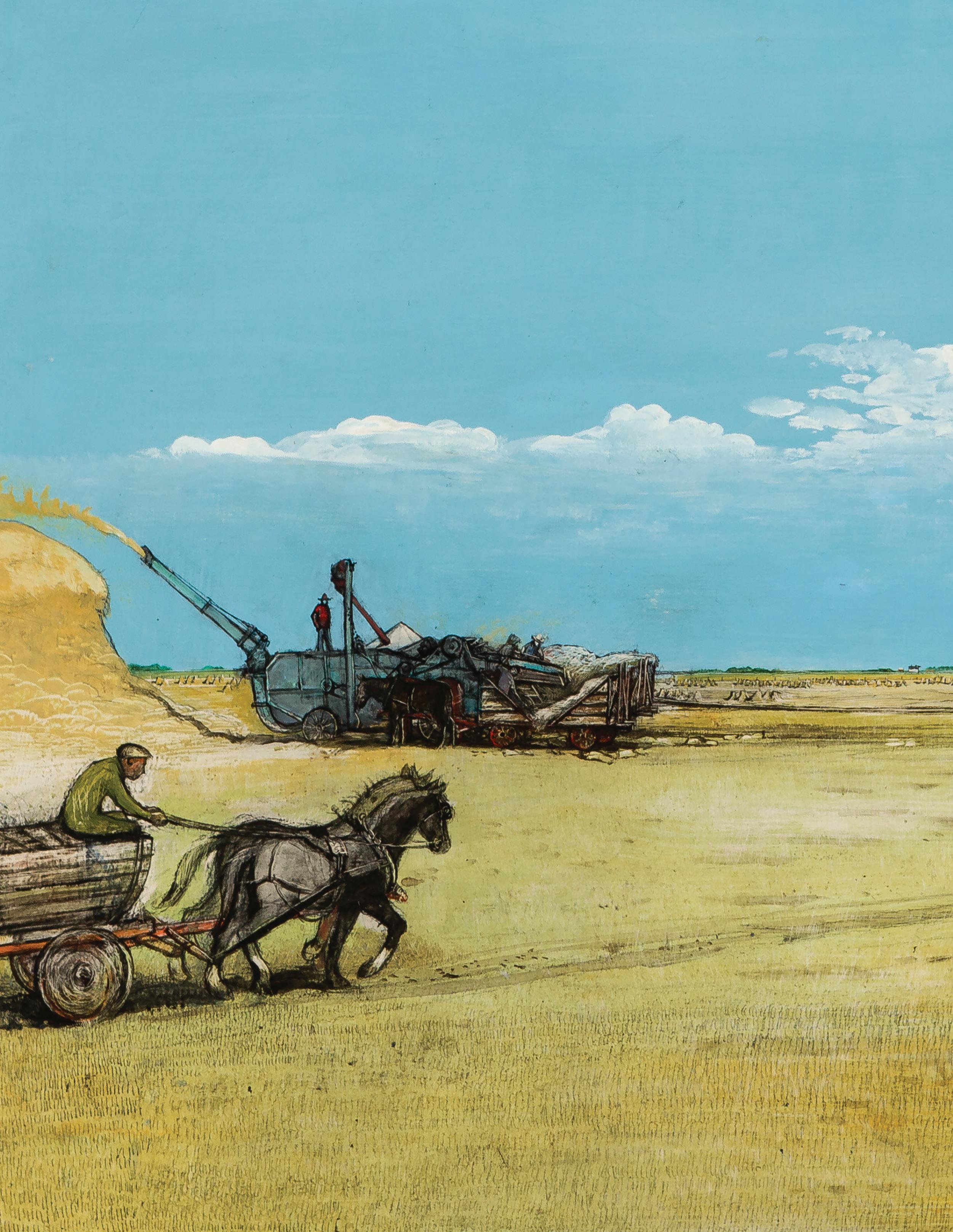
Works from the Collecton of The Winnipeg Art Gallery (WAG)-Qaumajuq
Cowley Abbot is delighted to present a selecton of historical and post-war artworks from the collecton of the Winnipeg Art Gallery (WAG)-Qaumajuq, with an emphasis on artsts from the Winnipeg region.
We have partnered with Mayberry Fine Art to assist and advise the Winnipeg Art Gallery (WAG)-Qaumajuq towards the ofering of this curated assemblage of work this season.
This artwork is being sold to beneft the Winnipeg Art Gallery (WAG)Qaumajuq in establishing an endowment fund to support more diverse representaton in the permanent collecton, beginning with contemporary Indigenous art. Cowley Abbot is pleased to donate our selling commission to the fund as part of the sale.
We extend our thanks to Mayberry Fine Art and to the community of curators, writers and academics who contributed to the research and writng for this collecton of artworks. We thank Stephen Borys, Mark Cheetham, Nicole Fletcher, Brian Foss, Charles C. Hill, Andrew Kear, and Michael Parke-Taylor.
COWLEY ABBOTT | Live Auction - Spring 2024 7
101
JAMES EDWARD HERVEY MACDONALD
Lake O'Hara
oil on board, laid on board signed and dated 1925 lower left 8.5 ins x 10.5 ins; 21.6 cms x 26.7 cms
PROVENANCE
Possibly George Overton, Winnipeg Arnold Brigden, Winnipeg, circa 1945
Estate of Arnold O. Brigden
Collection of e Winnipeg Art Gallery, 1973
EXHIBITED
e Brigden Collection, A Winnipeg Centennial Exhibition , Winnipeg Art Gallery, 29 May-13 October 1974, no.40
Development of Canadian Art, Winnipeg Art Gallery, 26 March 1977-2 April 1978
e Development of Canadian Art, Winnipeg Art Gallery, 10 June 197828 January 1979
e Development of Canadian Art, Winnipeg Art Gallery, 10 March 1979-13 July 1980
Some Canadian Landscape Painters from the Winnipeg Art Gallery Collection , Winnipeg Art Gallery, 10 October 1981-28 February 1982
Little Pictures, Winnipeg Art Gallery, 19 February-17 April 1983
Stored Secrets: e Vault on View, Winnipeg Art Gallery, 11 September-27 November 1994
e View from Here, Winnipeg Art Gallery, 20 May-31 December 2000
Painting Canada: Tom omson and the Group of Seven , Dulwich Picture Gallery, London; travelling to the National Museum of Art, Architecture and Design, Oslo; e Groninger Museum, Groningen, the Netherlands; McMichael Canadian Collection, Kleinburg, Ontario, 19 October 2011-6 January 2013, no. 89
e Collection on View: Tom omson and the Group of Seven , Winnipeg Art Gallery, 27 June 2015-2 April 2018
Salon Style: 20th Century Painting, Winnipeg Art Gallery, 12 October 2018-18 May 2020
LITERATURE
J.E.H. MacDonald, A Glimpse of the West, Canadian Bookman, VI:11, (November 1924), pages 229-231
Patricia E. Bovey, “Introduction,” e Brigden Collection, Winnipeg, 1974
Mary Jo Hughes, e View from Here: Selections from the Canadian Historical Collection , Winnipeg, 2000, reproduced page 64
Gerald Friesen, “Can You Trust It? e View From Here and the WAG Canadian Collection as Historical Documents,” Manitoba History (Spring/Summer 2001), no.41, reproduced page 35
Lisa Christensen, e Lake O’Hara Art of J.E.H. MacDonald and Hiker’s Guide, Calgary, 2003, pages 15, 20-23, 38-59
Jane Lytton Gooch, “Artists of the Rockies: Inspiration of Lake O’Hara,” e Alpine Club of Canada, e Rockies Network , Fernie, B.C., 2003, reproduced page 111
Stephen Borys, Winnipeg Art Gallery: Guide to the Collections, Winnipeg, 2010, reproduced page 77
Ian A.C. Dejardin, "Tom omson and the Group of Seven," in Painting Canada: Tom omson and the Group of Seven , London, 2011, no. 89, page 24, reproduced page 164
Olivier Côté, “Construire la nation au petit écran: Le Canada, une histoire populaire de CBC/Radio-Canada 1995-2002,” Septentrion , Quebec, 2014, reproduced page 209
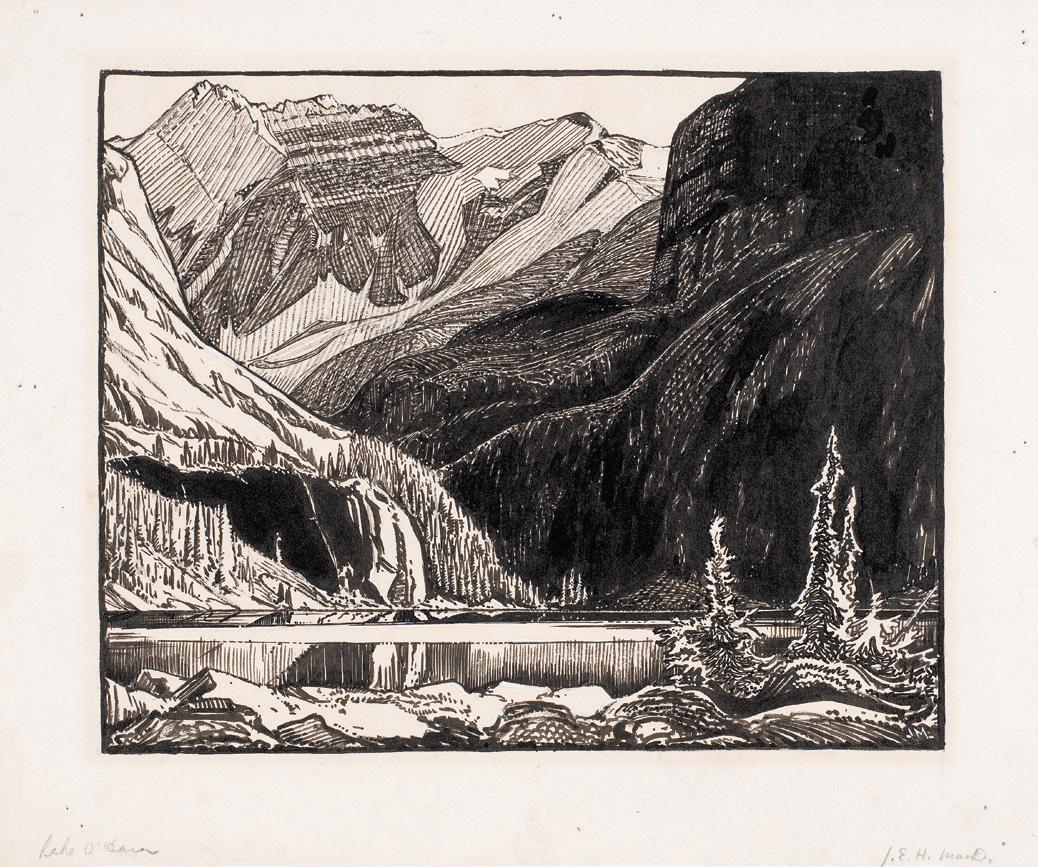
J.E.H. MacDonald
Lake O’Hara, 1924
pen and black ink with white gouache on wove paper, 28.5 x 34.7 cms
National Gallery of Canada, Purchased 1925
Not for sale with this lot
Group of Seven members J.E.H. MacDonald, Lawren Harris and A.Y. Jackson all painted in the Rockies in the summer of 1924. Harris and Jackson painted in Jasper Park while MacDonald painted slightly further north at Lake O’Hara in Yoho National Park. He was entranced. “I got to the beautiful O’Hara lying in a rainbow sleep, under the steeps of Mount Lefroy and the waterfalls of Oesa,” he wrote in e Canadian Bookman. “For nineteen days I wandered in the neighbourhood of O’Hara. I sat and sketched her beauty.” Returning to Toronto he showed paintings of Lake O’Hara, Lake McArthur and Mount Goodsir in the January 1925 Group of Seven exhibition as well as an ink drawing of Mount Lefroy rising above Lake O’Hara, a similar view to this sketch of 1925. As Lisa Christensen, the scholar of the art of the Rocky Mountains, has observed, “It was likely one of the rst scenes that MacDonald would have sketched, an easy walk from the Bungalow Camp through a rolling and open valley.”
Writing about a closely related oil sketch of 1924, titled Morning, Lake O’Hara, Christensen described the view MacDonald depicted here as “the classic depiction of Lake O’Hara…Looking south and slightly east across the lake… Sunlight bathes Mount Lefroy’s glaciers, Allen Glacier and Glacier Peak, in brilliant white… e lake is a still greygreen sliver of malachite.”
MacDonald returned to Lake O’Hara in August 1925 when he painted this sketch, possibly the one he described in his diary on 30 August, “Sketched Lefroy and Peaks in afternoon with O’Hara and rocky foreground.” is is a much more animated and less pastoral view than the drawing of 1924 and must have been painted from higher up, not from the shores of the lake. e water is even a smaller sliver of blue and the trees on the lower slopes are reduced to unde ned brushstrokes of darker green. MacDonald has focused on the colourful, fallen rocks that superbly animate the foreground, playing against the more muted tones of the mountain peaks above and beyond.
COWLEY ABBOTT | Live Auction - Spring 2024 8
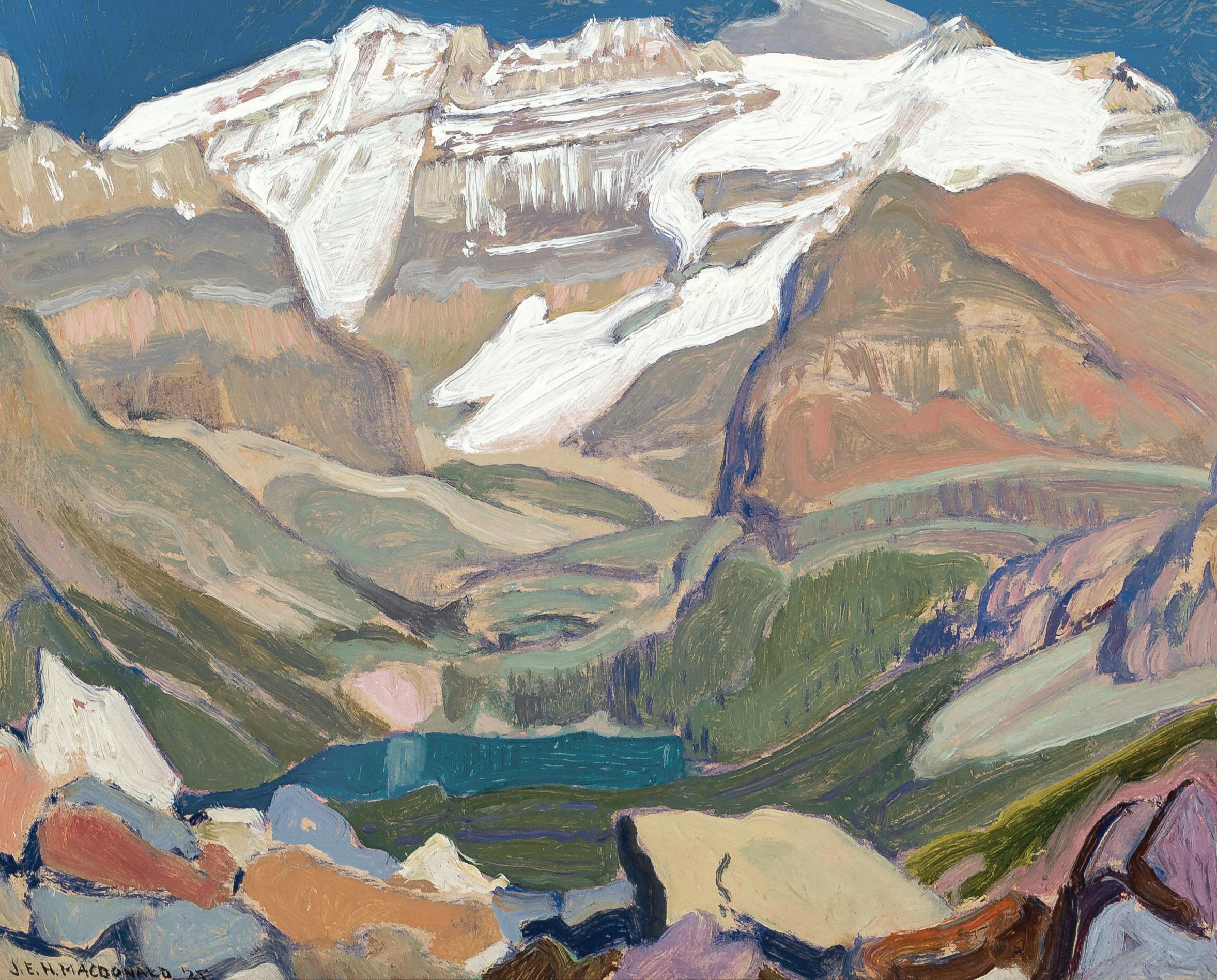
is oil sketch was donated to the Winnipeg Art Gallery from the estate of Arnold Brigden (1886-1972). Born in London, England he came to Toronto in 1914 to join his uncle Frederick Brigden Sr., head of the photo-engraving and printing rm Brigdens Limited, and in 1919 moved to Winnipeg. Opened in 1914 Brigdens of Winnipeg was established to produce the western Canadian catalogue of the T. Eaton Co. and the rm became a centre of art activity in the city. Over the years, employees included, among others, Eric Bergman, Charles Comfort, Fritz Brandtner, Caven Atkins, William Winter, Philip Surrey and Gordon Smith. Arnold was an avid student of Alpine botany and in 1918 joined the Alpine Club spending many summers hiking around Ban . It was undoubtedly his love of the mountains that attracted him to this superb sketch by J.E.H. MacDonald.
We extend our thanks to Charles Hill, Canadian art historian, former Curator of Canadian Art at the National Gallery of Canada and author of e Group of Seven‒ Art for a Nation , for his assistance in researching this artwork and for contributing the preceding essay.
$70,000–$90,000
COWLEY ABBOTT | Live Auction - Spring 2024 9
102
DAVID BROWN MILNE
Bare Trees in Snow (New York) oil on canvas
inscribed "David Milne: Bare Trees in Snow, New York 1914-15" and "Winnipeg Art Gallery" on the stretcher; catalogue raisonné no. 106.7 18.25 ins x 20.25 ins; 46.4 cms x 51.4 cms
PROVENANCE
Picture Loan Society (Douglas Duncan), Toronto Collection of e Winnipeg Art Gallery, 1962
EXHIBITED
Paintings by David Milne, Winnipeg Art Gallery, 26 January 1962
Selections from the Permanent Collection , Winnipeg Art Gallery, 1 July -1 August 1962
David B. Milne from the Winnipeg Art Gallery Collection , Winnipeg Art Gallery, 22 December 1975-4 February 1976
Works of Lionel LeMoine FizGerald and David Brown Milne, Southern Alberta Art Gallery, Lethbridge, Alberta, 4-26 June 1977
Lionel LeMoine Fitzgerald and David B. Milne: Selections from the Winnipeg Art Gallery Collection , Winnipeg Art Gallery, 19 January-24 February 1980
e Development of Canadian Art, Winnipeg Art Gallery, 14 April 1980–13 July 1980
e Canadian Landscape, Winnipeg Art Gallery, 30 April-7 June 1981
Some Canadian Landscape Painters from the Winnipeg Art Gallery Collection , Winnipeg Art Gallery, 10 October 1981-28 February 1982
An Evolving Tradition: Canadian Landscape Painting, Winnipeg Art Gallery, 12 February-12 June 1983
Trees of a ousand Kind and Tall, Winnipeg Art Gallery, 10 December 1983-1 April 1984
Historical Canadian Works from the Collection , Winnipeg Art Gallery, 31 May-19 October 1986
David Milne, Winnipeg Art Gallery, 31 January-22 February 1987
Stored Secrets: e Vault on View, Winnipeg Art Gallery, 11 September-27 November 1994
David Milne: Interior with Paintings, Winnipeg Art Gallery, 18 January-29 March 1998
David Milne, Winnipeg Art Gallery; travelling to the Art Gallery of Southwestern Manitoba, Brandon; under Bay Art Gallery; Moose Jaw Art Museum, National Exhibition Centre, Saskatchewan; Prairie Art Gallery, Grande Prairie, Alberta and Kamloops Art Gallery, 18 January 1998-15 April 2001
Into the Collection , e Winnipeg Art Gallery, 23 July 200513 August 2006
e Collection on View: e Modernist Tradition 1900-1950, Winnipeg Art Gallery, 19 February 2010-31 July 2011
e Collection on View: e Modernist Tradition 1900-1950, Winnipeg Art Gallery, 19 August 2011-31 March 2013
LITERATURE
“Showing of Milne Paintings Is Special Event of Friday”, Winnipeg Tribune, 20 January 1962, reproduced page 16 (exhibition photograph) Pierre eberge, Douglas M. Duncan Collection and the Milne-Duncan Bequest, Ottawa, 1971, reproduced on the frontispiece
Alan Hepburn Jarvis, Douglas Duncan: A Memorial Portrait, Toronto, 1974, reproduced on the frontispiece and jacket
Paul Caul eld, A Path of His Own: e Story of David B. Milne, lm, 1979, the picture is painted over a landscape of circa 1911
Winnipeg Art Gallery Pocket Exhibition Schedule, Fall/Winter 1997/1998, reproduced
Mary Jo Hughes, David Milne: Interior with Paintings. A Selection of Works from the Permanent Collection of the Winnipeg Art Gallery, Winnipeg, 1998
David Milne Jr. and David P. Silcox, David B. Milne: Catalogue Raisonné of the Paintings, Volume 1: 1882–1928, Toronto, 1998, reproduced page 141, no.106.7
One of the pleasures of David Milne’s work is that we can see the formal experiments that he habitually set for himself and follow how he worked and thought through these challenges. In Bare Trees in Snow (New York), there is an oscillation between surface pattern and the receding street scene he depicts. Perhaps we can see these dimensions simultaneously, since we look both at and through the screen of trees. Another challenge adeptly met here is to make a predominantly blue winter scene somehow warm and alive. Milne presents a certain saturated lusciousness in the way the apparently wet snow molds itself to the bare branches, the ground, and the roofs of adjacent houses. Rivulets of intense blue in the foreground suggest melting and movement. Small blue shapes are scattered across the image, making puddles of water but also more surface pattern. ese forms also double as windows in the background buildings.
Where and when this canvas was painted matters in Milne’s career, though perhaps not so much in our current appreciation of his tremendous abilities. While his reference to New York in his title could refer to the city or the state–he spent many years in both locales–we know that at age twenty-one, Milne left rural Bruce County, Ontario, for NYC to attend the progressive Arts Students’ League (1903-05). He worked in the metropolis until 1916, when he moved to Boston Corners in New York State. Milne joined the Canadian Army in 1917 but returned to the United States after World War I.
ough it is an early work in his long and proli c life as an artist, Bare Trees in Snow (New York) demonstrates the cosmopolitan sophistication of handling and conception widely recognized by Milne’s peers in the USA at this time. By 1910, he was exhibiting regularly and was reviewed approvingly in the New York press. As we see in this painting, Milne specialized in urban scenes in the early part of his career, inspired in part by the American Ashcan School (also called ‘ e Eight’: Robert Henri, Maurice Prendergast, and William J. Glackens). Milne was a New York artist at this time rather than ‘Canadian’–in the way that we might say that Jean Paul Riopelle was a Parisian artist in the 1950s and 1960s, for example. It was in the big city that Milne learned the modernist tendencies of both American
COWLEY ABBOTT | Live Auction - Spring 2024 10

and European Impressionism, Post-Impressionism, and Fauvism. Most signi cantly, he exhibited ve paintings in North America’s most important and controversial early exhibition of the avant-garde, the Armory Show in 1913. An intensely and sometimes debilitatingly selfcritical artist throughout his career, in Bare Trees in Snow (New York) Milne shows the con dence that came from his extensive recognition in what was becoming the new centre of modern art.
Mark A. Cheetham has written extensively on Canadian artists, including Jack Chambers, Alex Colville, Robert Houle, and Camille Turner, most recently in the collection Unsettling Canadian Art History (2022). He is a freelance writer and curator and a professor of Art History at the University of Toronto.
$150,000–$250,000
COWLEY ABBOTT | Live Auction - Spring 2024 11
ARTHUR LISMER
Georgian Bay watercolour on paper signed and dated 1938 lower right 15.5 ins x 21.75 ins; 39.4 cms x 55.2 cms
PROVENANCE
Collection of the Artist, Montreal
Peter Dobush, Montreal Collection of e Winnipeg Art Gallery, 1965
EXHIBITED
e Peter Dobush Donation , Winnipeg Art Gallery, 16 November 1965, no. 61
Group of Seven: Works on Paper, Winnipeg Art Gallery, 1-15 October 1976
Trees of a ousand Kind and Tall, Winnipeg Art Gallery, 10 December 1983-1 April 1984
Arthur Lismer Watercolours, MacDonald Stewart Art Centre, Guelph; travelling to the Rodman Hall Arts Centre, St. Catharines, 8 July-27 September 1987
LITERATURE
Ferdinand Eckhardt, e Peter Dobush Donation , Winnipeg, 1965, reproduced Nancy Dillow, e Collection Donations, e WAG, Winnipeg, March 1981, reproduced page 16
Norah McCullough, Arthur Lismer Watercolours, Guelph, 1987, reproduced page 16
Dennis Reid, “ e Later Work of Arthur Lismer,” and Marjorie Lismer Bridges, “Chronology” in Canadian Jungle: e Later Work of Arthur Lismer, Toronto, 1985, pages 28-30, 37, 106
e varying landscapes of Georgian Bay were favourite subjects of the painter Arthur Lismer throughout much of his career. He rst painted there in 1913, staying at the cottage of Dr. James MacCallum at Go Home Bay. It was there he painted the sketches for his famous canvas, September Gale, Georgian Bay in 1920, but from 1922 he painted further west on McGregor Bay near Manitoulin Island, making almost annual trips with his wife and daughter.
Teaching, rst at the Ontario College of Art and, from 1927, at the Art Gallery of Toronto, occupied much of Lismer’s time and in 19361937 he lectured in South Africa, travelling extensively and had no permanent studio. As Dennis Reid has observed, it was at this time that Lismer began painting in watercolour, a medium he continued to use following his return to Toronto. In July 1938 he resigned as Educational Supervisor at the art gallery but it does not appear he was able to make the family’s annual trip to McGregor Bay before leaving to teach at Columbia University in New York on 20 September.
A single tree on a rise in the foreground set against an expansive landscape was a repeated motif in the work of Tom omson and the Group of Seven. From omson’s Jack Pine (1917) to Lawren Harris’ North Shore Lake Superior (circa 1926) to Lismer’s September Gale (1921) and Pine Wrack (1933), all in the National Gallery of Canada, the artists reinterpreted this subject with amazing creativity and imagination. In this superb watercolour, dated 1938 and possibly painted from memory rather than on the spot, Lismer excels in animating the trees, water and clouds. e grey trunks of dead trees left and right and the yellow tree in the foreground frame the dense growth of stunted, wind-blown trees hugging the rocky shore. e central tree, painted in dense greens and browns and drawn with a nervous black line, twists and turns in a writhing dance. e yellow and mauve washes of the clouds echo the movement of the branches that take on an almost anthropomorphic personality. With remarkable expressiveness Lismer has captured the force of nature on the Bay.
e Montreal architect Peter Dobush (1908-1980) most likely acquired this remarkable watercolour directly from Arthur Lismer who, from 1940, taught at the Montreal Museum of Fine Arts. A native of Winnipeg, Dobush worked in Montreal from 1951 and had branch o ces in St. John’s and Ottawa. An active collector of Canadian art, he made major donations to the Winnipeg Art Gallery in 1965 and to Newfoundland and Labrador in 1972.
We extend our thanks to Charles Hill, Canadian art historian, former Curator of Canadian Art at the National Gallery of Canada and author of e Group of Seven‒ Art for a Nation , for his assistance in researching this artwork and for contributing the preceding essay.
$20,000–$30,000
COWLEY ABBOTT | Live Auction - Spring 2024 12
103

ABBOTT | Live Auction - Spring 2024 13
COWLEY
CHARLES FRASER COMFORT
Aura Lee, 1949/1950
oil on canvas
signed lower right 24 ins x 30 ins; 61 cms x 76.2 cms
PROVENANCE
Acquired directly from the Artist Collection of e Winnipeg Art Gallery, March 1952
EXHIBITED
Canadian Paintings, Brandon College, Manitoba, 1-31 October 1963
Charles Comfort: Fifty Years, Winnipeg Art Gallery; travelling to the Art Gallery of Windsor; the Art Gallery of Hamilton and the Confederation Art Gallery and Museum, Charlottetown, 2 January-30 April 1973, no. 41
An Evolving Tradition: Canadian Landscape Painting, Winnipeg Art Gallery, 12 February-12 June 1983
Stored Secrets: e Vault on View, Winnipeg Art Gallery, 11 September27 November 1994
Take Comfort: e Career of Charles Comfort, Winnipeg Art Gallery; travelling to the Confederation Art Centre, Charlottetown and Museum London, Ontario, 10 February-16 December 2007, no. 73 Into Our Collection: Sta Picks, e Winnipeg Art Gallery, 26 June4 October 2008
LITERATURE
Canadian Paintings, Brandon, Manitoba, 1963
Ferdinand Eckhardt, Charles Comfort: Fifty Years, Winnipeg, 1973, no. 41, unpaginated, reproduced Mary Jo Hughes, Take Comfort: e Career of Charles Comfort, Winnipeg, 2007, no. 73, page 24, reproduced page 113
An o cial war artist for Canada during the Second World War, Charles Comfort served during the Allied invasion of Italy in 1943. In 1946, he returned to Canada and earned recognition for his powerful depictions of his wartime experiences. e adjustment to civilian life presented challenges for the artist, as he grappled with nancial di culties and the artistic necessities of nding new subject matter. Comfort persevered, establishing himself as a notable arts organizer and administrator. In the late 1940s, he served on the committees for the Art Gallery of Toronto and the Hart House Gallery, and was elected president of the Canadian Group of Painters in 1950.
During these years, Comfort regularly spent his summers at Cedar Lake in northwestern Ontario, often with fellow artists A.Y. Jackson and Will Ogilvie. Comfort had connections to members of the Group of Seven dating back to the early part of his career. Lawren Harris had been a critical early supporter, and in the 1930s, Comfort had a studio next to A.Y. Jackson in Toronto’s famed Studio Building. With his colleagues, Comfort drew inspiration from the distinct Canadian Shield landscape of the Cedar Lake region. e artist’s work evolved away from his war paintings and increasingly incorporated elements of symbolism and abstraction into his landscapes. Comfort found potential for visual metaphors in tangled piles of branches and driftwood, which regularly formed the foreground of his paintings from the period. At times these shapes take on overt anthropomorphic qualities, as in Aura Lee. Author Mary Jo Hughes observed: “Aura Lee… has a pile of driftwood screening the small island that appears to oat like a ship through the solid, Cedar Lake landscape. Comfort was not merely painting the landscape for itself, his work communicated his concern for the human condition–in this case of deterioration, death, and the promise of renewal.”
In the years following the war, Comfort participated in numerous exhibitions, including the Royal Canadian Academy and the Canadian Group of Painters. Signi cant public sales followed, including the acquisition of Aura Lee by the Winnipeg Art Gallery in 1952. Respected as a cultural activist and administrator, Comfort would go on to serve as director of the National Gallery of Canada from 1959 to 1965.
$10,000–$15,000
COWLEY ABBOTT | Live Auction - Spring 2024 14
104

ABBOTT | Live Auction - Spring 2024 15
COWLEY

WALTER JOSEPH PHILLIPS
York Boat on Lake Winnipeg, 1930 colour woodcut on paper signed, titled and numbered 145/150 in the lower margin 10.25 ins x 13.75 ins; 26 cms x 34.9 cms
PROVENANCE
Marie Guest
Collection of e Winnipeg Art Gallery, 1957
LITERATURE
Malvina Bolus, e Beaver: Magazine of the North, Winter 1969, a similar work illustrated page 4
Roger H. Boulet, e Tranquility and the Turbulence, Markham, Ontario, 1981, a similar work illustrated page 133
Roger H. Boulet, Walter J. Phillips: e Complete Graphic Works, Markham, Ontario, 1981, a similar work illustrated pages 10 and 335
Maria Tippett and Douglas Cole, Phillips in Print: e Selected Writings of Walter J. Phillips on Canadian Nature and Art, Manitoba, 1982, a similar work illustrated (unpaginated plate)
Nancy E. Green, Kate Rutherford and Toni Tomlinson, Walter J. Phillips, Portland, 2013, pages 27-30, a similar work illustrated page 30
Walter Joseph Phillips is revered as one of Canada’s most accomplished printmakers, with artworks rich in masterful technique, graceful design and harmonious balance. e formation of a colour woodcut is a long process. e rst step is to create a sketch in the eld, then produce a watercolour in the studio and then, design the woodblock, which involves carving the blocks and preparing the paper.
Here, Phillips depicts one of the iconic trading vessels of the Hudson’s Bay Company. ese boats played an integral role in transporting goods from inland trading posts to York Factory on the Hudson Bay. e painstaking detail of the precise, curved lines that are repeated in the waves, boat and sail attest to the artist’s talent at printmaking.
York Boat on Lake Winnipeg is one of Phillips’ most popular images, with editions included in the collections of the National Gallery of Canada, e Glenbow Museum and the Art Gallery of Greater Victoria.
$15,000–$20,000
COWLEY ABBOTT | Live Auction - Spring 2024 16
105
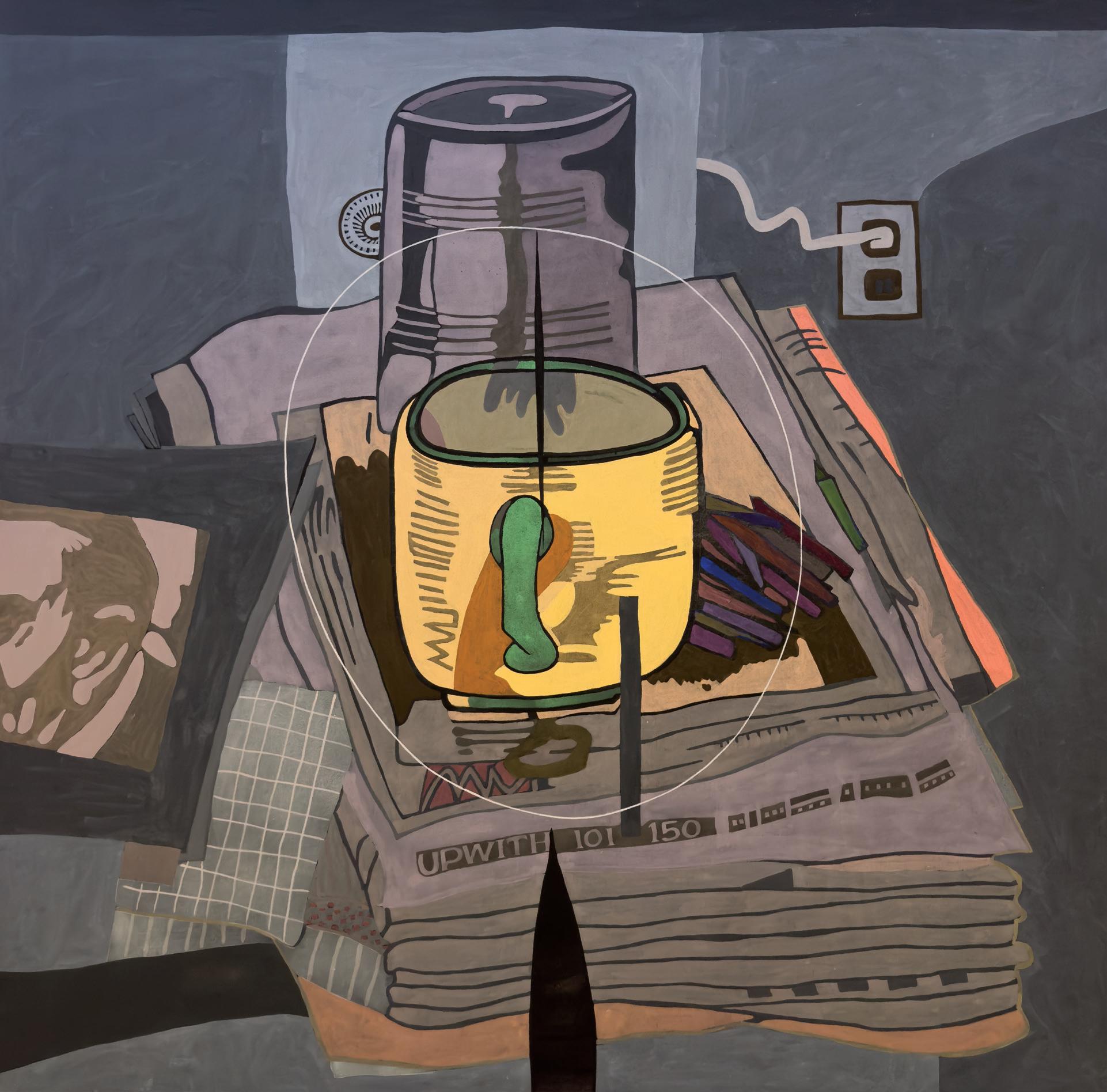
106
IVAN KENNETH EYRE
Café
acrylic on canvas signed and dated 1968 on the reverse; titled on the stretcher 50 ins x 50 ins; 127 cms x 127 cms
PROVENANCE
Roberta Pollock, Ottawa Collection of e Winnipeg Art Gallery, 2015
EXHIBITED
Ivan Eyre: Landscapes and Still Lifes, Winnipeg Art Gallery, 15 September-31 October 2017
LITERATURE
Denis Cooley, Amy Karlinsky and Mary Reid, Figure Ground: e Paintings and Drawings of Ivan Eyre, Winnipeg, 2005, pages 17-18
Sometimes identi ed as a Surrealist, Ivan Eyre would simply state that his work is characterized by his own personal mythology. In 1966-67, he travelled to England and throughout Europe where he was able to sell many of his paintings to private collectors. His works were inspired by the Symbolist philosophy of following subjective recollection and reaction rather than the Realist-Impressionist technique of observation-based painting. His still life paintings, including Café, dating to 1968, contain ambiguous items, including boxes, scrap papers and photographs, which are only somewhat discernable to the eye, as the forms are heavily stylized and tightly arranged. Upon a very close inspection of the painting, we are able to identify a mug and a cord plugged into an outlet, but much remains a mystery. Eyre was committed to engaging the viewer; he brings us on “an active journey through his work by creating paths of movement.” is realm of unidenti able guration, yet separate from abstraction, is a unique and intriguing characteristic of Eyre’s work.
$12,000–$15,000
COWLEY ABBOTT | Live Auction - Spring 2024 17


107
LIONEL LEMOINE FITZGERALD
Untitled (Broken Tree in Landscape) oil on canvas
signed lower left; inscribed "G56-29" on the reverse 14 ins x 17 ins; 35.6 cms x 43.2 cms
PROVENANCE
Collection of e Winnipeg Art Gallery, 1956 (Acquired by e Women's Committee of the Winnipeg Art Gallery)
EXHIBITED
Paintings by the Canadian Group of Painters, Annual Art Exhibit, Heinz Art Salon, Heinz Ocean Pier, Atlantic City, N.J., Summer 1933, no. 19 as Dead Tree
An Exhibition of Paintings by the Canadian Group of Painters, Art Gallery of Toronto, 3 November–early December, 1933, no. 19 as Dead Tree
Exhibition of Paintings by Canadian Group of Painters, Art Association of Montreal, 1-21 January 1934, no. 16 as Dead Tree
Memorial Room for LeMoine FitzGerald 1890-1956, Winnipeg Art Gallery, 30 March 1957, no. 4 as Broken Tree in Landscape
FitzGerald-Memorial Exhibition , Winnipeg Art Gallery, 23 February–23 March 1958, no. 66
FitzGerald 1890-1956, Brush and Palette Club, Portage la Prairie, October 1958, no. 4
e First Ten Years of the Women’s Committee/An Enthusiastic Venture, Winnipeg Art Gallery, 16 April–12 May 1961, no. 13
Canadian Painting in the irties, National Gallery of Canada, Ottawa, 1975, no. 44
Works of Lionel LeMoine FitzGerald and David Brown Milne, Southern Art Gallery, Lethbridge, 1977
Lionel LeMoine FitzGerald: e Development of an Artist, Winnipeg Art Gallery; travelling to National Gallery of Canada, Ottawa; Norman MacKenzie Art Gallery, Regina; Musée d’art contemporain de Montreal; Art Gallery of Ontario, Toronto; the Glenbow-Alberta Institute, Calgary, 28 July 1978–1 December 1979, no. 25
FitzGerald in Context, Gallery One One One, University of Manitoba, 11 October–9 November 2007
A Vital Force: e Canadian Group of Painters, Agnes Etherington Art Centre, Kingston; travelling to e Robert McLaughlin Gallery, Oshawa; Owens Art Gallery, Mount Allison University, Sackville; Mendel Art Gallery, Saskatoon, 16 March 2013–21 September 2014, no. 14
Into the Light: Lionel LeMoine FitzGerald , McMichael Canadian Art Collection; travelling to the Winnipeg Art Gallery, 12 October–7 September 2020
LITERATURE
e Winnipeg Art Gallery 1912-1962: An Introduction to the History, the Activities, and Collection, Winnipeg, 1962, page 31
Frank Bagnall, “Canadian Artists’ Show,” Saturday Night 48, 21 October 1933, no. 50
L.L. FitzGerald to Bertram Brooker, 19 February 1937
Paul Duval, High Realism in Canada , Toronto, 1974, page 38
Charles C. Hill, Canadian Painting in the irties, Ottawa, 1975, page 71, reproduced page 81
Ann Davis, “Lionel LeMoine FitzGerald: A North American Artist,” in Lionel LeMoine FitzGerald: e Development of an Artist, Winnipeg, 1978, reproduced page 47
Lund Humphries, e True North: Canadian Landscape Painting 18961939, London, 1991, reproduced page 94
Art Talks Tours Videos Brochure, Winnipeg Art Gallery, NovemberDecember 1998, reproduced
Winnipeg Art Gallery Pocket Exhibition Schedule, Fall/Winter 1998/1999, reproduced
e Volunteer Committee 50th Anniversary Project, Winnipeg Art Gallery, Winnipeg, 1998, reproduced page 4
Linda Jansma, “Highlights from the Exhibitions 1933-1938,” in A Vital Force: e Canadian Group of Painters, Kingston, 2013, page 41, reproduced page 40
Michael Parke-Taylor, Lionel LeMoine FitzGerald: Life & Work , Art Canada Institute [online publication], 2019, reproduced page 70
Sarah Milroy, Ian A.C. Dejardin and Michael Parke-Taylor, Into the Light: Lionel LeMoine FitzGerald , Kleinburg, 2020, reproduced page 53
Winnipeg artist Lionel LeMoine FitzGerald sensed a “de nite connection” to the Ontario-based Group of Seven although his aims di ered signi cantly. He did not seek sublime views of Canada's vast wilderness as source material for his work nor did he buy into the Group’s aggressive brand of Canadian nationalism. His was a subtle approach to Canadian consciousness communicated by depicting the Winnipeg prairie and urban surroundings that he loved.
With a sequence of exceptional paintings, including Pritchard’s Fence, circa 1928 (Art Gallery of Ontario), Poplar Woods (Poplars), 1929 (Winnipeg Art Gallery), and Doc Snyder’s House, 1931 (National Gallery of Canada), FitzGerald achieved artistic maturity in the late 1920s and early 1930s. In May 1932, Arthur Lismer, acting on behalf of the Group of Seven, invited FitzGerald to become an o cial member. He was pleased to accept this recognition as the only Western Canadian artist to join their ranks. However, his direct association with them was short-lived. e Group disbanded by early 1933 and formed e Canadian Group of Painters (CGP), a larger exhibiting society consisting of the up-and-coming generation of Canadian modernists. FitzGerald was a founding member.
e rst opportunity for the CGP to exhibit came during the summer of 1933 at the Heinz Art Salon located on the Heinz Ocean Pier, Atlantic City. Realizing that this would o er an international stage to showcase contemporary Canadian art south of the border, the participating artists chose those paintings which best represented their work. FitzGerald selected three outstanding small pictures that he had never exhibited: At Silver Heights, 1931 (Art Gallery of Ontario), Apples, Still Life, 1933 (Private Collection), and Untitled (Broken Tree in Landscape), originally titled Dead Tree
COWLEY ABBOTT | Live Auction - Spring 2024 20

An American reviewer of the CGP exhibition, Frank Bagnall, singled out Untitled (Broken Tree in Landscape): “FitzGerald’s Dead Tree has a purity of form akin to the work of Georgia O’Keefe [sic].”
Furthermore, FitzGerald’s painting evokes a similar kind of mystical wonder and beauty as that found in O’Kee e’s visionary landscapes.
FitzGerald’s special relationship with nature is well documented in his writings. “ e seeing of a tree, a cloud, an earth form always gives me a greater feeling of life than the human body. I really sense the life in the former, and only occasionally in the latter. I rarely feel so free in social intercourse with humans as I always feel with trees.” e tree featured in Untitled (Broken Tree in Landscape) is almost split in two, its upper trunk twisted and stripped of bark as if to reveal underlying muscle tissue and its splintered base evoking the legs of a human being. In keeping with his belief that nature is animated by a vital, living force,
FitzGerald invests the seemingly dead tree with a life of its own. He adds a mystical element with a focused beam of light that illuminates a verdant valley bounded by a blue, curved, and shimmering aura. is painting conveys enigmatic and dream-like qualities (“surreal” as some observers have noted) that contribute to its originality making it one of the artist’s most accomplished pictures from the height of his career.
Michael Parke-Taylor is a Canadian art historian, curator, and author of Bertram Brooker: When We Awake! (McMichael Canadian Art Collection, 2024) and editor of Some Magnetic Force: Lionel LeMoine FitzGerald Writings (Concordia University Press, 2023).
$30,000–$40,000
COWLEY ABBOTT | Live Auction - Spring 2024 21
LIONEL LEMOINE FITZGERALD
East Kildonan oil on canvas
signed lower left; titled and dated twice ("1920" and "Sep. 18/20") on the reverse 21.75 ins x 23.75 ins; 55.2 cms x 60.3 cms
PROVENANCE
Collection of Douglas M. Duncan, Toronto Collection of e Winnipeg Art Gallery, 1970
EXHIBITED
FitzGerald in Rural Manitoba , Winnipeg Art Gallery; travelling across the province to McCreary; Neepawa; Dauphin; Virden; Holland; Leaf Rapids and Portage la Prairie, 6 March 1992-10 November 1993 L.L. Fitzgerald's Impressionist Decade 1910-1920, Winnipeg Art Gallery, Spring 2015
LITERATURE
FitzGerald in Rural Manitoba , Winnipeg Art Gallery, 1992
As a teenager, Lionel LeMoine FitzGerald awakened to art when he discovered the Carnegie Library in Winnipeg shortly after it opened in 1905. ere he read the writings of the British artist and critic John Ruskin (1819–1900), who not only o ered guidance on how to draw but introduced FitzGerald to England’s most famous nineteenthcentury landscape painters: John Constable (1776–1837) and J.M.W. Turner (1775–1851).
After several classes in drawing from a living model at A.S. Keszthelyi’s School of Fine Arts in 1909, FitzGerald entered the world of commercial art where he worked for the next nine years. By the beginning of the First World War, his exposure to ne art would have been informed primarily by Barbizon and Hague School landscape paintings with some knowledge of French Impressionism gained indirectly by looking at black-and-white reproductions in the Studio Magazine and its American counterpart International Studio FitzGerald might also have seen some French Impressionist inspired paintings by Canadian artists such as Marc-Aurèle de Foy Suzor-Coté, Maurice Cullen, and Clarence Gagnon when the Winnipeg Museum of Fine Arts (now the Winnipeg Art Gallery) opened in 1912.
FitzGerald would not embark on a formal course of art training until late 1921 when he attended the Art Students League in New York. But in 1920, at age thirty, he was sketching and painting en plein air in the immediate environs of Winnipeg. He painted several pictures in East Kildonan, a primarily agricultural community located about eight kilometres northeast of Winnipeg that could be reached easily by streetcar from downtown. e “Rural Municipality of East Kildonan,” as it was known at the time, became one of FitzGerald’s favourite painting locations and a place that in the early thirties also inspired Winnipeg artists Eric Bergman and Caven Atkins.
East Kildonan , 1920 presents a lively version of FitzGerald’s selftaught Impressionism. e active brushwork of the lush foreground foliage, conceived in blue and green, is complemented by the colour of the farm buildings that are set against an active pattern of sky and cloud. Human presence is represented by the barn and water tower. FitzGerald’s brushwork blends these elements with the rural landscape to create a unity and overall feeling of harmony and natural beauty.
Michael Parke-Taylor is a Canadian art historian, curator, and author of Bertram Brooker: When We Awake! (McMichael Canadian Art Collection, 2024) and editor of Some Magnetic Force: Lionel LeMoine FitzGerald Writings (Concordia University Press, 2023).
$12,000–$15,000
COWLEY ABBOTT | Live Auction - Spring 2024 22
108
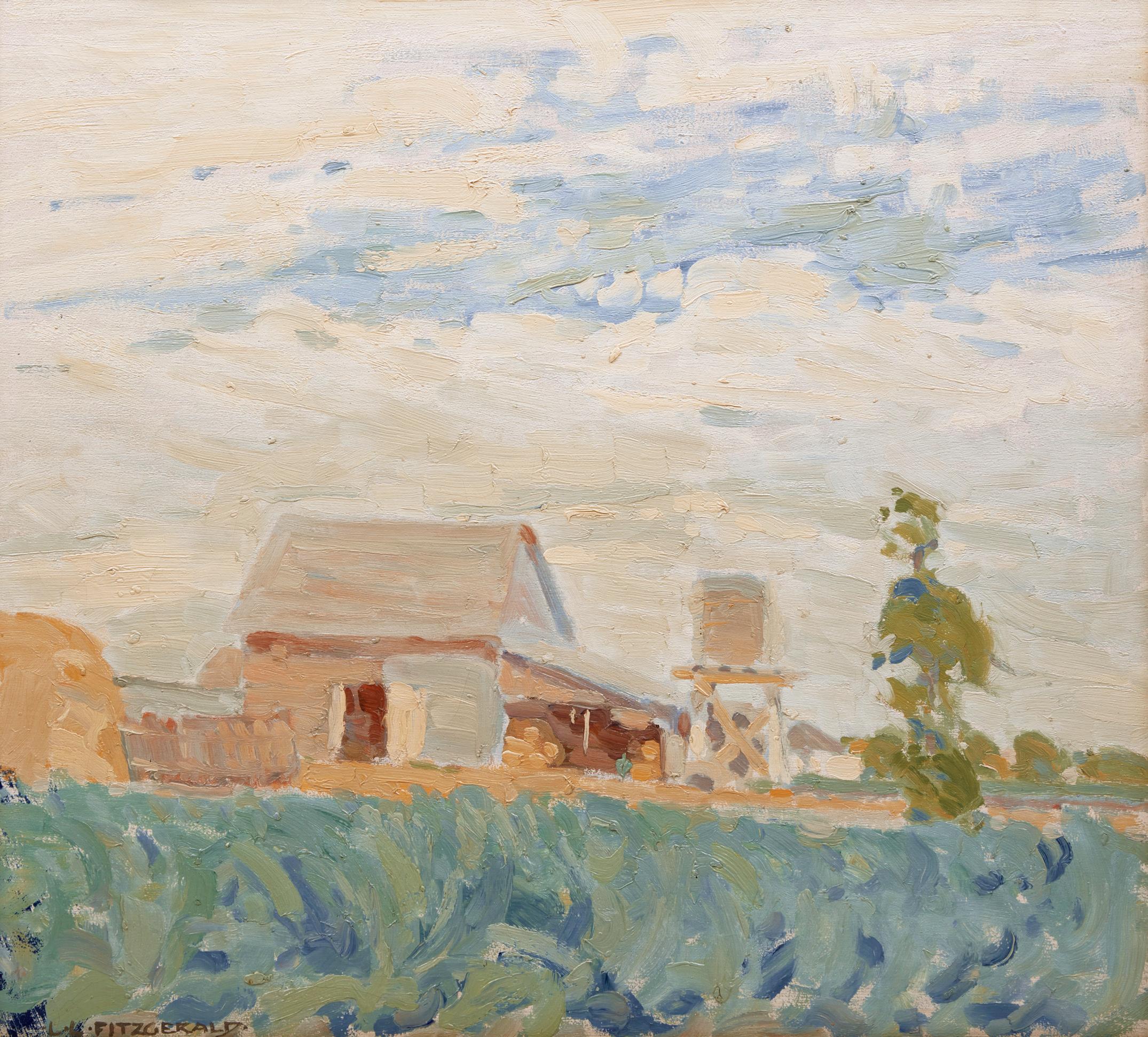
COWLEY ABBOTT | Live Auction - Spring 2024 23
109
KENNETH CAMPBELL LOCHHEAD
Wide Inside (AC-33)
acrylic on canvas signed and dated 1964 on the reverse 68 ins x 80 ins; 172.7 cms x 203.2 cms
PROVENANCE
Gift of the Artist's Family Collection of e Winnipeg Art Gallery, 2006
LITERATURE
Ted Fraser, Kenneth Lochhead: Garden of Light, Regina, 2005, page 54
Kenneth Lochhead moved to Regina in 1950 to teach art at the University of Saskatchewan. Because of his art, teaching, as well as his active role in the contemporary art world, Lochhead helped to give the Regina arts scene national status and has inspired generations of artists across Canada in the second half of the twentieth century. e artist’s cubist path to abstraction resulted in a colourful geometric abstract style, with clean, straight lines and shapes, as well as a large scale, as exempli ed in Wide Inside (AC-33).
Dating to 1964, this work was painted during the height of Lochhead’s career as an abstract artist. e early sixties were highly active and successful for the painter on a national and international level. Lochhead had been painting in an entirely non-representational manner since the beginning of the decade, and was included in the 1961 National Gallery exhibition, Five Painters from Regina , who were considered to be at the forefront of Canada’s modern art movement. He had been participating in the Emma Lake Professional Artists’ Workshops since 1955, with guest workshop leaders including Abstract Expressionist painters and critic Clement Greenberg. Lochhead’s abstract work of the 1960s and 1970s, such as Wide Inside (AC-33), bear resemblances to the Colour-Field painting movement, which had recently established itself in New York. e curved blocks of black, blue, orange and red radiate from the centre of the composition, creating a pentagon shape within the negative space of the bare canvas.
e year 1964 was a signi cant one for Lochhead, as it marked a shift in his work from gestural to hard-edge abstraction. Toward the end of 1963, he had abandoned using masonite as a support, in favour of adjustable rolls of cotton duck canvas. Lochhead also abandoned textural enamel paint for the new transparency of water-based acrylic, a preferred medium among Colour-Field painters. e artist corresponded frequently with Clement Greenberg during 1963-64, discussing formalism, the international art scene, and exhibition opportunities. Lochhead and Kenneth Noland were both featured in Clement Greenberg’s 1964 in uential exhibition Post-Painterly Abstraction , curated for the Los Angeles County Museum of Art, and subsequently the Walker Art Center and the Art Gallery of Toronto.
$25,000–$35,000
COWLEY ABBOTT | Live Auction - Spring 2024 24

ABBOTT | Live Auction - Spring 2024 25
COWLEY
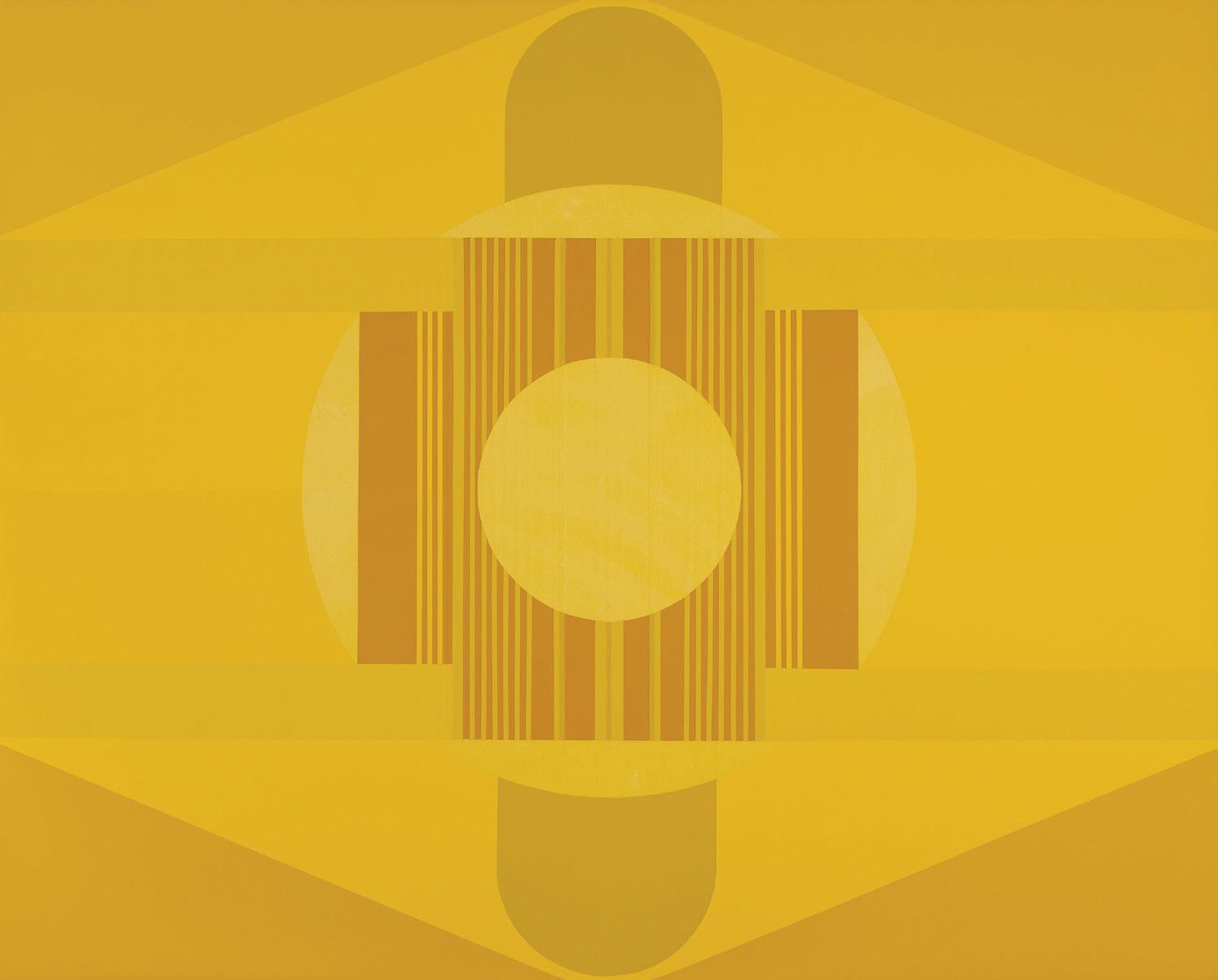
110
TONY TASCONA
Prop-Cycle, 1973
lacquer on aluminum
48 ins x 60 ins; 121.9 cms x 152.4 cms
PROVENANCE
Collection of the Artist
Collection of e Winnipeg Art Gallery, 1974
EXHIBITED
Tascona: Lacquer on Aluminum and Mixed Media , Winnipeg Art Gallery, 21 January-3 March 1974
Recent Acquisitions of Contemporary Art, Winnipeg Art Gallery, 24 April -1 September 1974
Skylight Lounge Filler, Winnipeg Art Gallery, 23 December 197516 February 1976
Winnipeg Art Gallery Collection , Winnipeg Art Gallery, 25 June12 September 1976
O ces, Edmond Préfontaine, Manitoba, 18 September 19798 February 1982
Contemporary Art from the Winnipeg Art Gallery Collection , Winnipeg Art Gallery, 5-22 April 1984
Stored Secrets: e Vault on View, Winnipeg Art Gallery, 11 September -27 November 1994
Tony Tascona: Resonance, e Winnipeg Art Gallery, 24 May16 September 2001, no. 21
Government House, Winnipeg, Manitoba, 5 October 2001-23 April 2002, no. 21
Tony Tascona In Memoriam , e Winnipeg Art Gallery, 20 May 200624 August 2006
e Collection on View (to accompany the 2013 Gallery Ball), Winnipeg Art Gallery, 11-20 October 2013
LITERATURE
Ferdinand Eckhardt, Tascona; Lacquer on Aluminum , Winnipeg, 1974
Patricia E. Bovey, Tony Tascona: Resonance, Winnipeg, 2001, no. 21, reproduced page 66 as Untitled (Prop-Cycle), 1973
Justin Barski “Constructing New Horizons: e Art of Winnipeg Modernist Tony Tascona”, e Arbutus Review, Fall 2014, Vol. 5, No. 1, reproduced page 234
Born in St. Boniface, Manitoba in 1926, Tony Tascona graduated from the Winnipeg School of Art in 1950. His early style was rich with glazes and impastos, and expressionistic with diverse surface textures. To support himself as an artist, Tascona took a job with Canadian Aerospace Industries and, later, with Trans-Canada Airlines (now Air Canada). Here in these industrial environments, the artist became interested in plastics, metals, and lacquers: the synthetic materials and industrial products that went on to inform his work. Tascona explored and exploited the manipulative possibilities of industrial materials, appropriating their visual and practical elements and combining them with a graphic sensibility. He worked with brilliantly coloured printer's inks, including ery reds, acidic purples, and lucid greens. In 1962 Tascona relocated to Montreal, meeting Guido Molinari and Claude Tousignant, whose hard-edge colour painting aligned with his own interest in geometric work. His work moved away from its dense, organic nature to more crisp lines, in lacquered colours on aluminum surfaces. After two years in Montreal, Tascona returned to Winnipeg and began to simplify his compositions, aiming at absolute control of forms. He continued his exploration of shape and space into the 1970s, including Prop-Cycle, 1973, in shades of yellow and ochre synonymous with the decade.
$8,000–$12,000
COWLEY ABBOTT | Live Auction - Spring 2024 26

WILLIAM KURELEK
Negrich Family Threshing Outft oil and graphite on masonite signed with monogram and dated indistinctly 17.75 ins x 30.5 ins; 45.1 cms x 77.5 cms
PROVENANCE
e Negrich Family, circa 1972 Collection of e Winnipeg Art Gallery, 2010
In 1966 William Kurelek held his rst solo exhibition at a public institution, which was at the Winnipeg Art Gallery. e exhibition was spearheaded and co-sponsored by the Alpha Omega Ukrainian Women’s Alumnae Association, an organization founded in 1958 by a dozen University of Manitoba graduates with a desire to foster Ukrainian cultural activities within Winnipeg. is included promoting the work of amateur and professional artists of Ukrainian origin.
Nadia Negrich (nee Skremetka), a member of the association and, its social convener, coordinated Kurelek’s visit to Winnipeg for the opening. She and her future husband Michael Negrich developed a friendship with the artist and hosted him on several occasions over the following decade. Michael sometimes joined Kurelek on his sketching trips throughout southern Manitoba. When Nadia and Michael married in the early 1970s, Kurelek gifted them this painting. Negrich Family reshing Out t is a vicarious memory painting that recounts Michael’s recollection of his childhood homestead in Venlaw, Manitoba in the 1920s, and the farming experience of his parents, Andrew Negrich and Justyna (nee Dzumaga) Negrich.
We extend our thanks to Andrew Kear, Canadian art historian and Head of Collections, Exhibitions and Programs at Museum London for contributing the preceding essay. Andrew is the past Chief Curator and Curator of Canadian art at the Winnipeg Art Gallery, a Curator of the 2011/2012 national travelling exhibition William Kurelek: e Messenger and author of the Art Canada Institute’s William Kurelek: Life & Work , available at www.aci-iac.ca.
$90,000–$120,000
COWLEY ABBOTT | Live Auction - Spring 2024 27
111

112
ALBERT HENRY ROBINSON
Green and Gold oil on canvas
signed and dated 1909 lower left 12.25 ins x 18.25 ins; 31.1 cms x 46.4 cms
PROVENANCE
Peter Dobush, Montreal Collection of e Winnipeg Art Gallery, 1965
EXHIBITED
e Peter Dobush Donation , Winnipeg Art Gallery, 16 November1 December 1965
Development of Canadian Art: 1900-1965, Winnipeg Art Gallery, 18 January-23 March 1975
Canadian Art from the Permanent Collection, 1820-1919, Winnipeg Art Gallery, 16 October-21 December 1976
Canadian Impressionism from the Permanent Collection , Winnipeg Art Gallery, 23 December 1976-9 January 1977
Circa 1900: Selections from the Winnipeg Art Gallery Collection 18801910, Winnipeg Art Gallery, 9 May-27 July 1980
e Canadian Landscape, Winnipeg Art Gallery, 2 December 19807 June 1981
Some Canadian Landscape Painters from the Winnipeg Art Gallery Collection, Winnipeg Art Gallery, 10 October 1981-28 February 1982
Founders’ Exhibition: e Peter Dobush Donation, Winnipeg Art Gallery, 26 April-7 July 1985
LITERATURE
omas R. Lee, Albert H. Robinson: e Painter’s Painter, Montreal, 1956, unpaginated
Born in Hamilton, Ontario, Albert Robinson left Canada to pursue academic training in Paris in 1903, where he studied at the Académie Julian under William Bouguereau and at the École des beaux-arts. Having received formal European training, Robinson would remain faithful to his Canadian roots, returning to paint the rural landscapes of Ontario and Quebec for the remainder of his career alongside Clarence Gagnon, Edwin Holgate, and A.Y. Jackson.
With the support of two patrons in 1907, Robinson relocated to Montreal, where he established his studio and met with prominent artists William Brymner and Maurice Cullen. Robinson exhibited with the Royal Canadian Academy of Arts from 1909 to 1933 and then with the Canadian Group of Painters of which he was a founding member. Robinson was inducted into the Royal Canadian Academy of Arts in 1920, the same year in which he participated as a guest artist at the inaugural exhibition of the Group of Seven in Toronto.
Robinson was once described as “a colourist of the rst order” by Group of Seven member Arthur Lismer. “His art is the colourful expression of daily life, full of charm, devoid of sentimentality, a thoroughly sincere painter who sees life with a gay, simple philosophy, as a colourful arrangement of little towns poised on a hillside… all the lyrical environment of the French-Canadian,” wrote Lismer. Robinson’s Green and Gold , 1909 serves as a brilliant example of the artist’s unique use of brushstroke and colour to convey atmosphere in an impressionistic way. Indeed, the subject of the work is re ected light as the sunset illuminates the clouds above, eliciting shimmering re ections across the surface of the water. Sketches such as this were produced en plein air, an important tenet of the Impressionist movement which greatly in uenced Robinson. e sense of an evanescent moment in nature quickly captured on the canvas is a tribute to Robinson’s skill as a master landscape painter.
$8,000–$12,000
COWLEY ABBOTT | Live Auction - Spring 2024 28

113
GEORGE AGNEW REID
Blue and Gold (Blue and Gold-Temagami Forest or Harmony in Blue & Gold) oil on canvas
signed and dated 1928 lower right 40 ins x 50 ins; 101.6 cms x 127 cms
PROVENANCE
Collection of the Artist
Collection of e Winnipeg Art Gallery, 1943
EXHIBITED
Canadian Painting Exhibition of Selected Artists, National Gallery of Canada, Ottawa, November 1935, no. 92 as Harmony in Blue and Gold Works by Senior Painters in Canada , Art Gallery of Toronto, January 1937, no.63 as Harmony in Blue and Gold
Fifty-Eighth Annual Exhibition of the Royal Canadian Academy, Art Association of Montreal, December 1937, no. 184
Stored Secrets: e Vault on View, Winnipeg Art Gallery, 11 September-27 November 1994
A River Runs rough It: Impressions of Canada's Waterways, Winnipeg Art Gallery, 30 June-23 August 1996
Canadian Mosaic: Selections from the WAG's 20th Century Canadian Collection , e Winnipeg Art Gallery, 21 August 2004-6 March 2005 10th Anniversary Art Exhibition , Gallery in the Park,Winnipeg, 7 June 2018-15 July 2018
LITERATURE
"Review of the Fifty-Eighth Annual Exhibition of the Royal Canadian Academy", Montreal Gazette, Montreal, 1937
Muriel Miller‒Miner, G.A. Reid Canadian Artist, Toronto, 1946, pages 162-163, listed page 206
In 1928, the year in which Blue and Gold was painted, George A. Reid was given a year’s leave of absence at full salary by the Council of the Ontario College of Art in recognition of his steadfast service to the cause of art education. Reid and his second wife, Mary Wrinch, went on a summer sketching trip that year. ey spent a month in Port Hope and then set out on the Ferguson Highway to Temagami in search of inspiration. is artistic period marks Reid’s foray into landscape painting, when he took a sojourn from recording social history, and instead fully embraced depicting lakes, rivers, countryside and scenes of serenity.
Muriel Miller-Miner records the ne detail and compositional aptitude of this painting in G.A. Reid Canadian Artist, stating, “Rhythmically spaced black spruces rise in front of a steel-blue lake; yellow woods beyond are touched by aming sunrays.” Miller-Miner continues, “During this period Reid was painting quiet scenes of lake-studded stretches of forest and barren rock tableland, aming northern sunsets and expanses of blue sky and metallic water, raging torrents and foaming spray. e rugged grandeur of the north, he depicted from Algoma to Temagami and from Abiti to Lake Nipigon.” e power and atmospheric expression of Blue and Gold marks it as a superb example of Reid’s masterly hand.
$12,000–$15,000
COWLEY ABBOTT | Live Auction - Spring 2024 29
BERTRAM RICHARD BROOKER
Still Life with Top Hat, Stone Fragment, Glass Ball and Tumbler, 1931 oil on board
inscribed "Return to 107 Glenview Ave., Toronto" on the reverse 15.75 ins x 19.75 ins; 40 cms x 50.2 cms
PROVENANCE
Gift of Robert and Margaret Hucal, Winnipeg, 2000 Collection of e Winnipeg Art Gallery
EXHIBITED
Sounds Assembling: Bertram Brooker in Winnipeg Collections, Winnipeg Art Gallery, 3 October 1999-30 January 2000
Possibly e View From Here: Selections from the Canadian Historical Collection , Winnipeg Art Gallery, 28 May-31 December 2000
Focus on Paintings, Winnipeg Art Gallery, 24 January-9 March 2003
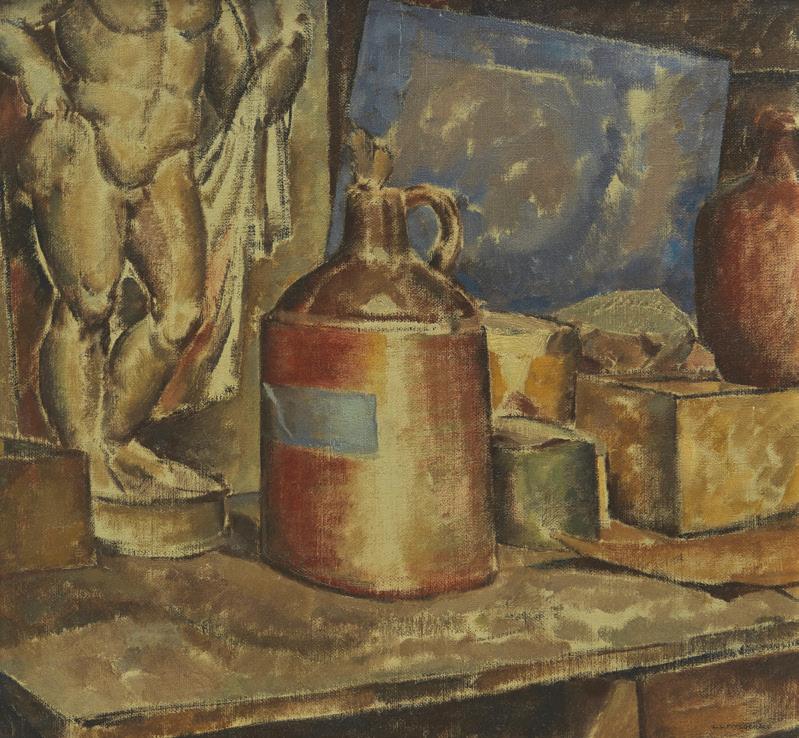
Cowley
Bertram Brooker established his artistic credentials with a landmark exhibition of abstract paintings at the Arts and Letters Club, Toronto in 1927. Although the initial response of his peers was negative, the ensuing notoriety launched his artistic career and eventually catapulted him to fame as the rst artist in Canada to hold a solo show devoted exclusively to abstraction. After meeting Winnipeg artist Lionel LeMoine FitzGerald during the summer of 1929, Brooker shifted to more representational images in the thirties. From that point on, Brooker toggled between abstraction and guration, sometimes combining both approaches in a single picture.
In October 1930, FitzGerald sent Brooker the painting Still Life, 1925 (Private Collection), which he would later purchase. is picture, a constant source of joy for Brooker, included a classical Roman statue (likely a plaster reproduction after the Farnese Hercules) and was perhaps painted at the Winnipeg School of Art where plaster casts were readily available for FitzGerald’s students to copy. e picture may have been a demonstration piece for the students since FitzGerald taught courses on both the Antique and Still Life as part of the general plan of instruction.
With FitzGerald’s Still Life hanging in his living room, Brooker painted Still Life with Top Hat, Stone Fragment, Glass Ball, and Tumbler, 1931. Against a curtained backdrop and upward tilted foreground à la Paul Cézanne, Brooker organized a group of objects representing a basic vocabulary of geometric forms that recall Cézanne’s famous dictum to see nature reduced to the essentials of “cylinder, sphere and cone.” Like FitzGerald, Brooker introduces a historical element with a plaster fragment most likely depicting a detail of the right eye from Michelangelo’s marble sculpture David (Galleria dell’Accademia, Florence). In addition to recreating this surface in paint, Brooker demonstrated his technical versatility by painting a silk hat, glass globe, and metal cup. As the thirties progressed, Brooker would turn continuously to Cézanne as a source of inspiration for the underlying structure and surface treatment of still life compositions.
Michael Parke-Taylor, Canadian art historian, curator and author of Bertram Brooker: When We Awake! (McMichael Canadian Art Collection, 2024) and editor of Some Magnetic Force: Lionel LeMoine FitzGerald Writings (Concordia University Press, 2023).
$10,000–$15,000
8 June 2023,
COWLEY ABBOTT | Live Auction - Spring 2024 30 114
Lionel LeMoine FitzGerald Still Life, 1925 oil on canvas, 46.4 x 50.1 cms Private Collection
Abbott, auction, Toronto,
lot 53 Not for sale with this lot

ABBOTT | Live Auction - Spring 2024 31
COWLEY
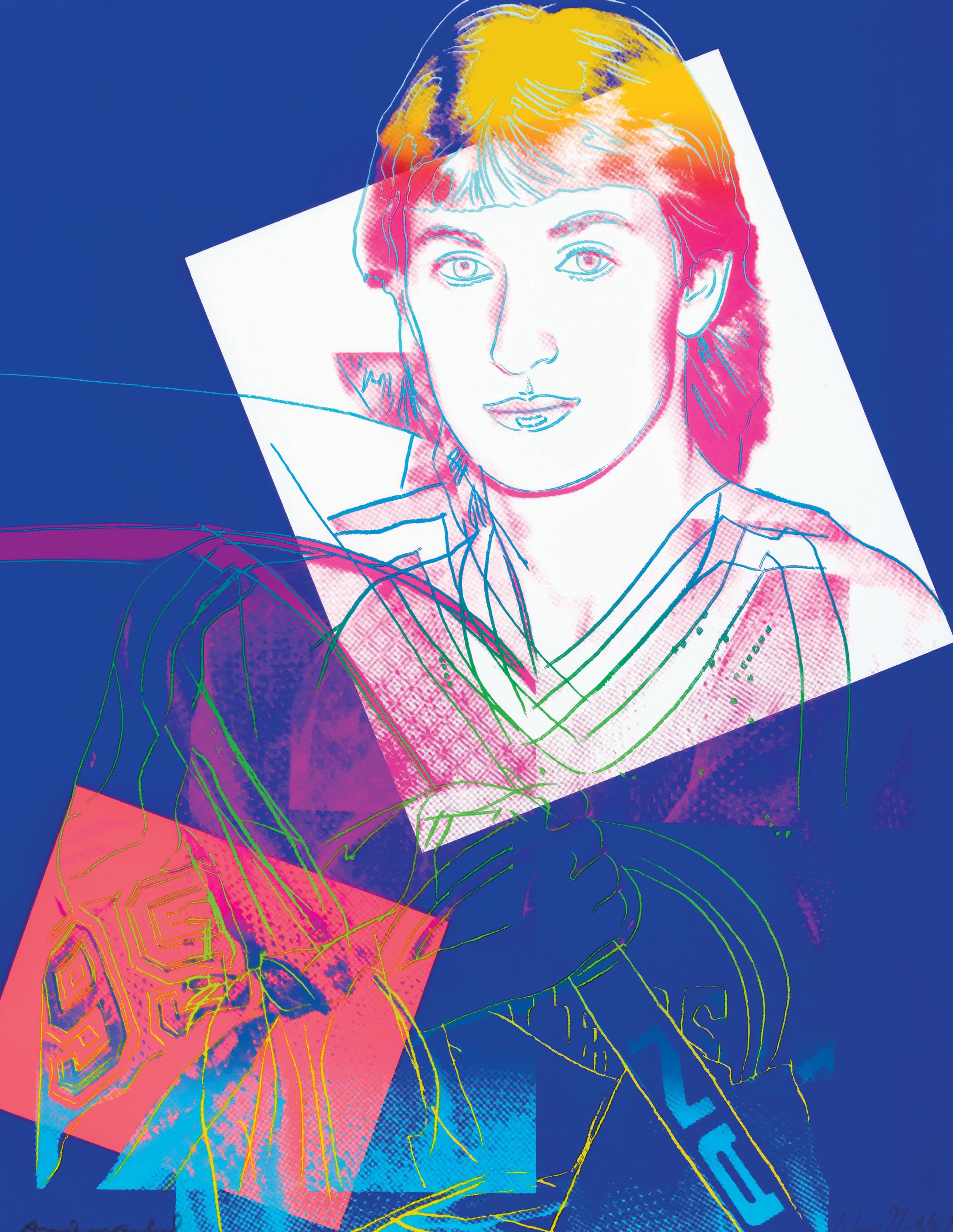
Works from the Collecton of Art Windsor-Essex
Cowley Abbot is pleased to work with Art Windsor-Essex (AWE) to support their new endowment fund by ofering a Paul Kane masterpiece and a print of “The Great One” by Andy Warhol at aucton this spring season. This fund was established to support the care and diversifcaton of the collecton at the AWE.
The gallery holds close to 4,000 works of art in their collecton, featuring important work from some of our country’s most celebrated artsts. Collectng since 1943, the insttuton contnues to evolve and share its collecton while inspiring challenging conversatons with every exhibiton.
We extend our thanks to I.S. MacLaren and the staf of Art Windsor-Essex who contributed to the research and writng for this collecton of artworks.
COWLEY ABBOTT | Live Auction - Spring 2024 33
ANDY WARHOL
Wayne Gretzky #99 (F&S II.306)
colour screenprint on Lenox Museum Board signed, numbered 51/300 lower left and signed by Wayne Gretzky and inscribed "99" lower right; printed by Rupert Jasen Smith, New York; published by Frans Wynans, Vancouver 40 ins x 32 ins; 101.6 cms x 81.3 cms
PROVENANCE
Private Collection
Collection of Art Windsor-Essex
LITERATURE
Frayda Feldman and Jörg Schellmann, Andy Warhol Prints: A Catalogue Raisonné 1962-1987, 4th edition, 2003, catalogue no. II.306 Pat Hackett, e Andy Warhol Diaries, New York, 2014, page 515 CBC Archives, “When Andy Warhol and Wayne Gretzky Teamed Up for a Portrait,” 12 December 2019 [online publication]
“My idea of a good picture is one that’s in focus and of a famous person.”
–Andy Warhol
Andy Warhol and Wayne Gretzky were brought together by Vancouver gallerist and dealer Frans Wynans hoping to expand his client’s collection of works that focused on e Group of Seven. Gretzky was reportedly a fan of the artist long before their meeting. e idea also appealed to Warhol since, in 1977, he had created his portfolio, Athletes, featuring ten portraits, including those of Muhammad Ali, O.J. Simpson, Jack Nicklaus and Pelé.
On the day of the sitting at the artist's Manhattan studio, Warhol thought he was being stood up, as Gretzky was over three hours late, due to tra c. Adding to the tense atmosphere, Gretzky arrived without hockey equipment, but the problem was quickly resolved at the sporting goods store just across the street.
A section of Warhol’s diary entry, for ursday, June 9, 1983, describes the meeting: “Got up early because I had a 10:00 appointment at the o ce that Fred had made with Wayne Gretzky of the Oilers (cab $6). When I got there they said the Gretzky had just called and said he was coming right down. Meanwhile Fred who had made this early, early meeting wasn’t there yet. By 12:30 I was still the only one there, and I was mad… And nally Gretzky arrived and he was adorable, blond and twenty-two and cute. He doesn’t wear shoulder pads when he plays. I told him he should go into the movies and he said that he was going to be in a Fall Guy and a Tom Selleck. He dates a Canadian singer.”
Warhol focuses on “ e Great One’s” boyish blond hair and intense stare, highlighted by the neon colours placed on a large white square, which is further o set against the intense blue background. He also uses a large neon pink square to highlight Gretzky’s famous number, ninety-nine, with stylistic coloured outlines drawing attention to the hockey stick he holds, as the last few letters of the hockey logo ‘Titan’ are just visible; a brand Gretzky would be associated with throughout his career.
e original paintings Warhol created from the sitting were originally sold for $35,000, and the screenprints sold for $2,000. Gretzky kept one of the portraits for himself, choosing the one with: “ e Oiler colours, if you can see the blue with the orange and white,” he said. “ ey all look the same, but the colour in that one was the one that I seemed to like the most.”
$20,000–$30,000
COWLEY ABBOTT | Live Auction - Spring 2024 34 115

| Live Auction - Spring 2024 35
COWLEY ABBOTT


116
PAUL KANE
Party of Indians in Two Canoes on Mountain Lake, circa 1855
oil on canvas catalogue raisonné no. IV-281
18.75 ins x 29 ins; 47.6 cms x 73.7 cms
PROVENANCE
Collection of Fred and Beverly Schae er Collection of Art Windsor-Essex, April 1980
EXHIBITED
Canadian Roots, Rodman Hall Arts Centre, St. Catharines, Ontario, 8 January-1 February 1982
Canadian Painting Before 1900, Burlington Cultural Centre, 1 September-29 October 1982
New World-Old World: Eurocentric Perceptions of First Nations Peoples and the Landscape, Art Gallery of Windsor, 9 April-18 September 1994, no. 24
Referencing Robert Reginald Whale: Selections from the Collection, Art Gallery of Windsor, 23 February-24 March 1996, no. 5
Art for Canada: An Illustrated History, Art Gallery of Windsor, April 2009-January 2013
ReAppearances: "Old Friends" from the AGW Collection , Art Gallery of Windsor, April 2012-February 2015
Look Again! Celebrating the AGW Collection , Art Gallery of Windsor, April 2015-October 2018
Look Again! e AGW Collection at 75 Years, Art Windsor-Essex, November 2018- June 2021
LITERATURE
[Paul Kane], Wanderings of an Artist among the Indians of North America from Canada to Vancouver’s Island and Oregon through the Hudson’s Bay Company’s Territory and Back Again , London, 1859
George William Allan, “Notes to Daniel Wilson,” 1871. Transcribed by John A.H. Vernon and Susan E.H. Vernon, Royal Ontario Museum, 12 September 2000
John Russell Harper, Paul Kane’s Frontier, University of Toronto Press, Toronto, 1971, page 292, no. IV-281: “Party of Indians in two canoes” on mountain lake. Evidently this is a representation of an Indian legend. IV-280 is possibly a preliminary sketch. Oil on canvas. 1’6” x 2’5”. (Colln Peter Winkworth)”
John Russell Harper Fonds, Library and Archives Canada, MG30 D352, vol. 10, le 16, Correspondence, 1972
Catherine Mastin, New World-Old World: Eurocentric Perceptions of First Nations Peoples and the Landscape, Windsor, 1994, no. 24
Robert Stacey, Referencing Robert Reginald Whale: Selections from the Permanent Collection , Windsor, 1996, listed as no. 5
I.S. MacLaren, Paul Kane’s Travels in Indigenous North America: Writings and Art, Life and Times, McGill-Queen’s University Press, Montreal and Kingston, 2024, page 4:230, no. IV-281 (IV-280 is “Party of three Indians in birch-bark canoe. Pencil. 50” x 90”. (ROM 94-6.15.301).”
In an important respect, the studio canvas known as Party of Indians in Two Canoes on Mountain Lake (catalogue raisonné no. IV-281) di ers from all but about one dozen canvases in the Kane œuvre. Like Ojibwa Camp in the Spider Islands, which Cowley Abbott Fine Art sold at auction from a private collection 1 December 2022, Party of Indians did not number among the 100 canvases that Kane painted to ful ll his $20,000 commission from Torontonian George William Allan (1822–1901), now in the Royal Ontario Museum, or the twelve that the Legislative Assembly of the Province of Canada commissioned for £500, eleven of which are now in the National Gallery of Canada. Almost needless to note, the availability of a Kane canvas is a rare event, indeed.
e subject matter of Party of Indians in Two Canoes on Mountain Lake is typical of a Kane canvas in several details: the delicately rendered deciduous trees that serve as the work’s left-hand coulisse, the rocky outcropping, the lacustrine middle ground, and the cloud-laden sky. e colouration is also typical for a studio canvas by Kane and resembles very much that found in Ojibwa Camp in the Spider Islands (III-30). is typical choice of palette in his studio was described in 1871 by George Allan, his patron: a “predominance of light browns and yellows … a sameness in tone and colouring which I attribute to their being painted in the studio from his sketches instead of out of doors on the spot”. Another similarity are the measurements of Party of Indians and Ojibwa Camp, 46 × 74 cm. (Fifty-three works by Kane at the Royal Ontario Museum, ten at the National Gallery of Canada, and ten others, that is, about sixty per cent of Kane’s output on canvas share this signature scale.) Finally, both works enjoyed each other’s company in the same private collection during much of the 1970s, before the Art Gallery of Windsor (now Art Windsor-Essex) acquired Party of Indians in 1980.
When in 1971 he gave the work its name, John Russell Harper estimated the subject matter of Party of Indians in Two Canoes on Mountain Lake as “evidently ... a representation of an Indian legend,” he was indulging in speculation, principally perhaps because the canvas can be linked to none of Kane’s surviving sketches. However, the location of the setting of the work is discernible by the presence just to the right of the deciduous tree of the readily recognizable form of the mountain known to fur-trade brigades and still today as Roche Miette.
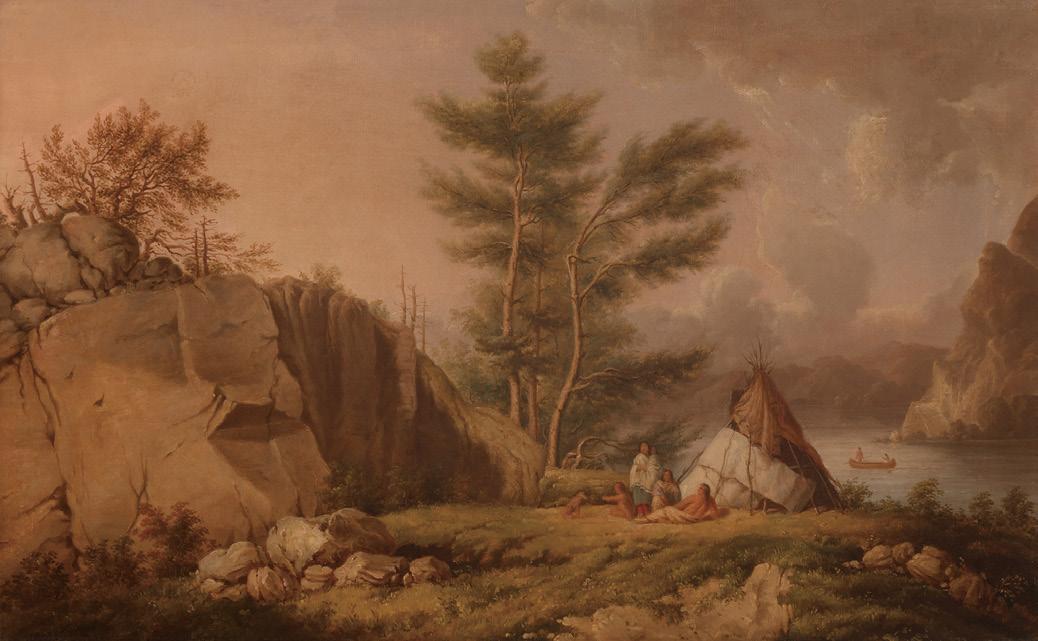
Private Collection
Cowley Abbott, auction, Toronto, 1 December 2022, lot 136 Not for sale with this lot
COWLEY ABBOTT | Live Auction - Spring 2024 38
Paul Kane
Ojibwa Camp in the Spider Islands, circa 1845 oil on canvas, 45.7 x 73.7 cms
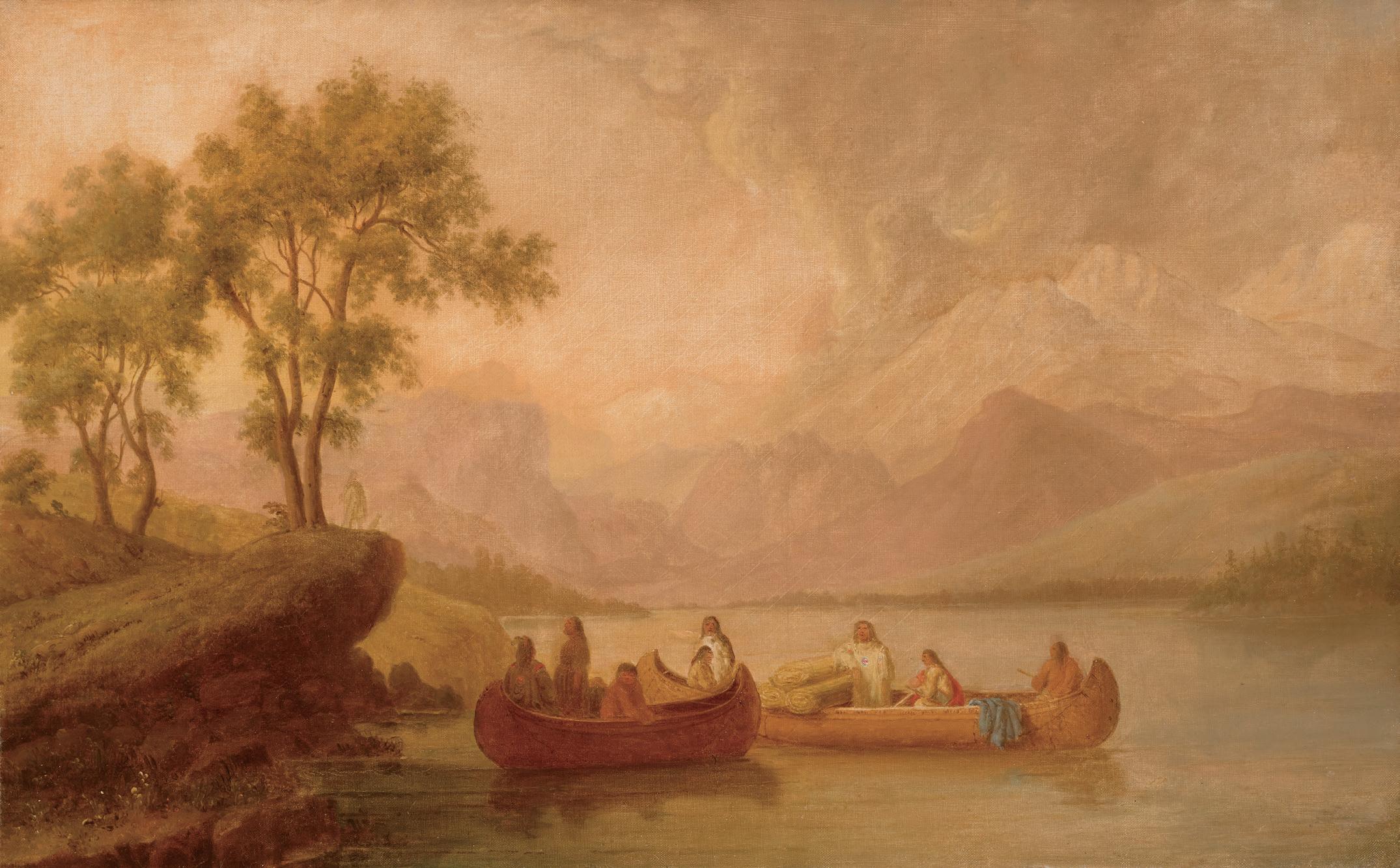
COWLEY ABBOTT | Live Auction - Spring 2024 39
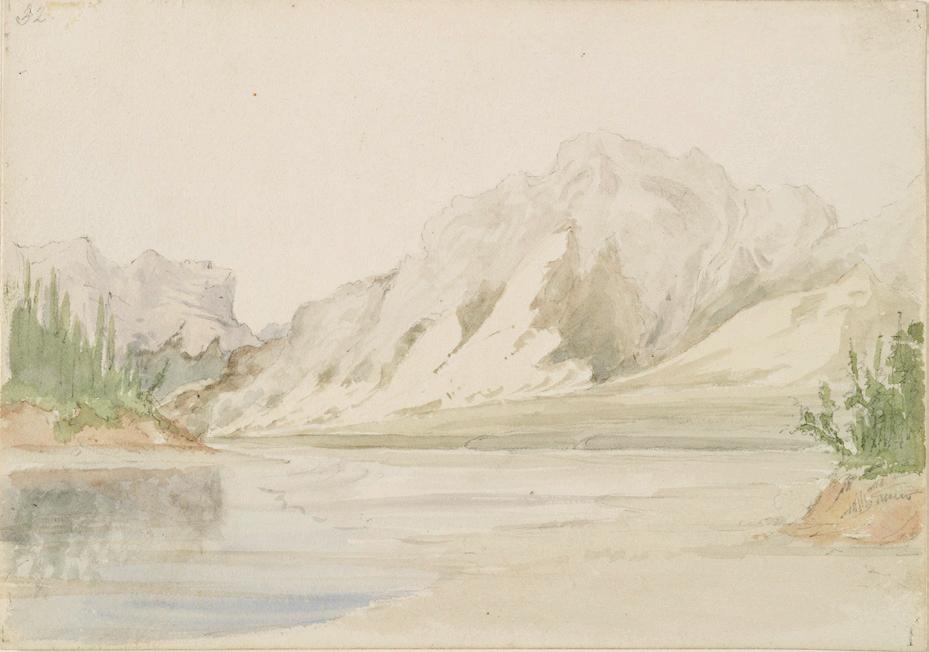
Paul Kane
Jasper’s Lake with Miette’s Rock , early November 1846
watercolour and graphite on paper, 12.5 x 17.8 cms
ROM, 946.15.130
Not for sale with this lot
(Notably, Kane revised the placement of this mountain’s shape after introducing it farther into the background; the original is discernible farther to the right and above it.) Under the distinctive right angle of Roche Miette ows the Athabasca River on its way northeast and out of today’s Jasper National Park. Roche Miette serves aesthetically as the park’s eastern portal; it greets westbound travellers of the Yellowhead Highway as they descend from the upper town of Hinton, Alberta, to the park’s east gate.
Kane sketched Roche Miette at least four times, all works in the collection of the Royal Ontario Museum: Athabasca River and Roche Miette, catalogue raisonné IV-246, (ROM 946.15.268); Athabasca River and Roche Miette, catalogue raisonné IV-247, (ROM 946.15.234); Jasper’s Lake with Miette’s Rock, catalogue raisonné IV-249, (ROM 946.15.130); Athabasca River with the Rocky Mountains in the Distance, catalogue raisonné IV-245, (ROM 946.15.131.1). e last of these, a watercolour, o ers a very similar perspective of Roche Miette; it may

Paul Kane
Athabasca River with the Rocky Mountains in the Distance , early November 1846
watercolour and graphite on paper, 12.5 x 17.8 cms
ROM, 946.15.131.1
Not for sale with this lot

Paul Kane
Dalle des Morts, or the Rapid of the Dead , 1849-1856 oil on canvas, 46 x 74 cms
ROM, 912.1.20
Not for sale with this lot
be found at the mouth of Fiddle River, with the Athabasca River in the foreground owing from left to right, just to the south of where it widens into Lac Brûlé, as the fur trade knew it. In the upper right, Party of Indians supplies an entire range of taller mountains than one nds looking upriver in Jasper National Park. By contrast, the deciduous trees are not out of place; they could represent any of the aspen, balsam poplar, black cottonwood, or white birch that populate the portion in the Rockies of the Athabasca River valley.
In terms of setting, this is Kane’s only canvas with a setting of the eastern Rockies (He made two renditions of the Selkirks and Monashees, the ranges through which the Columbia River ows. One is Dalle des Morts, or the Rapid of the Dead, catalogue raisonné IV-17, (ROM 912.1.20), and the other is Boat Encampment, catalogue raisonné IV-278, (ROM 912.1.60), a second version of which is e Encampment, catalogue raisonné IV-279, (Glenbow Museum 57.32.5).
In a conventional manner, Indigenous gures that supply the sta age in the left foreground animate the scene. Perhaps they are o ering to trade with the gure on the rocky foreground river bank. However, the three rolled items in the right-hand canoe do not appear to be trade items; rather, their lined surfaces suggest mats or lodge covers. Meanwhile, one would normally consider Ojibwe canoes inappropriate for a setting in the Rockies, and this could be an instance of poetic license, of which Kane’s studio work o ers numerous examples. However, it needs recalling that even by the turn into the nineteenth century, the North West Company was hiring Iroquois, Ojibwe, and Nipissing to trap beaver and other fur-bearing animals on the Eastern Slopes. at said, the two hide shirts that are distinctive among the eight garmented members of the canoe party replicate Plains Cree shirts that Kane collected and used in other works. For example, the beadwork in the disc and shoulders of the shirt worn by the gure in the bow of the larger canoe somewhat resembles that worn in Kane’s oil-on-paper sketches of Potika-Poo-Tis or “ e Little Round Man,” catalogue raisonné IV-207, (Stark Museum of Art, 31.78.146), and Cree Indian, catalogue raisonné IV-139, (Stark Museum of Art 31.78.154).
e gure with his back to the viewer in the canoe on the left wears a skin shirt the stroud cloth-and-beaded shoulders of which call to mind the shirt worn by Wahhe-joe-tass-e-neen, the Assiniboin chief on the right of the sketch Assiniboin Chiefs at Rocky Mountain House, catalogue raisonné IV-221, (Stark Museum of Art, 31.78.112). ere, it is shown
COWLEY ABBOTT | Live Auction - Spring 2024 40

Paul Kane
Boat Encampment , 1849-1856
oil on canvas, 46.1 x 73.8 cms
ROM, 912.1.60
Not for sale with this lot
from the front and without a beaded disc, as is also the case in another eld sketch, Wah-he-joe-tassee-neen, catalogue raisonné IV-225, (ROM 946.15.55) and in the subsequent studio canvas, Second Chief of the Assineboins, catalogue raisonné IV-226, (ROM 912.1.14).
Only three of the eight gures in Party of Indians in Two Canoes on Mountain Lake face the viewer. e signature facial depiction for Kane’s sta age representation of an Indigenous person may be found in the pro le of the sternsman of the larger canoe, whose paddle keeps the craft headed into the bank. at signature comprises straight dark hair dividing the oval of the head more or less in half. More details include the feather worn by the gure on the far left in the nearer canoe, with his back to the viewer; the gure of the woman dressed in a belted garment second from the left in the nearer canoe is trading something or trading news (or Harper’s legend?) with the gure and his dog on the river bank, although it is uncertain which is listening and which talking; in the tradition of situating the “plot” of the scene so that the lower gure is looking up to the light, one nds a conventional representation of oral exchange that is directed upwards, as if to enlightenment. Why the gure onshore is left un nished and thus contributes a vestigial presence is uncertain. e two pairs of trees evoke the landscapes of Claude Lorrain, while numerous black spruce across the river on the point that serves as the right-hand coulisse of the work are appropriate to the Athabasca River valley. e larger canoe has more detail along the gunwale and at bow and stern, but that detail adumbrates the irregularities of birch bark rather than any painted design. e blue blanket hanging over the gunwale is the correct shade of blue to be an HBC trade blanket. is is the case, as well, for the red of the blanket at the infant’s head and feet in the midships of the larger canoe.
Altogether, Party of Indians in Two Canoes on Mountain Lake possesses both narrative and aesthetic interest of great value.
We extend our thanks to I.S. MacLaren, Professor Emeritus, University of Alberta, for contributing the preceding essay. McGill-Queen's University Press has just issued his four-volume work, Paul Kane's Travels in Indigenous North America: Writings and Art, Life and Times.
$600,000–$800,000
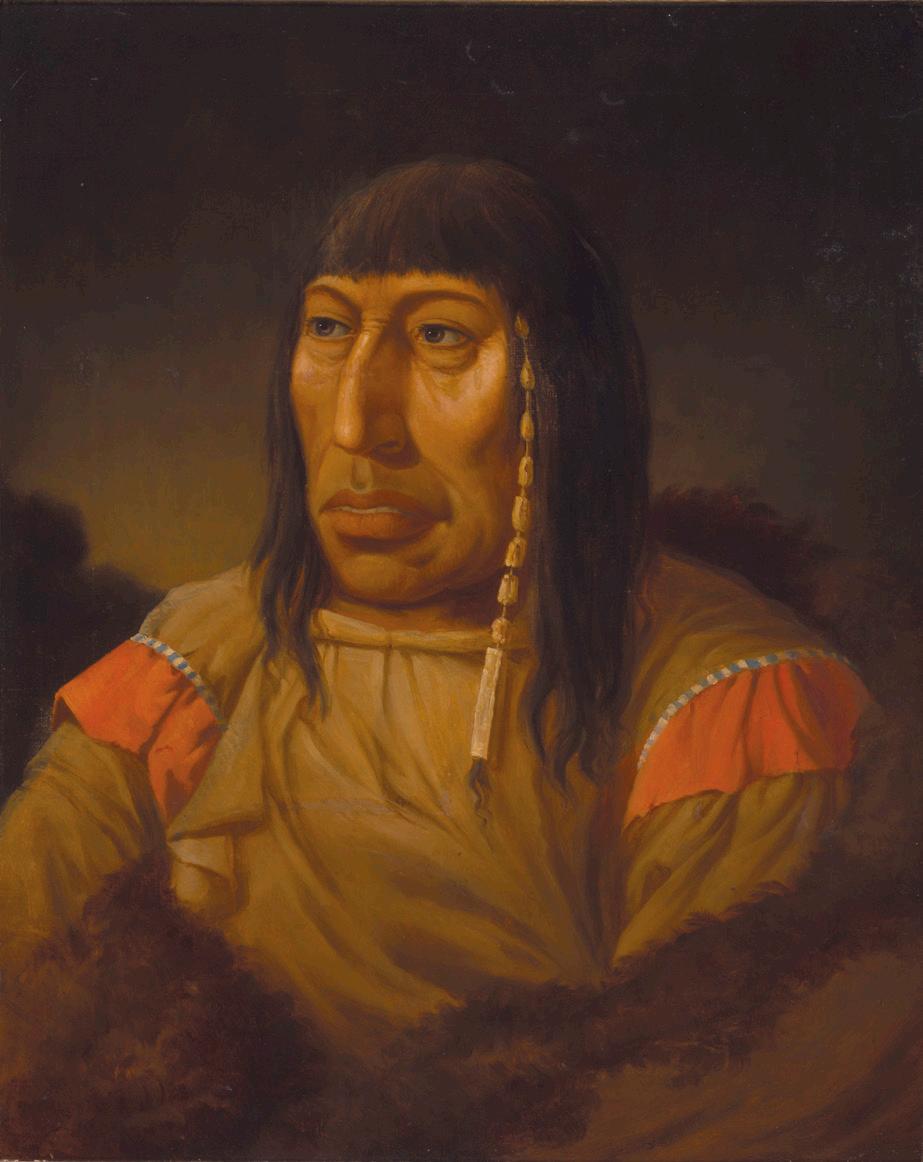
Paul Kane
Second Chief of the Assineboins (Portrait of Wah-he-joe-tasse-e-neen), 1849-1856 oil on canvas, 63.3 x 51.2 cms
ROM, 912.1.14
Not for sale with this lot

Paul Kane
Wah-he-joe-tasse-e-neen , late April-early May 1848 watercolour and graphite on paper, 12.8 x 10.7 cms
ROM, 946.15.55
Not for sale with this lot
COWLEY ABBOTT | Live Auction - Spring 2024 41
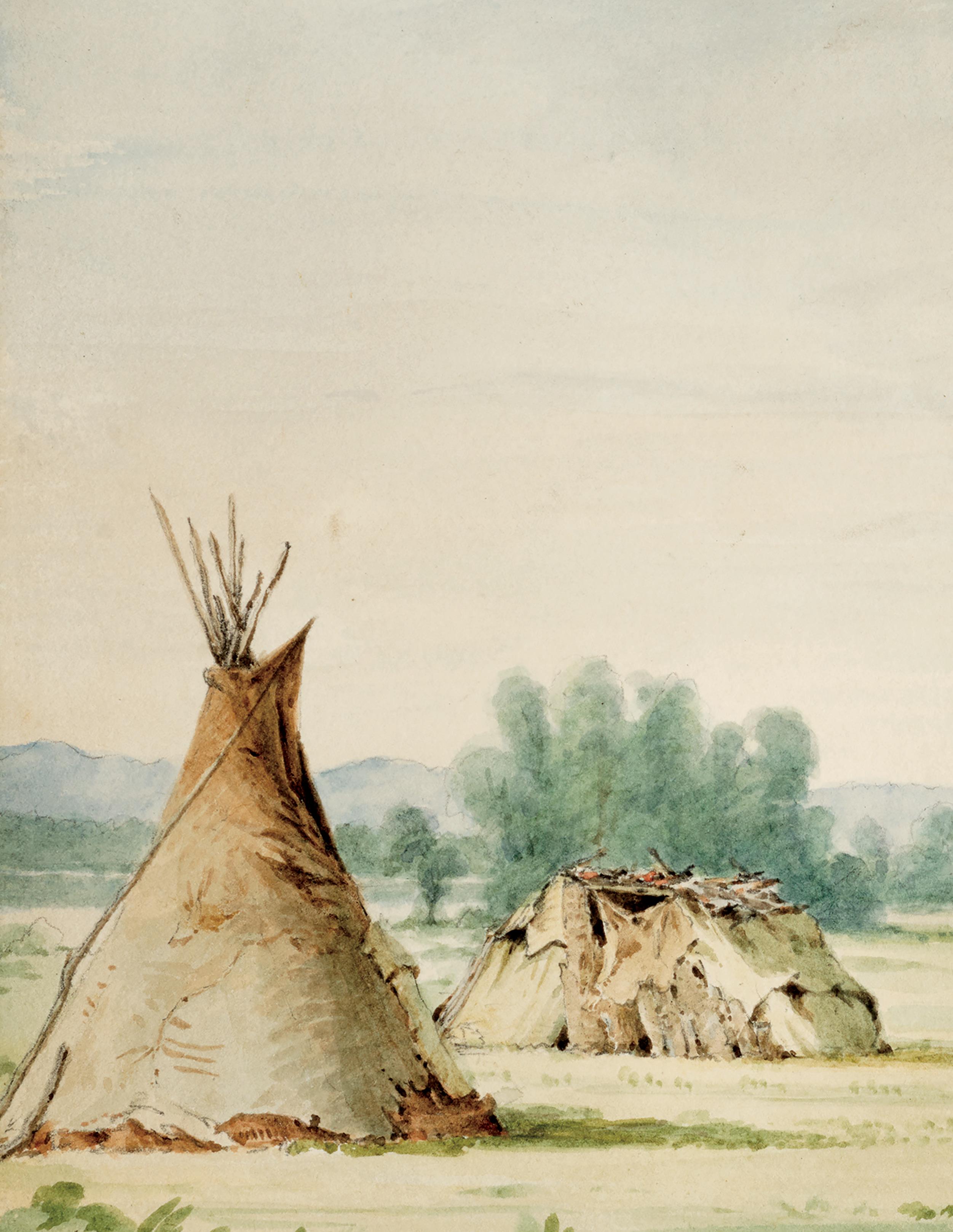
Works from a Private Collecton of Canadian Art
Cowley Abbot is privileged to be entrusted with an important private collecton of Canadian art this spring season.
The strength of the artsts and artworks in this collecton is a rarity, spanning over one hundred and twenty years of Canadian art history. Major representaton of Canadian art movements and periods is present. Beginning with a rare watercolour by Paul Kane, a 1923 masterpiece by the Quebec artst Clarence Gagnon, captvatng works by Beaver Hall artsts Anne Savage and Ethel Seath, and prime canvases by Group of Seven members, such as a 1924 sketch and canvas for Brazeau Snowfeld, Jasper Park by Lawren Harris. Further historical art is well-represented with major oils by Quebec artsts such as Maurice Cullen, Marian Dale Scot, Edwin Holgate, A.Y. Jackson, Robert Pilot, Albert Henry Robinson and Marc-Auréle de Foy Suzor-Coté.
These collectors had a passion for Canadian historical art, acquiring artworks primarily through a prominent commercial gallery. Many of these works are appearing at aucton for the frst tme, having been included in various exhibitons, as well as reproduced in publicatons. These artworks are just a selecton from a private collecton amassed over decades.
We extend our thanks to the community of curators and academics who contributed to the research and writng for this collecton. We thank Mark A. Cheetham, Brian Foss, Michèle Grandbois, Charles C. Hill and I.S. MacLaren.
COWLEY ABBOTT | Live Auction - Spring 2024 43
PAUL KANE
Lodges Near Fort Vancouver, 1847 watercolour titled lower centre, catalogue raisonné no. IV-397a 5.5 ins x 9.25 ins; 14 cms x 23.5 cms
PROVENANCE
Family of the Artist (great-great grandson)
Joyner Fine Art, auction, Toronto, 20-21 May 1987, lot 80 Kenneth R. omson, Toronto G. Blair Laing, Toronto Masters Gallery, Calgary Private Collection
EXHIBITED
Sketches of Indians and Indian Chiefs, Landscapes, Dances, Costumes, &c., &c. by Paul Kane, Old City Hall, Toronto, 9-17 November 1848, no. 235 as Lodges on Prairie, near Fort Vancouver Possibly Catalogue of Sketches and Paintings by Paul Kane, Winnipeg Art Gallery, March–April 1922 as Near Port [sic] Vancouver
LITERATURE
Paul Kane, Landscape Log 1846–1848, Stark Museum of Art, 11.85.4, Manuscript
George Walton, comp. York Commercial Directory, Street Guide and Register, 1833–4, pr. for omas Dalton, York, 1834; quoted by Carole D, Lowrey, “ e Society of Artists & Amateurs, 1834: Toronto’s First Art Exhibition and its Artists,” RACAR: revue d’art canadienne / Canadian Art Review, vol. 8, no. 2 (1981), pages 99–118, on pages 101 (“Coach”), 106 (“Society”)
Harriet Peek Clench, Sketches of Indians and Indian Chiefs, Landscapes, Dances, Costumes, &c., &c. by Paul Kane, Toronto, November 1848, no. 235 (appears incorrectly on page 8 as no. 225 due to a typographical error)
[Paul Kane], Wanderings of an Artist among the Indians of North America from Canada to Vancouver’s Island and Oregon through the Hudson’s Bay Company’s Territory and Back Again , London, 1859
William Henry Giles Kingston, “ e Life and Adventures of Paul Kane,” Kingston’s Magazine for Boys, vol. 2 (1861), pages 70–80, 130–38, reproduced on page 71
John Russell Harper, Paul Kane’s Frontier, Toronto, 1971, Appendix 3, page 320, listed as no. 235 as Lodges on Prairie, near Fort Vancouver
John Russell Harper Fonds, Library and Archives Canada, MG30 D352, vol. 10, le 16, Correspondence, 1972
Canadian Art, May 20th & 21st, 1987, Joyner Fine Art (auction catalogue), Toronto, 1987
Helen Hersh Schuster, “Yakima and Neighboring Groups,” Deward E[dgar] Walker, Jr, ed. Plateau . Vol. 12 of Handbook of North American Indians, Smithsonian Institution Press, Washington, DC, 1988, pages 327–51, on page 336
Ted Binnema and Gerhard J. Ens, eds., Hudson’s Bay Company Edmonton House Journals, Correspondence, and Reports 1806–1821, Historical Society of Alberta, Calgary, 2012, pages 42-43
I.S. MacLaren, Paul Kane’s Travels in Indigenous North America: Writings and Art, Life and Times, McGill-Queen’s University Press, Montreal and Kingston, 2024, page 4:235, no. IV-397a and page 4:257
Paul Kane was born in Ireland and emigrated with his family to York, Upper Canada, as a young boy. His desire to become a painter prompted Michael Kane (1776–1851), his disappointed father, not to arrange for him to be educated. A consequent autodidact, Paul wrote oddly, often phonetically, while advertising himself as a “Coach, Sign and House-painter, 158 King-street” in the 1833–34 edition of the York Commercial Directory (the town took the name of Toronto the next year, by which time it had grown to 9,000 inhabitants). In the early 1850s, Kane told English novelist William Henry Giles Kingston (1814–1880) that for a time in his youth he had “contented himself with covering deal boards, or the walls of the neighbouring shanties with the productions of his hand.” By the age of twenty-four, Kane exhibited his copies of paintings in the exhibition of the edgling Society of Artists & Amateurs in 1834.
Kane spent the later 1830s working in Ogdensburg, New York; Cobourg, Upper Canada; in towns along the Mississippi River; and in a studio in Mobile, Alabama. On 19 June 1841, he sailed from New Orleans for Europe, where he undertook studies on his own in Italy and also visited France and England before returning to Mobile in April 1843.
Nearly two years later, he apparently had amassed su cient funds to undertake a western trip with the aim of painting Indigenous peoples as a prelude to creating his own version of the genre known as an “Indian Gallery,” which contemporaries such as George Catlin (1796–1872) and John Mix Stanley (1814–1872) were undertaking, and that omas Lorraine McKenney (1785–1859) was publishing in hand-coloured lithographs in the three volumes of History of the Indian Tribes of North America (1837–1844), from portraits painted by Charles Bird King (1785–1862), James Otto Lewis (1799–1858), and Henry Inman (1801–1846). In Summer 1845, Kane’s travels took him to Penetanguishene and Owen Sound, on Georgian Bay, and to both a council of Anishinaabe leaders at Saugeen, Lake Huron, and an annual gift ceremony at Manitowaning, Manitoulin Island. is trip extended under Kane’s own steam to Wisconsin Territory in the Fall, where he sketched Menomini, Potawatomi, and Winnebago people, including Oshkosh. His itinerary took this turn after Kane was persuaded at Sault Ste Marie by Hudson’s Bay Company Chief Trader John Ballenden (1810–1856) that the HBC could expedite much wider travels if the artist returned to Toronto for the winter and gained the permission and support of George Simpson, the company’s inland governor.
With the help of a letter from Ballenden to Simpson, Kane secured these and set out again in May 1846. e next thirty months of transcontinental travel to and from the Paci c Ocean made his fame as an adventurer and provided him with the opportunity to draw more than 500 sketches of Indigenous people and their lifeways. With HBC brigades, he became the only nineteenth-century sketcher of Indigenous peoples to cross Turtle Island.
COWLEY ABBOTT | Live Auction - Spring 2024 44
117
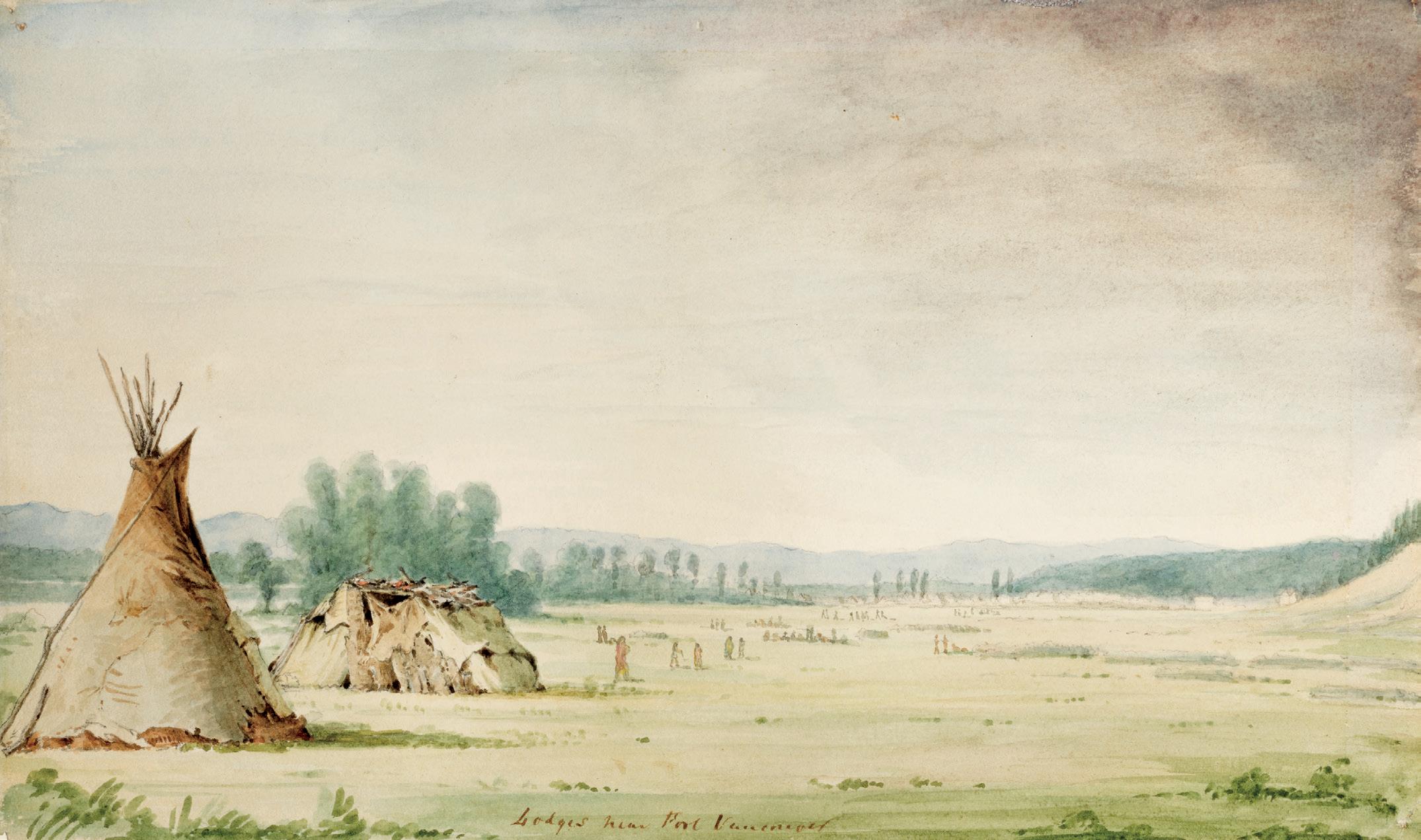
COWLEY ABBOTT | Live Auction - Spring 2024 45
For nine days in November 1848, within a month of his return to Toronto, Kane exhibited 240 nished sketches. He then set about preparing canvases for annual provincial exhibitions, and securing and ful lling commissions. e rst of these, from Simpson, was for ten sketches in oils on paper. ereafter, he worked at executing his “Indian Gallery.” With this genre, he could exploit his paramount talent of portraiture on canvas. By also including many works depicting both peopled and empty landscapes, Kane’s gallery also became a fullblown illustrated atlas.
With most of the 240 nished sketches that Kane exhibited 9–17 November 1848 now lodged in the Stark Museum of Art, Orange, Texas, and a few at the Royal Ontario Museum, it is extraordinary that one of them, Lodges on Prairie, near Fort Vancouver (catalogue raisonné no. IV-397a), has become available. Possibly exhibited in Winnipeg in March and April 1922 under the title “Near Port [sic] Vancouver,” it remained in the Kane family until 1987, when Joyner Fine Art of Toronto auctioned it to collector Kenneth omson (1923–2006). Numbered 235 in graphite by Kane in the centre of the verso and with the sign still intact of the hole made in all four corners so it could be pinned to the wall in the rooms of the building that stood on the southwest corner of King Street East and Jarvis Street until Toronto’s Great Fire razed it 7 April 1849, only ve months later, it was the last of the watercolours on paper in the exhibit (like nos. 1–80, nos. 236–240 were oils on paper).
e setting is Fort Vancouver, on the lower Columbia River (today operated by the US National Park Service as Fort Vancouver National Historic Site across the Columbia from Portland, Oregon). In the Catalogue of Sketches of Indians, and Indian Chiefs, Landscapes, Dances, Costumes, &c. &c. by Paul Kane, which Harriet Peek Clench (1823–1892) compiled for the 1848 exhibit, and which was printed by Hugh Scobie (1811–1853), editor of the British Colonist newspaper and promoter of Kane, the watercolour was for the rst time given the title Lodges on Prairie, near Fort Vancouver. is title is repeated in part in “Lodges near Fort Vancouver,” written by Paul Kane II (1854–1922) in his distinctive hand and black ink along the foot of the sketch, handwriting that his daughter Irene (1887–1982) identi ed as his for the eminent Canadian art historian Russell John Harper (1914–1983) in a letter dated 25 January 1971.
e longer title situates the work on the Fourth Plain or Mill Plain, the largest grassy pasturage at the HBC’s largest post on the Paci c Slope (before operations began being moved to British territory at Fort Victoria). e two buildings in the right background are doubtless outbuildings for the post’s vast farming operations. As military artist Henry James Warre (1784–1853) and other travellers contemporary with Kane recorded, the plain was also used for horse racing. e sketch faces west; if it did not, it would have had to include a representation of Mt Hood beyond the background hills, farther up the Columbia River.
Kane’s deployment of orthogonal lines is conventional, directing the viewer’s line of sight on the left by the tipi, lodge, and human gures, on the right by dark bars of some low vegetation, deep into the plain. Also conventional is the setting of the horizon line three- fths up the left and right edges of the paper. e colours used and the wash of the sky and background hills are typical of Kane’s watercolour palette. e sketch possesses extraordinary aspects as well, for example, in the depictions of Indigenous dwellings and people. e mat-covered lodge is typical of the region, but the tipi, apparently hide covered, was less common. (Perhaps it served as the lodgings of some upriver or

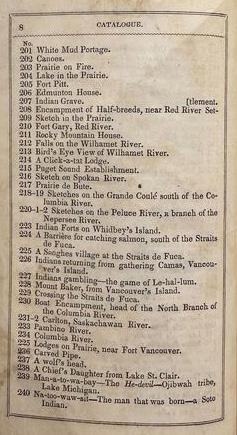
Harriet Peek Clench
Catalogue of Sketches of Indians, and Indian Chiefs, Landscapes, Dances, Costumes, &c. &c. by Paul Kane Toronto, November 1848
Not for sale with this lot
COWLEY ABBOTT | Live Auction - Spring 2024 46

Paul Kane
Detail of Landscape and Portrait Log Page, 1845–1848
pen and pencil on paper; bound in brown leather with metal clasp
12.4 x 8.3 x 1.6 cms
Stark Museum of Art, Orange, Texas
Bequest of H.J. Lutcher Stark, 1965 11.85.4
Not for sale with this lot
transmontane visitors, Fort Vancouver being a prodigious emporium for trade in the 1840s.) It is notable, however, that the lower Columbia River Basin’s Klickitat/Klikatat people did make and use tipis, and so did Yakama: “When people started hunting for bison on the Plains, the skin-covered tepee was adopted. … e Yakima used a three-pole foundation for their tepees.” Lodges near Fort Vancouver exempli es very well the unrivalled ethnohistorical value of many of Kane’s eld sketches.
Perhaps as important as the identi cation of this sketch as one of the 240 that Kane chose to exhibit upon his return to Toronto is the fact that it possesses another ethnographically signi cant curiosity. In his landscape log, Kane’s “Fifty- fth Entry” supplied this description of the sketch in his characteristic spelling: “Indans playing ball in the plane in frunt of Fort Vancouver.” If this had remained the sketch’s title once Kane was back in Toronto, more attention would have focused on the fact that the gures dotting the plain are indeed playing a game. In particular, the largest of them, to the right of the mat lodge and nearest to the viewer, has a stick over his left shoulder. As Robert Boyd of Portland State University has observed, Kane’s wording allows for the documentation that what, on the Prairies and Eastern Woodlands is known as bagattaway/tewaaraton/lacrosse, was played as well on the Paci c Slope, doubtless taken there by transmontane travellers.
Because of an error of omission in its catalogue raisonné, Harper’s Paul Kane’s Frontier (1971) does not include an entry for this watercolour. It is included as IV-397a in the catalogue raisonné of I.S. MacLaren’s Paul Kane’s Travels (2024), volume 4, page 235.
We extend our thanks to I.S. MacLaren, Professor Emeritus, University of Alberta, for contributing the preceding essay. While teaching at the University of Alberta in the Canadian Studies Program, the Department of History and Classics, and the Department of English and Film Studies, Professor Emeritus MacLaren wrote, co-wrote, and edited books and articles about poetry, and the writing and art of explorers, cartographers, and travellers. McGill-Queen's University Press has just issued his four-volume work, Paul Kane's Travels in Indigenous North America: Writings and Art, Life and Times.
$125,000–$175,000
COWLEY ABBOTT | Live Auction - Spring 2024 47
CORNELIUS KRIEGHOFF
The Settler's Log House oil on canvas signed, dated 1859 and inscribed "Quebec" lower right 24 ins x 36 ins; 61 cms x 91.4 cms
PROVENANCE
M. Reford, Quebec
Walter Klinkho Gallery, Montreal Masters Gallery, Calgary Private Collection
EXHIBITED
Exhibition of Paintings by Cornelius Kriegho 1815-1872, National Gallery of Canada, Ottawa; travelling to the Art Association of Montreal, February-March 1934, no. 114 as Settler's Log House, 1856
LITERATURE
Exhibition of Paintings by Cornelius Kriegho 1815-1872, Ottawa, 1934, no. 114, listed page 18 as Settler's Log House, 1856
Marius Barbeau, Cornelius Kriegho : Pioneer Painter of North America, Toronto, 1934, page 52, listed page 107 as Settler's Log House, 1856
David Burnett, Masterpieces of Canadian Art from the National Gallery of Canada , Alberta, 1990, page 26
Dennis Reid, Kriegho : Images of Canada , Toronto, 1999, page 85
During the late 1850s to the early 1860s, Cornelius Kriegho travelled extensively throughout Quebec-from the Ottawa River, to the SaintMaurice River, to Shawinigan Falls, to the Eastern Townships. It was during this period that he achieved great success as an artist, with a proli c output of canvases keenly pursued by buyers. Kriegho understood his audience’s tastes and was versatile in his themes. As David Burnett remarks, “Kriegho ’s years in Quebec were not only the height of his success but were also the time when he produced his nest work.”
Kriegho specialized in genre paintings of the people of Quebec and their lives in the nineteenth century. e Settler’s Log House is a remarkable anecdotal image of the beginnings of settlement in the depths of winter in the Quebec region. While pioneer life was rugged and precarious, it was also a productive and fruitful time for the artist as he recorded the industry and ingenuity of the people. Marius Barbeau, the rst biographer of Kriegho , lists twelve known versions of this subject, painted between 1855 and 1862. According to Barbeau, “ e series of twelve Settler’s Log Houses in Winter (1856-1862) is characteristic of the new settlements of Stoneham and Laval in the Laurentians, where the artist frequently went with Lorette guides and Quebec sportsmen to hunt the moose and the wild deer. It also opens up a chapter in pictorial forest life which has left deep traces in the character of many French-Canadian people.”
A similar variant to this 1856-1859 painting is Settler’s Log House, an 1856 canvas in the collection of the Art Gallery of Ontario. Both canvases depict a house built of round logs on cleared land, with gures of a habitant family in various stages of work. However, e Settler’s Log House has the addition of an outbuilding, along with the main house of round logs. Kriegho has possibly depicted a settlement in its second year on the land, as there is no horse or sleigh, just a sturdy ox and sledge placed squarely as the central focus. e family is represented hard at work with all the gures in the family in the midst of executing their designated tasks. Only the smallest of children remain idle, while still engaging in the cold, winter environment by sledding and playing with the dog. is harmonious family of self-su ciency o ers an image where man lives in unity with nature. Dennis Reid remarks on Settler’s Log House in the collection of the AGO, stating, “A huge pine tree immediately behind the house, seeming to shelter it, exempli es the strength of this ‘natural order’. A brilliant sky celebrates it.” is sentiment of natural order and strength is shared in e Settler’s Log House, as the enormous pine tree in the background solidi es both the composition and the orderly homestead scene. e sumptuous elements of this painting are rendered in Kriegho ’s quintessential masterly hand. From the architectural detail of an early settler’s home, to the aspects of habitant life and the picturesque Laurentian mountains rising in the background, the work is a compositional delight, brimming with immense detail, rich colour and descriptive tone.
Reid shares, “It was two or three years after moving to Quebec before Kriegho returned with any real interest to habitant scenes, but in 1856 a series of ambitious canvases began to appear.” e Settler’s Log House is certainly one of these ambitious canvases representing early settlement in Canada. Kriegho would have encountered these farmsteads up the St. Maurice and Shawinigan Rivers, in the hinterlands up the Montmorency and beyond Lake St. Francis. Kriegho produced digni ed paintings that were romantic in nature, evoking the deep roots of the people he encountered and leaving a view of historical Canada in his vision. Reid argues for “the complex genesis of Kriegho ’s images of Canada”, in which this canvas holds a prominent place. e rarity of a canvas with such an abundance of gures, exquisitely rendered detail and narrative strength is paramount. Brimming with pathos, sentimentality, drama, and, above all, accuracy, Kriegho ’s works are a true record of his surroundings.
$300,000–$400,000
COWLEY ABBOTT | Live Auction - Spring 2024 48 118

COWLEY ABBOTT | Live Auction - Spring 2024 49
ANNE DOUGLAS SAVAGE
Landscape with Skeena Mountains, 1927 oil on board initialed on the reverse 9 ins x 12 ins; 22.9 cms x 30.5 cms
PROVENANCE
Estate of the Artist
Galerie Walter Klinkho , Montreal Kenneth R. omson, Toronto Masters Gallery, Calgary Private Collection
EXHIBITED
Uninvited: Canadian Women Artists in the Modern Moment, McMichael Canadian Art Collection, Kleinburg, Ontario; travelling to the Glenbow Museum, Calgary; the Vancouver Art Gallery and the National Gallery of Canada, Ottawa, 20 September 2022-20 August 2023
LITERATURE
Anne McDougall, Anne Savage: e Story of a Canadian Painter, Montreal, 1977, page 74
Anna Hudson, "Anne Savage" in Sarah Milroy, Uninvited: Canadian Women Artists in the Modern Moment, Kleinburg, Ontario, 2021, page 52, reproduced page 55 as Skeena River with Mountains, 1927
In 1927, Anne Savage travelled with the sculptor Florence Wyle and ethnographer Marius Barbeau to the Skeena River district of British Columbia. Organized by the National Gallery of Canada, the purpose of the trip was to record the totem poles of the area–Savage with paint and Wyle with plaster. Funding for the project came from Duncan Campbell Scott, Deputy Superintendent of the Department of Indian A airs from 1913-1932.
It was a di cult journey. From the train, Savage, Wyle and Barbeau rode on horseback along the edge of the Skeena River to the lodge at Hazelton. e landscape had an impact on Savage, which is exempli ed in the rhythmically painted sketches she executed. As Anne McDougall recalls, “ ey are a collection of small pine boards, 10” x 12”, and show the dusky totems standing against the heavy green-black of the B.C. bush, with turquoise peaks behind. e mountains and pines, although done on a small scale, are monumental in their e ect.”
As Anna Hudson shares, “Savage saw life, not extinction, in the world she discovered in the Skeena River Valley. Yet her primary concerns as an artist were always formal. ‘It is not the poetry of subject matter which is the legitimate country of painting,’ Savage argued, ‘it is the artist’s organization of his canvas.’ For Savage’s generation of artists, this organization hinged on the ‘search for essential beauty within reality’, expressed through compositional design. In her joyful renderings of Gitxsan traditional life, Savage captured that beauty.” e Gitxsan people of Skeena River were well known for defending their traditions and territory. Prior to the trip, Savage did not know anything about Barbeau, and soon found that the Gitxsan people were resistant to his totem pole restoration project. His plan was contrary to their traditional practices and beliefs.
e paintings Savage executed from this pivotal trip were displayed, along with the work of other “moderns”, such as Emily Carr, in the 1927 exhibition, Canadian West Coast Art, Native and Modern at the National Gallery of Canada in Ottawa. Anne Savage valued these Skeena River sketches and kept them together as a complete collection all her life.
$15,000–$20,000
COWLEY ABBOTT | Live Auction - Spring 2024 50
119

COWLEY ABBOTT | Live Auction - Spring 2024 51
MARIAN MILDRED DALE SCOTT
Staircase, circa 1940 double-sided oil on canvas signed on the reverse 24 ins x 18 ins; 61 cms x 45.7 cms
PROVENANCE
Masters Gallery, Calgary Private Collection
LITERATURE
Sarah Milroy, Uninvited: Canadian Women Artists in the Modern Moment, Kleinburg, Ontario, 2021, similar work reproduced page 250 (Stairway, circa 1940, Montreal Museum of Fine Arts)
Montreal painter Marian Mildred Dale Scott acquired her rst formal art training at the Art Association of Montreal between 1917 and 1920. She then became one of the rst women to enroll in the École des beaux-arts de Montréal, before completing her training the following year at the Slade School of Art in London, England. Despite being a mother, wife of a prominent lawyer, poet, and member of Canada’s social democratic movement, Scott continued to pursue her art practice her entire life.
Over the course of her long career, Scott evolved her style from realism to abstraction as she worked to develop her own personal response to the rapidly evolving art world. While her mature work is dominated by abstraction, Scott began her career by painting very structured landscapes and botanical imagery, followed by a series of human faces with strong linear forms. During the Depression the artist depicted the people of Montreal: scenes of labourers, machinery, and urban life. Staircase, dating to circa 1940, is characteristic of Scott’s style during this time. It portrays a quintessential outdoor spiral staircase of Montreal’s urban housing. e architecture, tree and four gures are painted in the artist’s structured approach, as are the quasi-abstract gures Scott depicted on the reverse of the canvas.
e year after Staircase was completed, in 1941, Scott was the subject of a solo show in Boston. Her style shifted again in 1943 when she was commissioned to paint an enormous mural for McGill University to commemorate their ground-breaking research on the endocrine system, executed in a style referencing ‘scienti c symbolism’ or ‘biomorphism’. By the 1960s, Scott’s paintings became increasingly abstract, always maintaining a sense of order, symmetry and repetition.
$20,000–$30,000
COWLEY ABBOTT | Live Auction - Spring 2024 52 120

| Live Auction - Spring 2024 53
COWLEY ABBOTT
ALBERT HENRY ROBINSON
Les Éboulements en haut oil on canvas
signed lower right; titled and dated “ circa 1924 ” on the gallery labels on the reverse 22 ins x 26 ins; 55.9 cms x 66 cms
PROVENANCE
G.L. Robinson
G. Blair Laing, Toronto Masters Gallery, Calgary Private Collection
EXHIBITED
Possibly Royal Canadian Academy of Arts, n.d., as Les Éboulements en haut
LITERATURE
A.Y. Jackson to Clarence Gagnon, 20 March 1927
Arthur Lismer, Canadian Picture Study, Toronto, 1940, page 18
e subject of this painting is a view of Les Éboulements en haut, identi ed by the prominent spire of the Église de l’Assomption de la Sainte Vièrge. e artwork postdates a 1921 trip that A.H. Robinson made with A.Y. Jackson to Cacouna, on the south shore of the Saint Lawrence River: the rst of what became Robinson’s yearly late winter/ early spring sketching expeditions along the Saint Lawrence below Quebec City. But despite his initial 1921 foray along the south shore, Robinson’s preference was for the north shore where, throughout the 1920s and into the early 1930s, his annual trips in Beaupré and Charlevoix counties included visits to Saint-Tite-des-Caps, Baie-SaintPaul, Les Éboulements, Murray Bay (now La Malbaie), Saint-Fidèle and Saint-Siméon.
Robinson and A.Y Jackson both painted oil sketches of Les Éboulements in the early 1920s, painted from a similar vantage point and with the church steeple positioned slightly left of centre. ere are signi cant di erences between the sketches, although these are not su cient to obviate the possibility that they were painted at the same time‒and, indeed, the verso label indicates that Robinson at one point owned the Jackson. Robinson treats the buildings more individualistically, whereas Jackson abstracts them to emphasize their compositional rhythm: a decision that perhaps accounts for his omission of Robinson’s decorative trees and his simpli cation of the foreground fences.
Les Éboulements en haut embodies the qualities for which Arthur Lismer praised Robinson in one of his 1940 Canadian Picture Study booklets: “In Robinson’s pictures we expect no great dramatic subject treatment, nor dynamic lines and sombre tones. His art is the colorful expression of daily life, full of charm, devoid of sentimentality.” e qualities of intimacy and harmonious colour that Jackson associated with the north shore are certainly present in Robinson’s painting: “ e south shore,” wrote Jackson, “... depends more on the contours of its big spaces ... its [sic] too intricate for sketching”. Indeed, part of the attraction of Les Éboulements en haut‒like that of many other 1920s works by Robinson‒resides in the deceptively simple compositional contrasts, in this case between the horizontality of the clustered buildings, and the soft diagonals of the foreground road, posts and snowdrifts. Equally characteristic of Robinson’s technique is the re ned colour scheme, with the subdued purplish tonality of the buildings punctuated by carefully placed areas of warm pink, orange, yellow and white, under a beautifully painted two-toned sky. When comparing Robinson’s oil sketch with the nished canvas version of the same name, the two works appear quite similar. e only striking compositional di erence between the sketch and the canvas is a rearrangement of the sketch’s foreground fences: an alteration presumably made to increase the speed with which the eye travels from foreground to middle ground.
We extend our thanks to Brian Foss, Carleton University Chancellor’s Professor of Art & Architectural History, and co‒curator of 1920s Modernism in Montreal: e Beaver Hall Group for his assistance in researching this artwork and for contributing the preceding essay.
$100,000–$120,000
COWLEY ABBOTT | Live Auction - Spring 2024 54
121

ABBOTT | Live Auction - Spring 2024 55
COWLEY
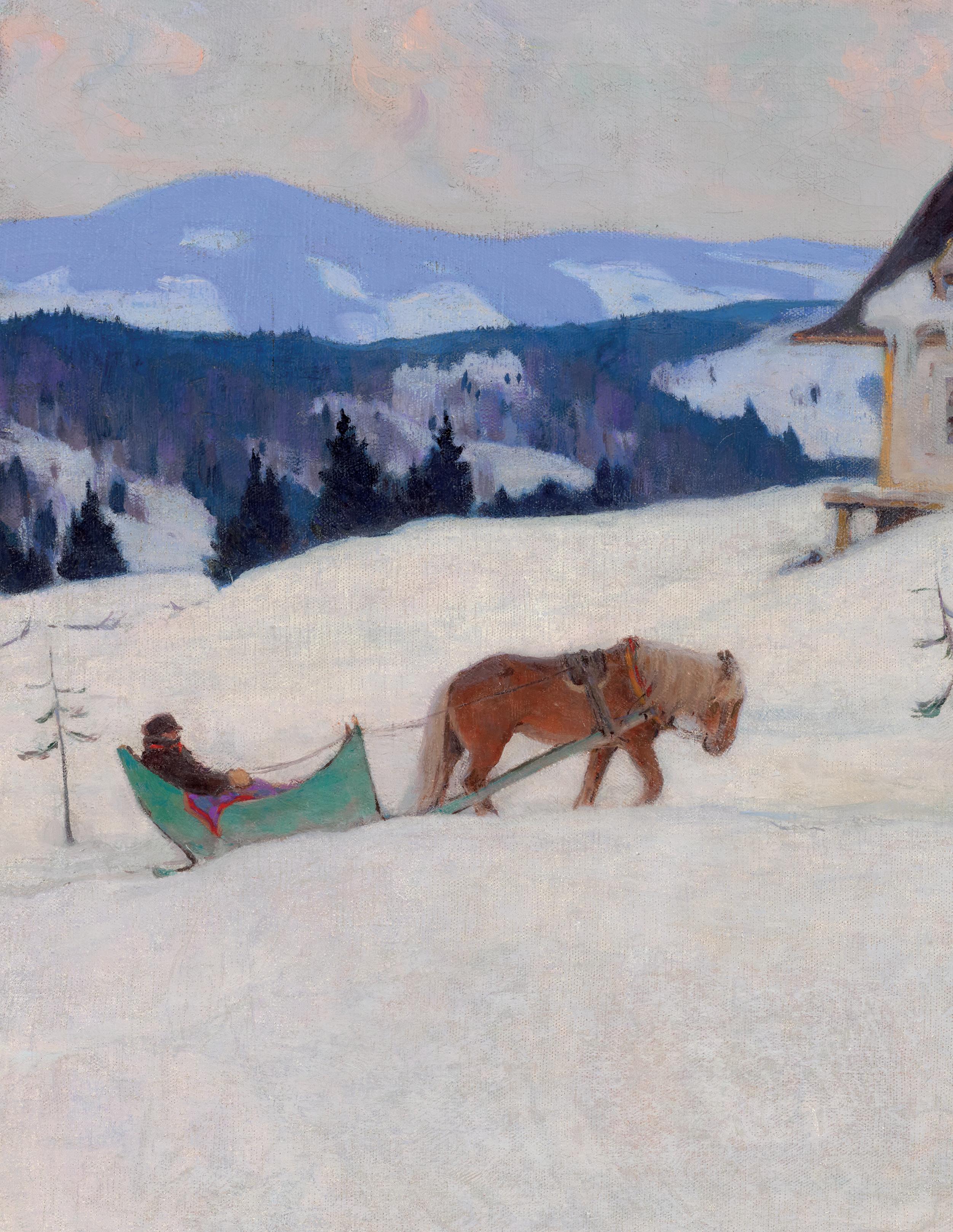

CLARENCE ALPHONSE GAGNON
A Laurentian Homestead, 1923 oil on canvas
signed lower right, Lucile Rodier Gagnon inventory no. 175 29.25 ins x 37.5 ins; 74.3 cms x 95.3 cms
PROVENANCE
Johnston Art Galleries, Montreal
Watson Galleries, Montreal
Mrs. Algernon Lucas, Westmount Masters Gallery, Calgary Private Collection
EXHIBITED
British Empire Exhibition, Canadian Section of Fine Arts, Wembley Park, London, the National Gallery of Canada, 23 April-October 1924 [shown elsewhere in England and Scotland until 21 March 1925], no. 65 as Winter in the Laurentians
Paintings and Sculpture by British, Russian and Canadian Artists: Graphic Art and Photography, Canadian National Exhibition, Toronto, 29 August -12 September 1925, no. 274 as A Laurentian Homestead, Winter 47th Annual Exhibition of the R.C.A., Art Association of Montreal, 19 November-20 December 1925, no. 80
Special Exhibition of Canadian Art, National Gallery of Canada, Ottawa, 21 January-28 February 1926, no. 40
Exposition rétrospective de Clarence A. Gagnon R.C.A., 1881-1942 / Memorial Exhibition Clarence Gagnon, 1881-1942, Musée de la province de Québec, Quebec City, no. 35; travelling to the Art Association of Montreal, no. 35; Art Gallery of Toronto, October-November 1942, no. 39 and the National Gallery of Canada, Ottawa, 16 June 1942-January 1943, no. 35 as Les Éboulements
Clarence Gagnon, 1881-1942: Dreaming the Landscape, Musée national des beaux-arts du Québec, Quebec City; travelling to the National Gallery of Canada, Ottawa and the McMichael Canadian Art Collection, Kleinburg, 7 June 2006-19 August 2007, no. 92
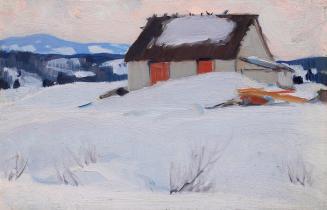
Clarence Gagnon
Barn, Rang de Misère, Baie St. Paul, 1921 oil on wood, 11.8 x 18 cms
e omson Collection, the Art Gallery of Ontario Not for sale with this lot
LITERATURE
Canadian Section of Fine Arts, British Empire Exhibition , Ottawa, 1924, no. 65, page 14
Catalogue of Paintings and Sculpture by British, Russian and Canadian Artists: Graphic Art and Photography, Toronto, 1925, page 40
Forty-Seventh Exhibition of the Royal Canadian Academy of Arts, Montreal, 1925, no. 80, page 12
Clarence Gagnon to Dr. Euloge Tremblay, 8 November 1931
Albert H. Robson, Canadian Landscape Painters, Toronto, 1932, page 194
François Laroche, “Un grand artiste, Clarence Gagnon,” La Revue Populaire, Montreal, vol. 30, no. 3, March 1937, page 36, reproduced page 37 as Petite ferme des Laurentides sous la neige
Exposition rétrospective de Clarence A. Gagnon, R.C.A., 1881-1942 / Memorial Exhibition Clarence Gagnon, 1881-1942, Québec, 1942, no. 35 and no. 39, page 8
Memorial Exhibition of Paintings, Sketches, Etchings, Etc. by Clarence Gagnon, R.C.A., Montreal, 1942, unpaginated Memorial Exhibitions of the Work of Clarence Gagnon, R.C.A., J. W. Beatty, R.C.A., O.S.A., Toronto, 1942, page 6
Memorial Exhibition, Clarence Gagnon 1882-1942, Ottawa, 1942, page 16
Hélène Sicotte and Michèle Grandbois, Clarence Gagnon, 18811942, Dreaming the Landscape, Quebec City/Montreal, 2006, no. 92, reproduced pages 154 and 353
A.K. Prakash, Impressionism in Canada: A Journey of Rediscovery, Stuttgart, 2015, reproduced page 596
Just a century ago, A Laurentian Homestead by the painter Clarence Gagnon publicly appeared in one of the rooms of the prestigious Palace of Arts of the British Empire Exhibition at Wembley, London, the rst major international art event after the First World War. e thirtyfour rooms of the Palace presented exhibitions that primarily focused on the development of art in Great Britain while o ering space to the dominions of South Africa, Australia, Canada, India, Burma, and New Zealand. In this great art salon of the British Empire, Canada had two rooms not far from the entrance hall on the right, where 270 works created by 108 Canadian artists were deployed. “Canada is having the opportunity of measuring her art for the rst time against that of the other British Dominions at the British Empire Exhibition , and whatever may be the relative verdict, Canada will at least show that she possesses an indigenous and vigorous school of painting and sculpture, moulded by the tremendously intense character of her country and colour of her seasons.” e verdict was clear: British critics acclaimed the works of the Canadian section. e Times of London conceded that “[…] it is here in particular that the art of the Empire is taking a new turn—at any rate, there can be no question that Canada is developing a school of landscape painters who are strongly racy of the soil.” Because it had asserted its own style, young Canadian painting centered around Tom omson, members of the Group of Seven, Morrice, Walker, Gagnon and several other painters, thus gaining fame internationally in 1924 at Wembley.
COWLEY ABBOTT | Live Auction - Spring 2024 58
122

Clarence Gagnon was no stranger to this success. He exhibited three paintings and six etchings. He also acted as a selection jury member, sponsored by the National Gallery of Canada and its director, Eric Brown. e eight men and women of the jury, all members or associate members of the Royal Academy of Canada, had opted for a bold selection, defying the dictates of outdated academicism to highlight the landscapes of the immense and diverse territories of the nine Canadian provinces. e splendid cover of the catalogue, decorated with a drawing by J.E.H. MacDonald, complemented the expressiveness of Canadian landscape scenes that visitors would discover while exploring the EE and FF rooms of the Palace of Arts.
In 1924, Clarence Gagnon had a ourishing career. e painter and engraver had been living in Paris for twenty years, where he had his studio at 9 rue Falguière in the 15th arrondissement. His journey is made up of more or less extended stays in France and Canada. His works were distinguished in Paris, in the Salons of French Artists and of the National Society of Fine Arts, in the special exhibition dedicated to him by the Galerie Adrien Reitlinger in 1913. ey circulated in London, Chicago, New York, Toronto and Montreal. As a successful etcher and painter of the Canadian winter, Gagnon attracted the admiration of collectors and the respect of authorities in the Canadian art world. During his fourth stay in Quebec, from 1919 to 1924, while he lived in Baie-Saint-Paul with his young wife Lucile Rodier, we recognize his qualities as an emissary of Canadian painting abroad. Also, he is entrusted with participating actively in organizing the two British Empire Exhibitions at Wembley (1924-1925) and then the Canadian Art Exhibition at the Musée du Jeu de Paume in Paris (1927).
COWLEY ABBOTT | Live Auction - Spring 2024 59
e ve years he spent in Quebec were fruitful on several personal and professional levels for Gagnon. Baie-Saint-Paul is a place of intense creation, measured by the most signi cant number of sketches the artist created in Charlevoix. During this extended stay, Gagnon had the opportunity to travel through the entire territory, on foot in summer, on skis in winter, and sometimes aboard a boat going down the river. His painter friends Edwin Holgate, A.Y. Jackson and Albert Robinson came to join him in March 1923. is period also dates to the collaborative projects that he undertook with the artisans of the village, as well as his renunciation of commercial colours in favour of an oil paint manufactured according to his own recipes. e remarkable landscape A Laurentian Homestead , painted in 1923, is imprinted by research and discoveries tied to this stay in Charlevoix, among his happiest memories. In a letter from 1931, Gagnon writes: “I constantly delved into my memories of the bat, which were probably the happiest days of my life… the time that I spent there will leave an imprint on my works that, I hope, will survive long after the worms have disposed of the rest of me.”
A Laurentian Homestead is inspired by a sketch in e omson Collection at the Art Gallery of Ontario. anks to the latter, executed in 1921, we can identify the place that inspired the painter, known as the Rang de la Misère, located on the outskirts of Les Éboulements, one of the most picturesque villages of Charlevoix. Perched at an altitude of 365 meters, it o ers an extraordinary view of the St. Lawrence River and Île aux Coudres. On the other hand, poor harvests caused by recurring frosts and violent winds had so impoverished the inhabitants of this area in the 19th century that it was nicknamed “Misère” or misery. e Rang de la Misère was known to the famous ethnologist Marius Barbeau (1883-1969), where, in 1916, he discovered an unexpected wealth of music and French oral literature. A master in executing small landscape compositions and scenes from the Quebec region, Gagnon has captured a view of the mountainous location on his small wood panel. e rewood next to the thatched-roof barn alludes to a human presence. Only the two orange-vermilion doors and a few loose planks on the right warm the silent, frozen nature.
Two years later, when the painter recreated the sketch to a surface six times larger, he accentuated the impression of a low-angle view, granting two-thirds of the composition to the white mass of the uneven terrain. Gagnon raised the summit of the Laurentian mountains in the background. He imbues it with a completely di erent experience of the land by adding a draft horse, pulling a well-bundled inhabitant in his cart along the path marked with tree branches stuck in the snow. Compared to the sketch, he assigned a secondary role to the barn and instead emphasized the farmhouse, typically French-Canadian with its gable roof, its chimney, its paned windows and the wraparound porch.
With the smoke billowing into the sky, the icicles formed at the roof’s edge, together with the accents of orange and red, make it a comforting haven of warmth in the depths of winter.
Art critics and columnists in America and Europe have praised Clarence Gagnon’s snow scenes. e liveliness and purity of the colours that the painter meticulously developed according to Old Master traditions earned him the Trevor Prize from the Salmagundi Club of New York in 1923, for his painting Winter in the Laurentians, Quebec, 1922 (Private Collection). A Laurentian Homestead portrays the mountain air covered in white clouds under a slightly hazy afternoon sky. Even if Gagnon only reserved a fth of the composition for celestial movements, they animate the vast snow-covered surface with luminous nuances.
Of the three paintings exhibited by Clarence Gagnon at Wembley in 1924, A Laurentian Homestead is the most bare in formal terms. e work had been hung in one of the Canadian art rooms a short distance from his two other winter scenes, A Quebec Village Street, Winter, 1920 ( e omson Collection at the Art Gallery of Ontario) and Heating the Oven, Winter Scene, 1923 (Private Collection). eir character, decorative motifs and very stark colours contrasted with the peaceful mood of rural life in Les Éboulements.
Following the exceptional showing in Wembley, A Laurentian Homestead enjoyed great visibility in several Canadian exhibitions in Toronto, Montreal and Ottawa before disappearing from public life for almost two decades. It was reproduced in La Revue Populaire in March 1937, illustrating an article by François Laroche, an unconditional admirer who viewed Gagnon as one of the founders of the modern school of landscape in Canada. In his article, the author notes the incomparable charm and poetic softness of the painter’s luminous canvases, describing: “their qualities of sobriety, sensitive observation, intelligence and taste, their decorative beauty and their originality”. A few years later, A Laurentian Homestead was featured in a 1942 exhibition to commemorate Gagnon, which circulated in the major museums of Quebec and Ontario. Only sixty-two years later did the painting reemerge for public view in 2006 as part of the vast retrospective covering the remarkable legacy of Clarence Gagnon, an essential gure in the history of Canadian art.
We extend our thanks to Dr. Michèle Grandbois, Canadian art historian, for her assistance in researching this artwork and contributing the preceding essay.
$400,000–$600,000
COWLEY ABBOTT | Live Auction - Spring 2024 60

ROBERT WAKEHAM PILOT
Quebec Winter oil on canvas
signed lower left; signed and dated 1925 on the reverse 15.25 ins x 18 ins; 38.7 cms x 45.7 cms
PROVENANCE
Walter Klinkho Gallery, Montreal Masters Gallery, Calgary Private Collection
LITERATURE
A.K. Prakash, Impressionism in Canada: A Journey of Rediscovery, Stuttgart, 2015, pages 621 and 632
Similar to his stepfather Maurice Cullen, Robert Pilot's most renowned work focuses on the villages and towns of Quebec and eastern Canada. Pilot’s poetic compositions share the same search for identity that motivated J.W. Morrice, Clarence Gagnon and Albert Robinson - his Quebec predecessors and counterparts. Pilot preferred
to paint the landscape of Quebec, which he often frequented, recording the local conditions of the time and of people co-existing with nature. A.K. Prakash, describing the work for which Pilot received accolades throughout his life, says that through his work, the painter “o ered his own interpretation of the Canadian landscape, one he handled with great visual clarity and sharp focus. Although he painted many charming subjects throughout Canada, Spain, Morocco, England, France, and Italy, it was the countryside and the urban life of old Quebec that were his preferred subjects – as they had been for Cullen, Suzor-Coté, and Gagnon before him.”
e warmth and gentle brushstrokes of Quebec Winter are synonymous with the celebrated painter’s ability to depict the province’s landscape with great charm and artistry. e painting was completed shortly after Pilot returned from an extended stay in France. His work took on Impressionist in uences after he visited the artists’ colony at Concarneau. e many pastel grey, blue and pink tones of the sky and snow in Quebec Winter recall the work of the European Impressionists; however, Pilot has applied these methods to a wintry subject that remains quintessentially Canadian.
$15,000–$20,000
COWLEY ABBOTT | Live Auction - Spring 2024 61
123
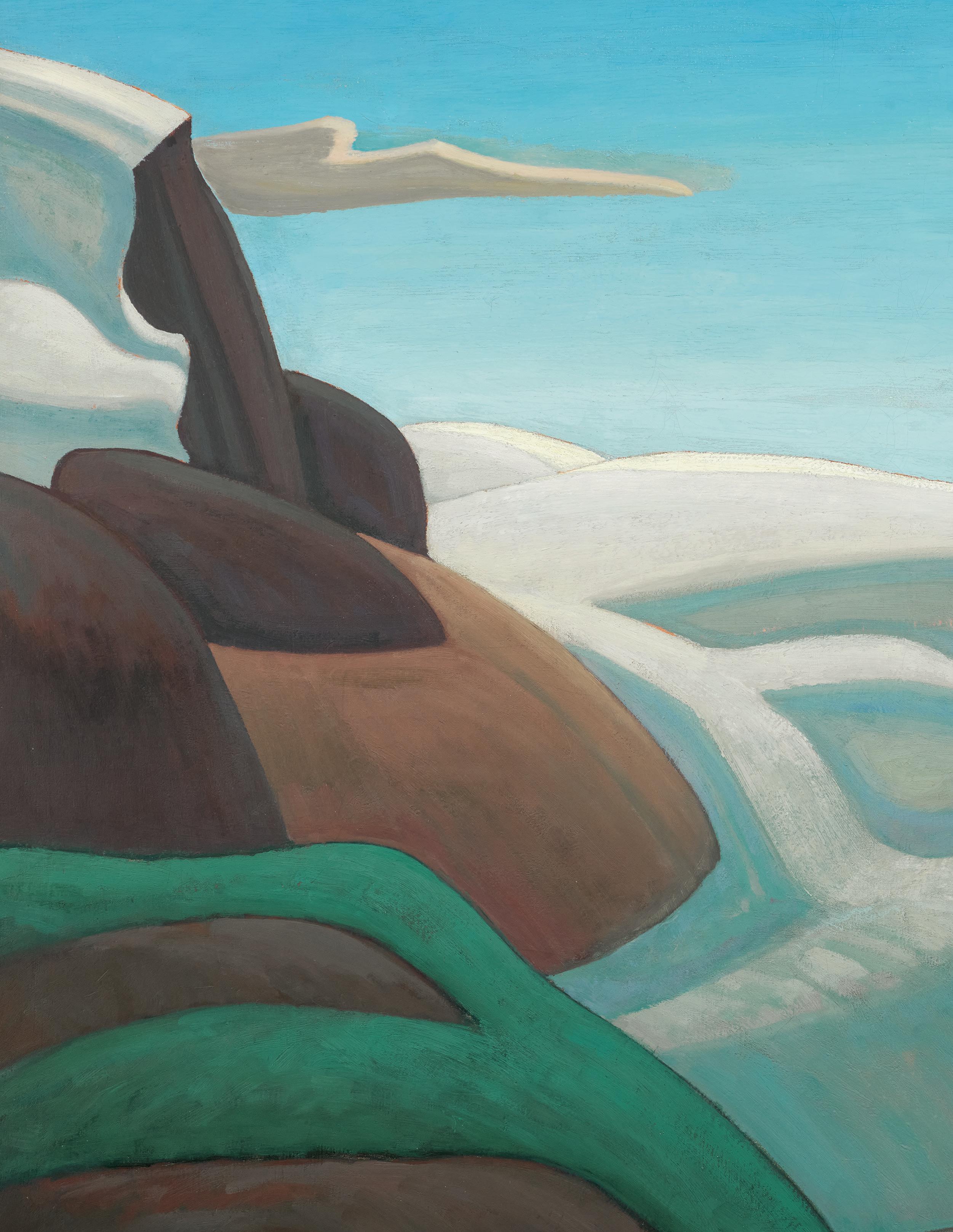

LAWREN STEWART HARRIS
Brazeau Snowfeld, Jasper Park. Mountain Painting XII oil on canvas
signed and dated 1924 lower right; numbered 190 upon the "Lawren Harris LSH Holdings Ltd." stamp and numbered 5015 upon a National Gallery of Canada stamp on the reverse; inscribed with the artist's name, the title and "Mountain Paintings XII" on a label a xed to the reverse 48 ins x 59.5 ins; 121.9 cms x 151.1 cms
PROVENANCE
Collection of the Artist LSH Holdings Limited, 1963
Mira Godard Gallery, Toronto/Calgary Private Collection, Vancouver Roberts Gallery, Toronto e Art Emporium, Vancouver Corporate Collection, Toronto
Galerie Walter Klinkho , Montreal, 1998
Joyner Fine Art, auction, 21 November 2000, lot 82 Kenneth R. omson, Toronto Masters Gallery, Calgary Private Collection
EXHIBITED
Group of Seven Exhibition of Paintings, Art Gallery of Toronto, 9 January-2 February 1925, no. 19
Lawren Harris Retrospective Exhibition of his Paintings, 1910-1948, Vancouver Art Gallery, 1-20 March, 1949, no. 49 as Brazeau Snow eld, Rocky Mountains
[Lawren Harris], Edmonton Museum of Art; travelling to Calgary Allied Arts Centre, March-June 1953
Lawren S. Harris: Urban Scenes and Wilderness Landscapes, Art Gallery of Ontario, Toronto, 1978, no. 146

LITERATURE
E.P. Taylor Library & Archives, Art Gallery of Ontario, Toronto: AGO Archives: Exhibitions Curatorial Box 23, File 1: Harris Retrospective 1948 and A.5.8 – Private Works of Art, Box 3, le 1. Photographs of Canadian Art, Box 6, File 30, Library and Archives, National Gallery of Canada, Ottawa: 7.1-Correspondence with Artists – Harris; 1.71-H Gifts-Bequests-Harris; 5.5-Harris Exhibition 1948, and Curatorial File, L.S. Harris January aw Edge of Town (acc. 5005)
Bess Housser, “In the Realm of Art, Impressions of the Group of Seven”, e Canadian Bookman , February 1925, page 33
e Paintings of Lawren Harris Compiled by Mrs. Gordon Mills, JulyDecember 1936 (Library and Archives, National Gallery of Canada) as Brazeau Snow eld, Jasper Park Mountain Painting XII
“Canadian Art Given Gallery,” London Free Press, 22 April 1950
Carl Weiselberger, “Lawren Harris Donates 12 Paintings to Gallery,” Ottawa Journal, 22 April 1950
R. W. Hedley, “Paintings by Lawren Harris Displayed in Museum of Arts,” Edmonton Journal, 16 March 1953
“Harris Paintings Exhibit Opens,” Calgary Herald , 6 June 1953
Bess Harris & R.G.P. Colgrove, Lawren Harris, Toronto, 1969, reproduced page 69, dated 1926
Jeremy Adamson, Lawren S. Harris: Urban Scenes and Wilderness Landscapes, 1906-1930, Toronto, 1978, pages 167-170, reproduced page 171
Peter Larisey, Light for a Cold Land: Lawren Harris’s Work and Life – An Interpretation, Toronto, 1993, pages 103, 106
Lisa Christensen, A Hiker’s Guide to the Rocky Mountain Art of Lawren Harris, Calgary, 2000, page 132 note 43
Joyner Canadian Art, Toronto, 21 November 2000, lot 82, unpaginated, as Brazeau Snow eld, Jasper Park. Mountain Paintings XII
Paul Duval, Lawren Harris, Toronto, 2015, page 392, reproduced on dedication page
In 1924 Lawren Harris and A.Y. Jackson travelled to Jasper Park in the Rocky Mountains and sketched at Maligne Lake and in the Tonquin Valley. Harris was so enthused by the experience that in one day he painted ve sketches of Coronet Mountain and the Brazeau Ice eld (see lot 125). is was the beginning of Harris’ life-long fascination with the mountains and he exhibited ve mountain canvases with the Group of Seven at the Art Gallery of Toronto in January 1925, including his famous painting Maligne Lake, Jasper Park (National Gallery of Canada). Eric Brown, the National Gallery’s Director, wrote to Harold Mortimer Lamb in Vancouver on 17 January 1925, “I have just seen the Group of Seven show in Toronto. It contains many pictures done in the Rockies last year and is excellent, and much the most interesting show of modern Canadian painting ever seen.”
e city’s critics were startled and delighted by the new subject matter. Fellow Arts and Letters Club member Augustus Bridle wrote in the Toronto Star Weekly on 10 January 1925. “One might say that the whole show is an expanse of lakes and foothills between one Mount Harris and another Mount Harris…. He has put these piles of granite into a powerful mental press and squeezed out of them every common ocular property of mountains leaving only their cold austere sublimity. He does not give you a mountain, but the platonic idea of a mountain, a mathematical in nite series of mountain impressions, something gigantically geometrical and impressively pyramidical, if not veridical, a real brain storm amongst mountains.”
Private Collection
Lisa Christensen, A Hiker’s Guide to the Rocky Mountain Art
Not for sale with this lot
COWLEY ABBOTT | Live Auction - Spring 2024 64
124
Lawren Harris
Coronet Glacier Near Maligne Lake , 1924 or 1926 oil on panel, 27.1 x 35.1 cms
of Lawren Harris (Calgary, 2000, page 54)

ABBOTT | Live Auction - Spring 2024 65
COWLEY
Fellow artist Bess Housser was also impressed by the exhibition, writing in e Canadian Bookman , “To walk into the Grange Gallery with the Group of Seven on its walls is to nd vigor, conviction and an exuberance of vitality pouring toward you. e air is vibrant with courage and the will-to-do. at out-pouring vigor, that vitality, that will and owing power, is the essence of the Canadian spirit. … Lawren Harris … uses locality for the expression of an inner attitude, mood or posture. … ere is a strange quality of rest in the lightbathed forms and vibrant skies even while they seem to vibrate on a high note like a top spinning at full speed. In ‘Brazeau Snow Field, Jasper Park,’ locality has been almost entirely discarded to accentuate the sense of peace of that place, which is beyond the whirling rhythms of activity. Here the onlooker and participator is left curiously free. ere seems no intrigue of line or color to draw him into the work itself. ere are no accented spots into which he needs must travel. It is a gesture, a salutation. Peace is held in the folds that are almost sculpted over the dark rock forms and in the poised vibrancy of the sky.”
Two canvases of the Brazeau Glacier were developed from three, and possibly all ve, of the sketches Harris painted that day. e canvases were Mountain Glacier, Mountain Paintings VIII and Brazeau Snow eld, Jasper Park. Mountain Painting XII. e sketch Coronet Mountain, Brazeau Glacier (see lot 125) grew out of the sketch South End of Maligne Lake (McMichael Canadian Art Collection) and in a third sketch, Coronet Glacier, Near Moraine Lake (Private Collection), Harris further simpli ed the forms of rocks and ice. A band of lighter brown crowns the foreground ledge and, at the left, the green foliage and snow and rocks have been abstracted and two conical rocks added by the bottom edge. e peak upper right is further cropped and three small clouds oat across the sky. is latter sketch was one of three sketches of the Coronet Glacier that Harris selected for inclusion in his retrospective exhibition at the Art Gallery of Toronto in October 1948, but this was the only one exhibited, as catalogue number 129, “One of ve sketches made on one day”. A photograph of this latter work was sent to the National Gallery on 3 December 1948.
e composition of the canvas, Brazeau Snow eld, Jasper Park , being o ered here, is largely de ned in this latter sketch but with subtle modulations. In the canvas the right foreground is painted in green crowned with a band of lighter, mauve-grey brown. e two conical rocks lower left are more prominent, pointing to the abstract green form that echoes the green lower right. e swelling rhythm of the rocks centre left is repeated in the adjacent shadow and the complex linear pattern of the glacier’s sensuously painted whites, blues and greens looks forward to Harris’ later abstracts. e abruptly cropped peak upper right has become a sheer wall of partially snow-covered rock further compressing the space and creating a dramatic tension between the three elements framing the central rocks, now devoid of snow.
Brazeau Snow eld, Jasper Park was stored in the Studio Building when Harris left Toronto for New Hampshire in 1934 and subsequently at the Art Gallery of Toronto where it was inventoried and photographed in September 1947 in preparation for Harris’ retrospective exhibition in October 1948. In that photograph no clouds appear in the sky. e canvas was not included in the Toronto exhibition but was sent to Vancouver for inclusion in the reduced Harris retrospective at the Vancouver Art Gallery in March 1949. e oil sketch Coronet Glacier, Moraine Lake included in the Toronto retrospective was also sent to Vancouver and was possibly one of the twenty untitled sketches in the 1949 exhibition.
In preparation for his Toronto retrospective Harris wrote to the gallery’s curator, Martin Baldwin, in March 1948. “I am very anxious to have three weeks or more before the exhibition opens to retouch some of the paintings, clean some of them, repaint or reglaze some of the frames, etc. ere are also a number of corrections I have had in mind for years and now is my chance to make ‘em….” He continued in a subsequent letter, “this would be minor in every case – changes I have had in mind for years. I have made changes on several of the older canvases which I have here and unless people were told they had been repainted in parts no one would know it. In every case the painting has been improved but this has been done in terms of the day the painting was painted.”
Seeing the oil sketch Coronet Glacier, Moraine Lake and the canvas Brazeau Snow eld, Jasper Park for the rst time in almost fteen years, it was possibly at this time that Harris incorporated into the canvas two of the three clouds depicted in the sketch. In the canvas these two clouds create a dynamic energy across the upper part of the composition, in an area Harris must have found empty in its original form.
Following the closure of the Vancouver show Harris o ered Brazeau Snow eld, Jasper Park and eleven other canvases as a donation to the National Gallery of Canada. Negotiations concerning the gift continued until 1960 when Harris nally donated ten paintings. Brazeau Snow eld, Jasper Park was withdrawn and was retained by the artist until his death.
We extend our thanks to Charles Hill, Canadian art historian, former Curator of Canadian Art at the National Gallery of Canada and author of e Group of Seven‒ Art for a Nation , for his assistance in researching this artwork and for contributing the preceding essay.
$2,000,000–$3,000,000
COWLEY ABBOTT | Live Auction - Spring 2024 66
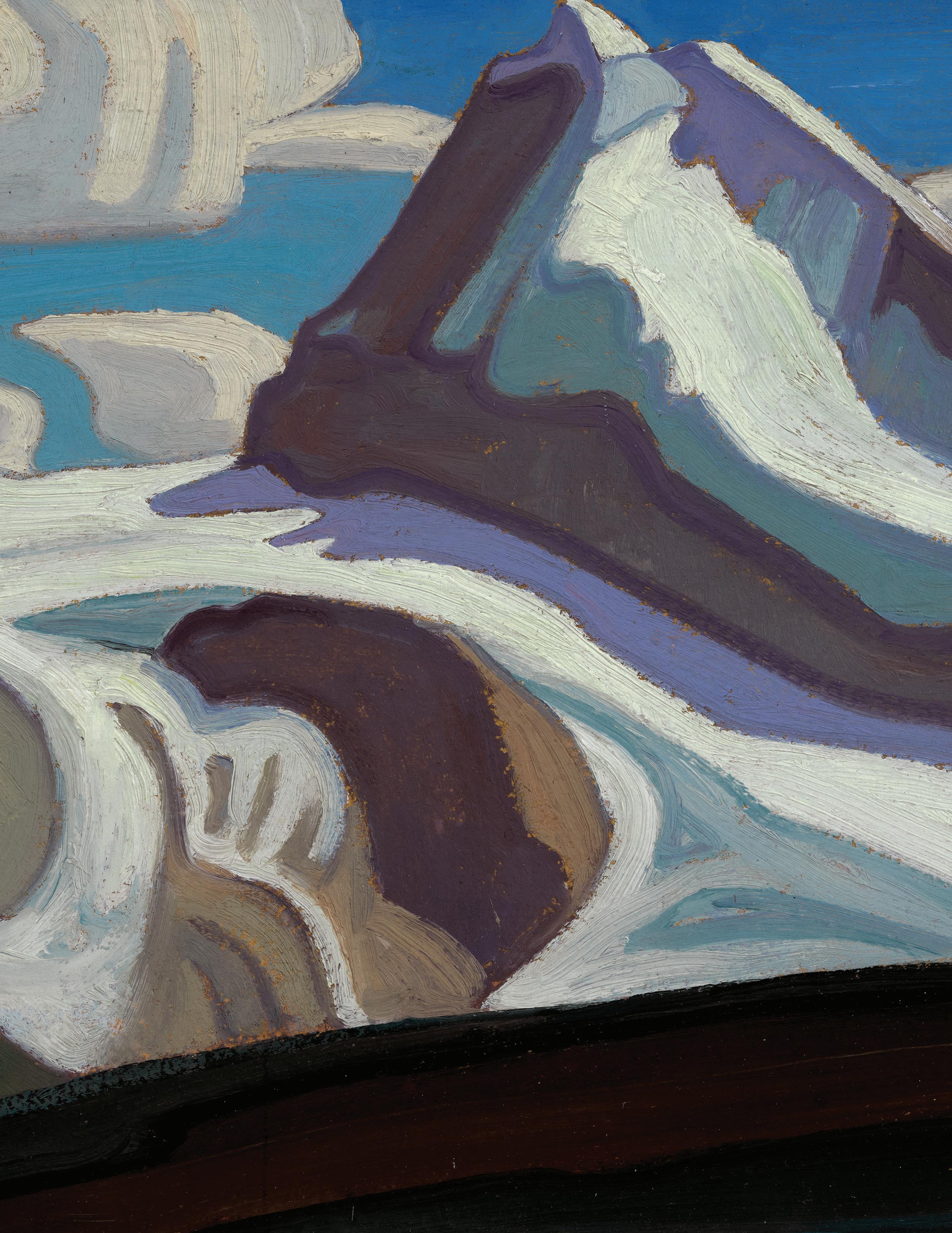
LAWREN STEWART HARRIS
Coronet Mountain, Brazeau Glacier, 1924 oil on panel signed twice, titled, inscribed "Not for Sale" (twice), "Bess Harris Collection", "9" (circled), "78", "one of 5 sketches made in one day in July 1925 or 6" with a cross in a circle in black ink on the reverse 10.75 ins x 13.75 ins; 27.3 cms x 34.9 cms
PROVENANCE
Collection of the Artist
Bess Harris, Vancouver Laing Galleries, Toronto
Jennings D. Young, Toronto, circa 1966
Kenneth R. omson, Toronto
Private Collection
Masters Gallery, Calgary, 2020
Private Collection
EXHIBITED
e Jennings Young Collection , Tom omson Memorial Gallery, Owen Sound, 20 September–15 October 1967, no. 21 as Brazeau Glacier and Coronet Mountain, 11 x 14 ins, circa 1925
Small Landscapes by the Group of Seven From the Collection of Mr. Jennings Young, McMaster University Art Gallery, Hamilton, 23 February–16 March 1986, no. 7 as Brazeau Glacier, 10 5/8 x 10 ½ ins, [sic] 1925-1926
Lawren Harris: Works from Private Collections, Masters Gallery, Calgary, 22 October-1 November 2016
LITERATURE
A.Y. Jackson, "Artists in the Mountains,” e Canadian Forum , (January 1925), pages 112-114
Lisa Christensen, A Hiker’s Guide to the Rocky Mountain Art of Lawren Harris, Calgary, 2000, pages 50-54, 132-133 notes 43-62, 128-129, 132, notes 43-44
In the summer of 1924 Lawren Harris and A.Y. Jackson travelled to Jasper Park and painted at Maligne Lake and in the Tonquin Valley. is was Harris’ rst expedition to the Rockies and he was enthralled, initiating his lifelong fascination with the mountains. In January 1925 Jackson described their experiences in the pages of e Canadian Forum. “We camped at the south end of Maligne Lake on a wide delta of gravel which Coronation Creek is hurling out into the lake. … [U]p a valley we could see the great Brazeau ice elds, and, … we climbed above timber … and looked across great rolling pastures to the glaciers that almost cover Mount Henry McLeod and Coronet Peak.”
In her important book, A Hiker’s Guide to the Rocky Mountain Art of Lawren Harris, Lisa Christensen illustrated two Harris oil sketches depicting the region between Coronet Glacier and Mount Henry MacLeod: South End of Maligne Lake in the McMichael Canadian Art Collection and Coronet Glacier Near Maligne Lake (Private Collection) (see lot 124).
Harris had originally identi ed three sketches of Coronet Glacier, painted on 10 ½ x 13 ¾ inch panels, for inclusion in his 1948 exhibition: 8. Coronet Glacier, Jasper; 9. Coronet Mountain & Glacier; and 10. Coronet Glacier. e oil sketch presented here, Coronet Mountain, Brazeau Glacier, was number nine on that list (as marked on the verso) and is one of the ve sketches Harris painted in one day, as he again inscribed on the back of this sketch and on the back of the McMichael sketch.

Lawren Harris
South End of Maligne Lake , 1924 oil on wood panel, 27 x 35.2 cms
McMichael Canadian Art Collection
Gift of Mrs. Lawren Harris
Not for sale with this lot

Hans Jensen after Lawren Harris
Mountain Glacier. Mountain Painting VIII in The Paintings of Lawren Harris
Compiled by Mrs. Gordon Mills, July-December 1936
Lawren S. Harris fonds (1:3), Library and Archives
National Gallery of Canada, Ottawa
Not for sale with this lot
COWLEY ABBOTT | Live Auction - Spring 2024 68
125

Coronet Mountain, Brazeau Glacier is key to the understanding of the evolution of two canvases by Harris depicting the Brazeau Ice elds: the unlocated canvas, Mountain Glacier, Mountain Painting VIII, as well as Brazeau Snow Field, Mountain Painting XII, the latter shown in the January 1925 exhibition of the Group of Seven and also o ered in this sale.
In the McMichael sketch, the open foreground allows an expansive view of the valley, painted in rich browns and dark greens, and of the glacier and two mountain peaks. e snow on the upper peaks is bordered by blue shadows, and yellow-edged clouds animate the blue sky.
In Coronet Mountain, Brazeau Glacier, Harris has zoomed in on the glacier. A dramatic diagonal dark brown and green ridge de nes the right foreground leading to the rich green rocks lower left. e broadly painted avalanche of snow and ice is framed by a single peak at the right, the shadows painted with a uid brush in mauve-blues and bluegreens, with greenish-brown snow-covered rocks at the left. Heavy sculpted grey and white clouds move across the sky. Both sketches include the harp-like pattern of snow on the central rocks.
Coronet Mountain, Brazeau Glacier served as the source for an unlocated canvas titled Mountain Glacier, Mountain Painting VIII, measuring 48 x 60 inches and known only from a drawing by Hans Jensen in Doris Mills’ 1936 inventory of the unsold paintings Harris left in Toronto when he moved to Dartmouth, New Hampshire in 1934. e snowcapped rock forms at the left and sweep of snow and ice around the central rocks closely follow the design of this oil sketch, though he included the twin peaks depicted in the McMichael sketch. e clouds appear to retain the solid density and patterning of the clouds in the sketch o ered here.
e year 1924 marked a turning point in Lawren Harris’ career. He discovered subject matter that would obsess him for decades and, the following year, possibly to accommodate the scale of his new subject matter, he began to paint on larger panels that were approximately 12 x 15 inches.
We extend our thanks to Charles Hill, Canadian art historian, former Curator of Canadian Art at the National Gallery of Canada and author of e Group of Seven‒ Art for a Nation , for his assistance in researching this artwork and for contributing the preceding essay.
$300,000–$400,000
COWLEY ABBOTT | Live Auction - Spring 2024 69
ROBERT WAKEHAM PILOT
Cabbies, Old Montreal oil on board
signed lower right, titled and dated 1926 to a label on the reverse 6.25 ins x 8.75 ins; 15.9 cms x 22.2 cms
PROVENANCE
Woods Estate, Ottawa
A.K. Prakash & Associates, Inc., Toronto Peter Ohler Fine Art, Vancouver Masters Gallery, Calgary Private Collection
LITERATURE
Magazin'Art (Spring 1994), reproduced page 112
A.K. Prakash, Impressionism in Canada: A Journey of Rediscovery, Stuttgart, 2015, pages 621, 632
Soon after Robert Pilot’s return to Canada following the First World War, the Montreal painter was invited by A.Y. Jackson to include two of his works in the Group of Seven’s rst exhibition in 1920. Following the exhibition, A.K. Prakash explains that Pilot declined “to formalize an association with these artists. Like Maurice Cullen, he di ered philosophically from the group’s nationalistic approach to art. [Pilot] preferred to paint inhabited places rather than the untamed wilderness, so he di ered philosophically from the group’s nationalist approach to art.” He was given the opportunity to study in Paris in 1920. ere, he enrolled at the Academie Julian and exhibited in the Paris Salon in 1922. Upon his return to Canada, he was elected an associate of the Royal Canadian Academy of Arts in 1925.
Cabbies, Old Montreal is one of Pilot’s quintessential inhabited scenes of Quebec, depicting a bustling scene of horse-drawn cabs in Montreal’s Old Port. “He generally excluded the new world from his record–there is, for example, a noticeable absence of automobiles in his compositions,” notes Prakash. “Rather, his paintings convey a precise image of a world that was soon to disappear.”
Cabbies, Old Montreal depicts a glimpse into another era, when Montreal was still a horse-dependent society. e monochromatic palette of pastel greys and mauve speak to Pilot’s in uence of the European Impressionists; however, Pilot has applied these methods to a wintry subject that remains quintessentially Canadian.
$8,000–$10,000
126
COWLEY ABBOTT | Live Auction - Spring 2024 70

COWLEY ABBOTT | Live Auction - Spring 2024 71
127
FRANK HANS JOHNSTON
Sun Song of Algoma tempera on paperboard signed lower left; titled and dated circa 1920 on the gallery label on the reverse 40 ins x 30 ins; 101.6 cms x 76.2 cms
PROVENANCE
e Art Emporium, Vancouver Masters Gallery, Calgary Private Collection
EXHIBITED
Nationalism in Canadian Art, Art Gallery of Greater Victoria, British Columbia, 24 January-30 March 1979 as Algoma
LITERATURE
F.H. Johnston, Toronto to Eric Brown, Ottawa, File 5.42 Johnston, Library and Archives, National Gallery of Canada, Ottawa “Etchings Predominate at Art Exhibition,” Daily Star (Toronto), 3 May 1919
F.H. Johnston, Hubert to Florence Johnston, Toronto, 1 October 1919 and 6 October 1919, Mary Bishop Rodrick and Franz Johnston Collection, R320, vol. 1-8, Library and Archives Canada, Ottawa [Fred Jacob], “Seven Artists Invite Criticism,” Mail and Empire (Toronto) 10 May 1920
Margaret L. Bell, Nationalism in Canadian Art, Victoria, British Columbia, 1979
Algoma is intimately associated with the early history of the Group of Seven. If Georgian Bay and Algonquin Park were the stages for their rst shared ventures, Algoma inspired their bold new explorations in the years following World War I. Twenty- ve Algoma subjects were included in the rst Group of Seven exhibition in May 1920. Such classics as Lawren Harris’ Island, MacCallum Lake (Vancouver Art Gallery), J.E.H. MacDonald’s Falls, Montreal River (Art Gallery of Ontario), Frank Johnston’s Fire-Swept, Algoma (National Gallery of Canada), A.Y. Jackson’s First Snow, Algoma (McMichael Canadian Collection) and Arthur Lismer’s Isles of Spruce (Hart House, University of Toronto), were all inspired by Algoma’s dramatic landscapes.
In August 1918 Johnston received a commission to draw and paint the activities of the ight training schools in southern Ontario for the Canadian War Memorials program; however, a trip to Algoma with Lawren Harris and J.E.H. MacDonald in October interrupted his war work and set him o in a new direction. “Our trip north was a great success – we struck new country in every respect and had a wonderful time sketching for all that was in us,” he wrote to Eric Brown, director of the National Gallery. “I returned with fty three sketches–all sizes ranging from four to seven inches up to thirty by thirty. We all came back without a regret as regards the amount of work we could do. Next time you are in Toronto I would like you to see them. Sir Edmund Walker seemed to like them well enough to ask if Harris, MacDonald and myself would hold a three man show in the Grange this coming spring, so we are going to keep the collection of sketches intact, and try and get a couple of big ones painted to include in the show.”
Johnston had fty‒seven works in the Algoma exhibition at the Art Museum of Toronto in late April 1919, fty-one sketches of varying dimensions, probably most in tempera, his favoured medium, and six larger canvases previously shown with the Ontario Society of Artists in March. e writer in the Toronto Daily Star admired Johnston’s contributions, stating, “Mr. Johnston sees nature much as a huge decoration‒ the blue and purple mountains with a glimpse of orange sky; the sparkle of autumn foliage against the molten grey of a placid lake‒he eliminates detail and nds wide unbroken expanses.”
In September 1919 Johnston returned to Algoma with Harris, MacDonald and A.Y. Jackson, prior to the rst Group exhibition in May 1920. In early fall of the same year, Johnston once again went to Algoma with Harris, Jackson and MacDonald to paint at Mongoose and nearby Wart Lake. It was during this trip when he would have painted this tempera on paperboard. Sun Song of Algoma is set from an unusual vantage point, providing a view looking up at the pine trees and an indigo sky. Johnston used a striking monochromatic colour palette of deep blues and purples, repeated in the sky, mountains and rock formations, contrasted with the bright white clouds.
Johnston was a proli c artist, as evidenced by his delight in his own production. Having encountered nancial di culties constructing a house in north Toronto, in the fall of 1920 he moved his family to Winnipeg, where he taught at the city’s art school and directed the public gallery. In January 1922 he held an exhibition at the Winnipeg Art Gallery that included three hundred twenty-six works of which over one hundred bore Algoma titles. In spite of the great number of Algoma subjects he painted, they remain relatively rare and most of the known works are decorative arrangements of trees and foliage against hills or sky.
$70,000–$90,000
COWLEY ABBOTT | Live Auction - Spring 2024 72
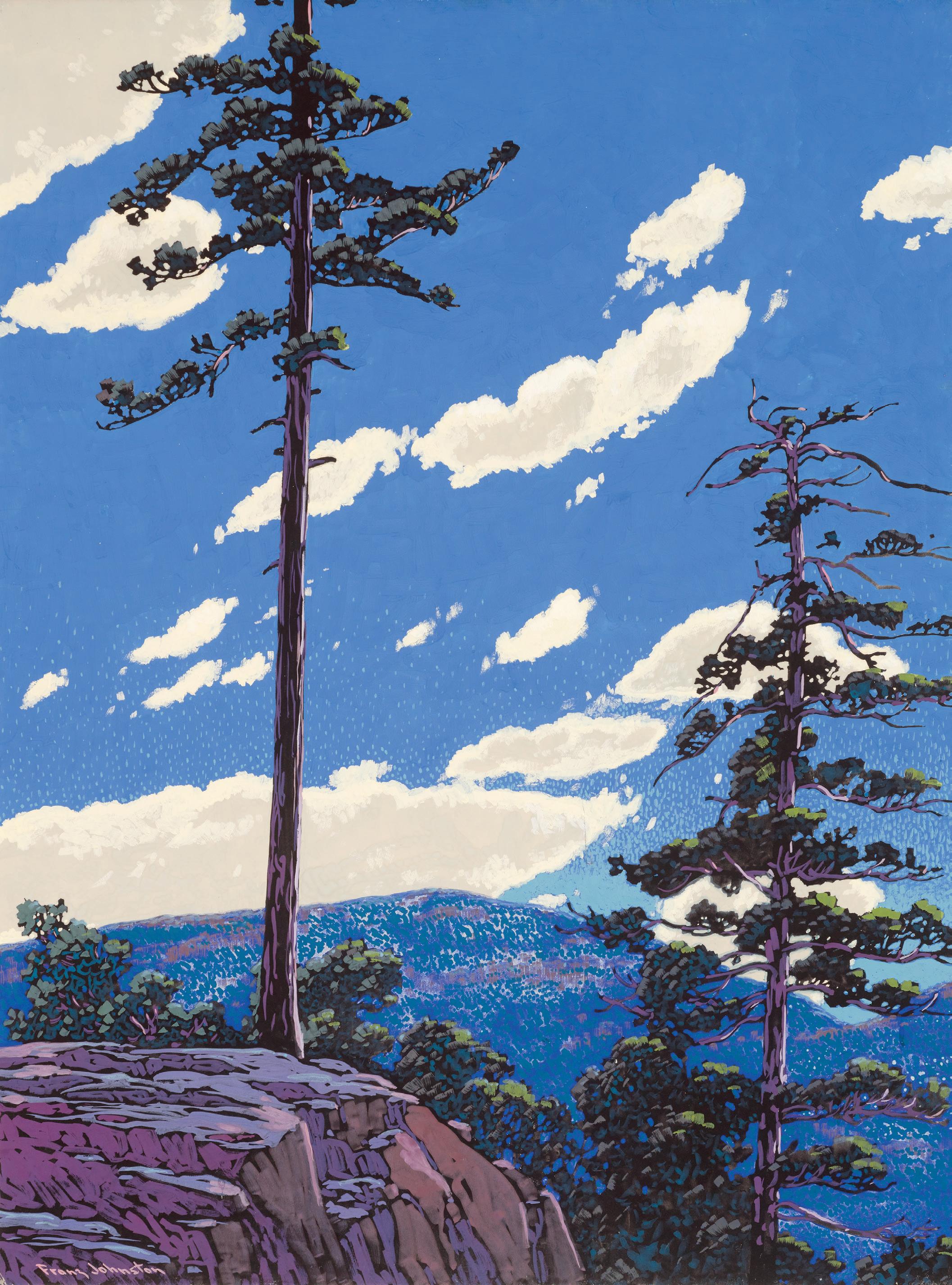
| Live Auction - Spring 2024 73
COWLEY ABBOTT
ALEXANDER YOUNG JACKSON
The River, Baie-Saint-Paul oil on canvas
signed and dated 1929 lower right; inscribed indistinctly on the stretcher 25 ins x 32 ins; 63.5 cms x 81.3 cms
PROVENANCE
Collection of the Artist, Toronto Mary Osler Boyd, Toronto, 1934 Private Collection, Ottawa, by descent Dominion Gallery, Montreal, 1966
David Molson, Montreal, 1966
Kenneth G. He el Fine Art Inc., Vancouver Private Collection, Vancouver Joyner Fine Art, auction, Toronto, 25 November 1994, lot 31 as e Gou re River, Baie St-Paul Masters Gallery, Calgary Private Collection
EXHIBITED
Exhibition of the Group of Seven , Art Gallery of Toronto, 5-27 April 1930, no. 81 as e River, Baie St. Paul Exhibition of Paintings and Drawings by Group of Seven and Other Artists, Art Association of Montreal, 3-18 May 1930, no. 81 as e River, Baie St. Paul at $300 Paintings by A.Y. Jackson , J. Merritt Malloney’s Gallery, Toronto, to 10 March 1934, no.14 as e River at Baie Paul
LITERATURE
Library and Archives Canada, Ottawa, Naomi Jackson Groves fonds (MG30-D351) Container 95-11, Letters to Florence Clement 19231924; Container 69-20 Inventory Binder 1930 A.Y. Jackson, “Winter Sketching,” Supplement to the McGill News, VIII:3 (June 1927), pages 298-300
“Kenneth G. He el Fine Art. Inc.,” Canadian Art Sales Index 1980-81, Vancouver, 1981, reproduced page 4
e Lower Saint Lawrence became A.Y. Jackson’s favourite painting site in the 1920s. He painted at Cacouna on the south shore opposite Tadoussac in the spring of 1921 and in March 1923 visited Baie-Saint-Paul for the rst time. Situated on the north shore of the Saint Lawrence, the picturesque village lies at the mouth of the Gou re River, which meanders down from Saint-Urbain, the village made so famous by Clarence Gagnon’s 1925 canvas Village in the Laurentian Mountains (National Gallery of Canada). On 16 March 1923 Jackson wrote to his cousin Florence Clement, “It's snowing in Baie St. Paul. It seldom seems to stop and soon there won’t be anything to paint but snow. … e village is rather ne. New church, very awful architecture replacing a ne old one and a lot of gaily painted houses, but rather hard to compose. However there should be something to do when the little river breaks up.”
On 10 January 1924 he again wrote to Florence Clement from Baie-Saint-Paul. “I don’t like the winter quite so early in January. I like it when it is over the divide and you can see or feel the oncoming of spring. Now winter is just a little too cocky. It looks too much like Christmas cards here now. I see them all over.”
Jackson was fascinated by the changing e ects of light and snow. “March and April are the happy sketching months, when the snow is old and rich in form and texture, and the cold does not sti en the colours or nip the ngers, and when the thaw starts, every day brings changes of colour and new elements in design…. e snow … is sensitive to every phase of light, and changes in sympathy with the sky; the relationship of the two is often the chief problem,” he wrote in the Supplement to the McGill News in 1927.
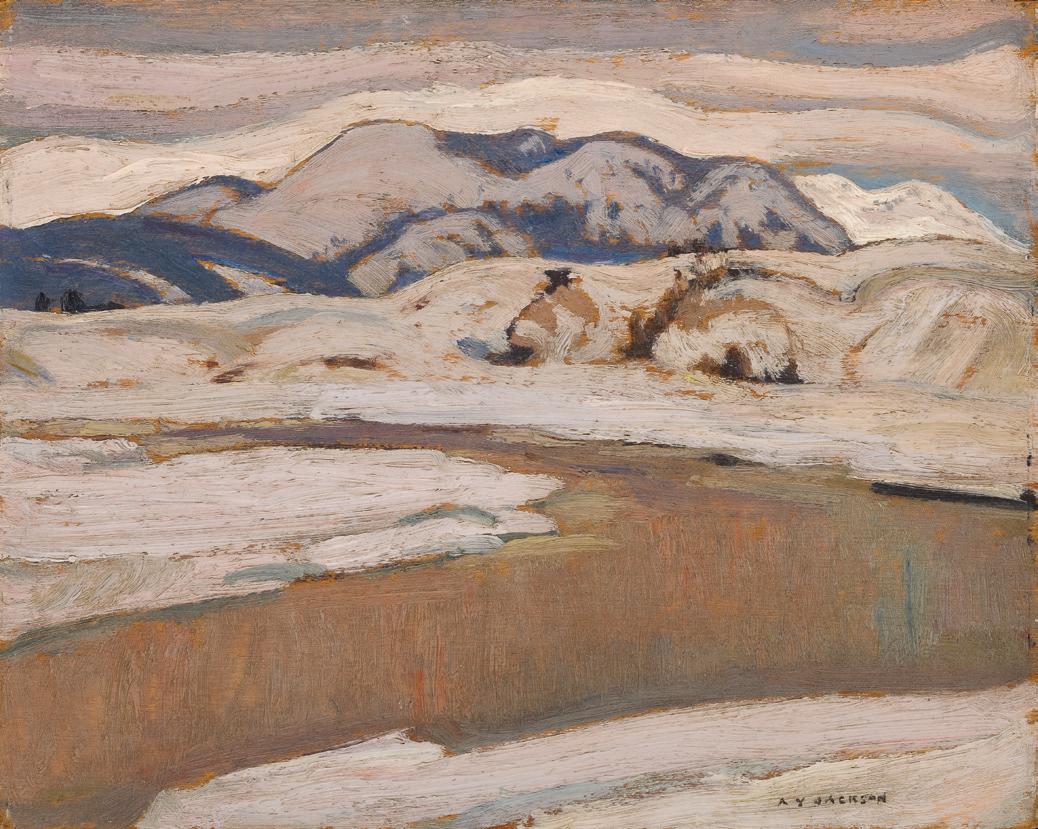
A.Y. Jackson River, Baie St. Paul, Quebec , 1928 oil on wood panel, 21.6 x 26.7 cms McMichael Canadian Art Collection Gift of the Founders, Robert and Signe McMichael Not for sale with this lot
COWLEY ABBOTT | Live Auction - Spring 2024 74 128

Jackson was especially attracted to the architecture and inhabited rural landscape of the older regions of Quebec and his principal subjects in the mid-1920s were the villages and farmhouses, the rural roads and wind-swept barns. However, the landscape was changing, as he bemoaned in that same McGill article. “ e picturesque side of Quebec is rapidly disappearing, the traditional architecture has given way to the bungalow and red brick atrocities surrounded by verandahs, the homespun and rugs and blankets are being made to sell to tourists, the old boat-shaped red sleigh which faded to violet grey is being supplanted by an artist-proof factory article…. e painter, however, is not dependent on the picturesque, … ne canvases can be developed from the slightest of external [motifs].”
In March 1928 Jackson once again returned to Baie-Saint-Paul to nd the village smothered in snow. Possibly disturbed by the changes in the architecture of the village and unable to move up to Saint-Urbain due to an outbreak of smallpox, Jackson painted the landscape around the Gou re River. Worked up from an oil sketch painted that March and now in the McMichael Canadian Art Collection, River, Baie St. Paul, marks a turning point in Jackson’s depiction of the rural Quebec
landscape. No house, barn or sleigh occupies the river valley. e painting has been developed from “the slightest of external motifs,” the river and surrounding hills. e muted palette of browns and greys, similar to Jackson’s Beothic at Bache Poste (National Gallery of Canada) also shown in the 1930 Group of Seven exhibition, is accented by rich blue shadows and white snow in the distant hills. Red branches emerge from the snow on the far slope and the transparent brown water is edged by touches of green ice. From the foreground shore to the curving river to the riverbank, hills and clouds, the whole composition is determined by the interplay of broadly brushed, rolling rhythms.
We extend our thanks to Charles Hill, Canadian art historian, former Curator of Canadian Art at the National Gallery of Canada and author of e Group of Seven‒ Art for a Nation , for his assistance in researching this artwork and for contributing the preceding essay.
$150,000–$200,000
COWLEY ABBOTT | Live Auction - Spring 2024 75

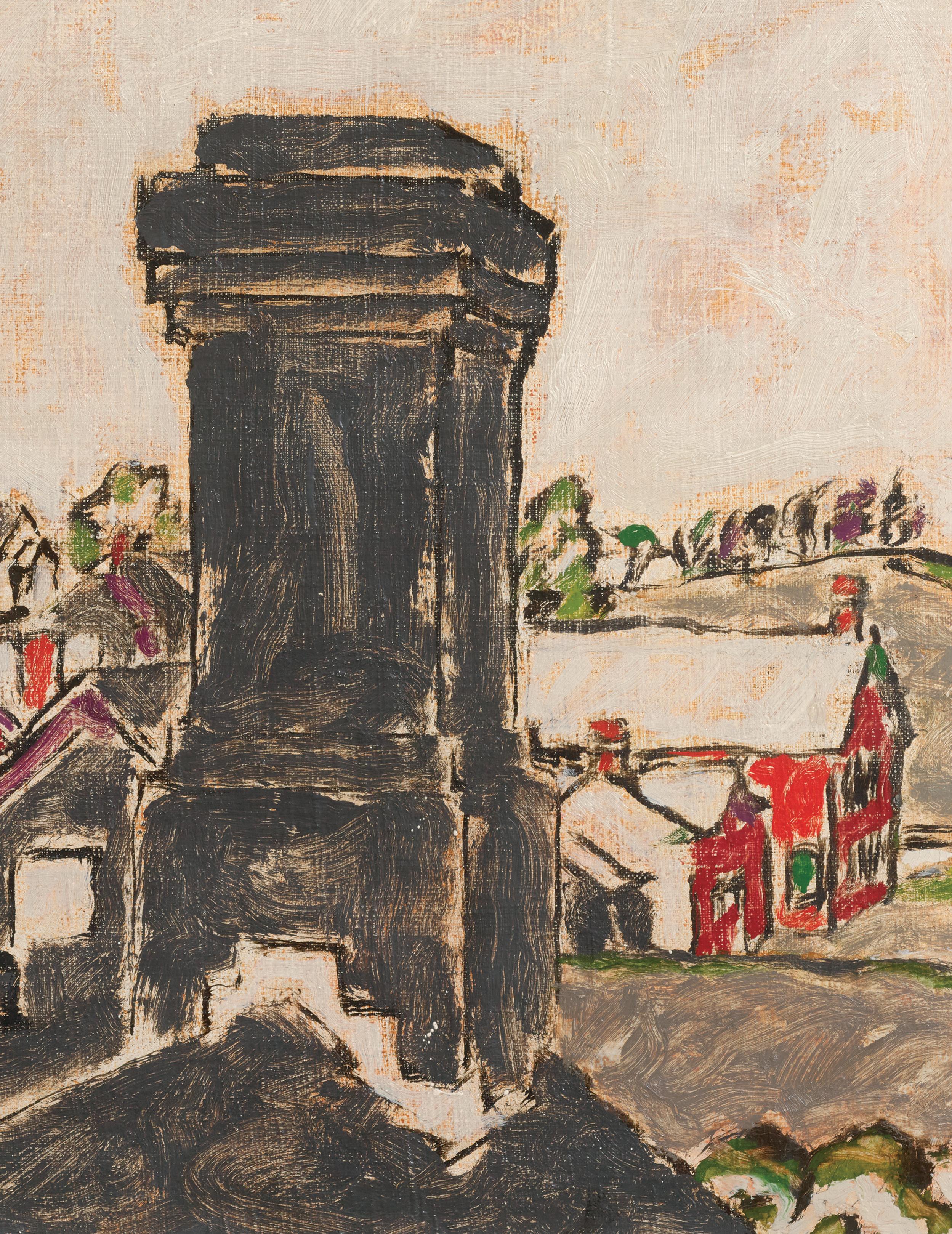
DAVID BROWN MILNE
The Black Chimney oil on canvas
signed and dated 1932 upper left; catalogue raisonné no. 302.139 26.25 ins x 32.5 ins; 66.7 cms x 82.6 cms
PROVENANCE
Collection of the Artist
e Rt. Hon. Vincent Massey, Port Hope, 1934 Mellors Galleries, Toronto, 1934
Professor W.J. McAndrew, 1938
By descent to a Private Collection Masters Gallery, Calgary Private Collection
EXHIBITED
Exhibition of Paintings by David B. Milne, Mellors Galleries, Toronto; travelling to James Wilson and Co., Ottawa and W. Scott and Sons, Montreal, 27 November 1934-February 1935, no. 2 as e Chimney
David Milne, Hart House, University of Toronto, 14-28 March 1955
David Milne, Hart House, University of Toronto, 7-22 January 1962
LITERATURE
Exhibition of Paintings by David B. Milne, Toronto, 1934, no. 2 as e Chimney
Robert H. Ayre, “Exhibit of Works by David B. Milne”, Gazette, (Montreal), 19 March 1935
Possibly E.W. Harrold, “David Milne's Original Art”, Ottawa Citizen , 1 February 1935
Emile Venne, “Un Fauve: M. David B. Milne”, L'Ordre (Montreal), 28 March 1935
David Milne, Toronto, 1955, possibly reproduced
Susan Pamela Chykalink, “David B. Milne's Return to Canada: A Study of the Temagami, Weston and Palgrave Years, 1929-1933” (M.A. esis, Queen's University, 1986) page 98
David P. Silcox, Painting Place: e Life and Work of David Milne, Toronto, 1996, pages 197, 230, 240
David Milne Jr. and David P. Silcox, David B. Milne: Catalogue Raisonné of the Paintings, Volume 2: 1929-1953, Toronto, 1998, reproduced page 540, catalogue raisonné no. 302.139
David Milne was a master with black pigment and used it often. Here it describes the main architectural element in a view from the upper oor of the Milne’s home in Palgrave, Ontario, a village of about 100 at this time, in the Caledon Hills north of Toronto. He and Patsy Milne moved back to Canada from the USA in 1929, lived brie y in Toronto, and arrived in Palgrave the spring of 1930. e place where he painted was especially important to Milne. Palgrave’s serene, agrarian surrounds and village sights were ideal aesthetically.
Milne frequently painted prospects of this town and neighbouring countryside from this vantage point. As the late David Silcox has pointed out, one reason for this choice is that strong, anchoring motifs such as this chimney provide visual interest through contrast with a relatively calm sky. We see that strategy here and in cognate paintings such as Kitchen Chimney, 1931 and Chimney on Wallace Street, 1932.
Looking at e Black Chimney, we might recall that Milne was a skillful printmaker, a medium that demands nuanced attention to tonalities. In his oils too, black is not just black: paint is applied thinly to describe the title’s motif and the roofs of most of the adjacent buildings. He was sparing with the saturation of his forms for economic as well as aesthetic reasons, as he explained in a letter from this time: “ e reason for this way of putting on the paint is a feeling for economy – of aesthetic means ... a hankering to do things by the slightest touch on the canvas, the brush meeting it and no more ... Some feeling of economy prevents me from varying hues in the same picture (by adding white or less white). is is so strong that I sacri ce economy of touch ... to economy of value in the hues. ese things are slight when put in words but they are very strong and control you pretty completely.”
e Great Depression was particularly dire for the always impecunious Milne, but as always, he made personal hardship into an aesthetic triumph. His blacks here are living skins of paint, not unrelieved, inanimate blocks. White accents sparkle through on the chimney itself. e ashing joining this structure to the roof is completely white. e longer we look, the more apparent it becomes that e Black Chimney is articulated throughout using black, white, and just a few coloured accents. In Milne, maximal vision is achieved with minimal means.
Mark A. Cheetham has written extensively on Canadian artists, including Jack Chambers, Alex Colville, Robert Houle, and Camille Turner, most recently in the collection Unsettling Canadian Art History (2022). He is a freelance writer and curator and a professor of Art History at the University of Toronto.
$200,000–$300,000
COWLEY ABBOTT | Live Auction - Spring 2024 78
129
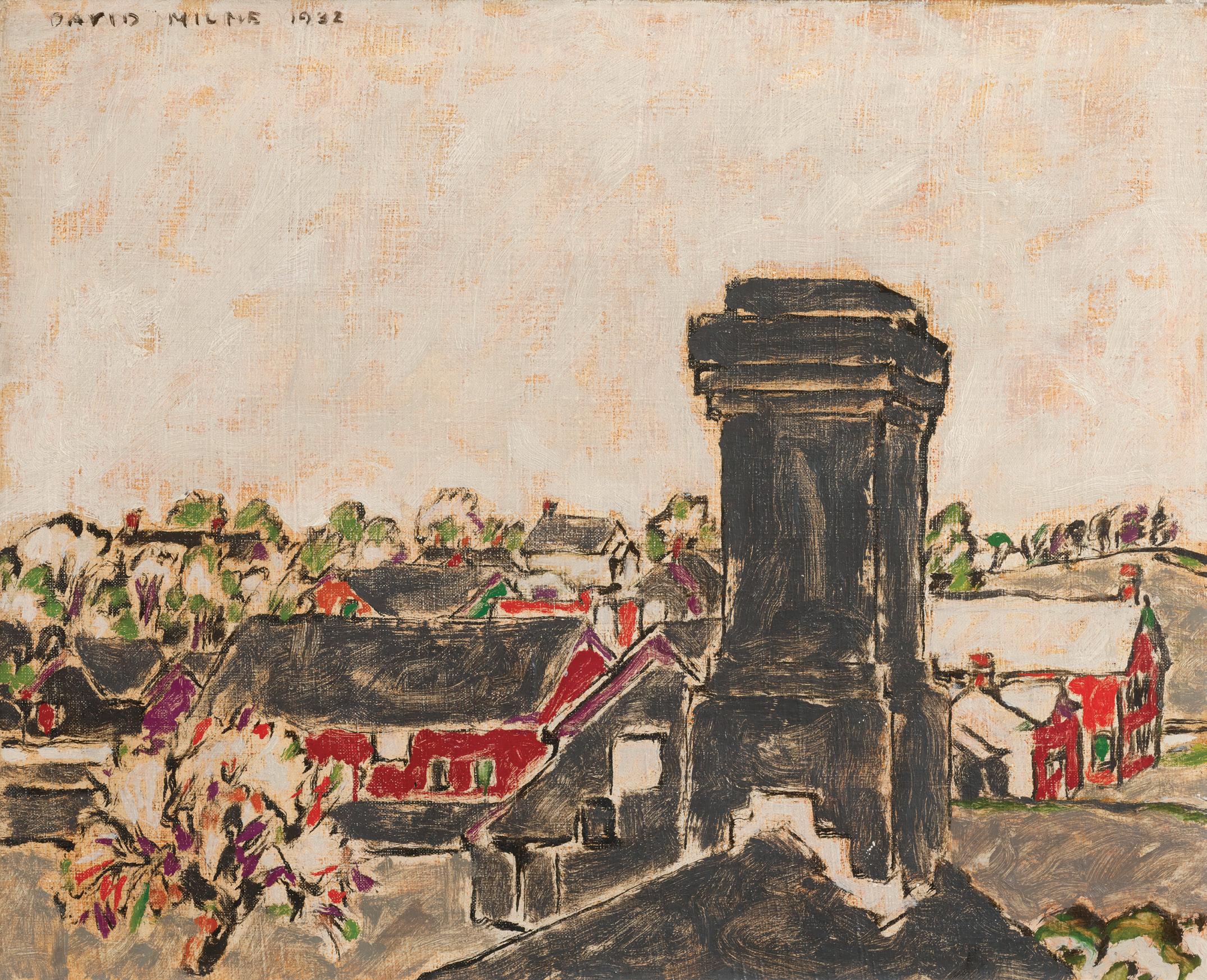
COWLEY ABBOTT | Live Auction - Spring 2024 79
130
JACK LEONARD SHADBOLT
25 Birds of Good Omen
acrylic and watercolour on illustration board
signed and dated 1970 lower right; titled and inscribed "For Doris on the occasion of our 25th anniversary Sept. 21, 1970" lower left 60 ins x 40 ins; 152.4 cms x 101.6 cms
PROVENANCE
Estate of the Artist
Doris Shadbolt, Vancouver Masters Gallery, Calgary Private Collection
EXHIBITED
Correspondences: Jack Shadbolt, Glenbow Museum, 2 November 19915 January 1992, no. 72 as Birds of Good Omen For Doris, 1970 Jack Shadbolt, R.C.A., Works from the Estate, Masters Gallery, Calgary, 4-6 April 2002 as 25 Birds of Good Omen , 1970
LITERATURE
Scott Watson, Jack Shadbolt, Vancouver/Toronto, 1990, reproduced page 145
Patricia Ainslie, Correspondences: Jack Shadbolt, Calgary, 1991, no. 72, reproduced page 64
Masters Gallery, Jack Shadbolt, R.C.A., Works from the Estate, Calgary, April 2002, reproduced on the cover
Jack Shadbolt played a signi cant role in the Vancouver art scene starting from the 1940s, alongside B.C. Binning. Drawing inspiration from Cubism, Surrealism, American Regionalism, and Northwest Coast Native American art, Shadbolt utilized these diverse in uences to express his profound connection to nature and its cultural signi cance. Surrealism was a formative in uence on Shadbolt’s work and the thread that tied all periods of the artist’s body of work together. e use of Surrealism became more clear and speci c as the years progressed. While Surrealism informed the work, Shadbolt’s attention to the formal principles, such as draughtsmanship and deliberate structuring of form provided cohesion and harmony.
Shadbolt emigrated from England in 1912, initially settling in the B.C. interior before making Victoria his home in 1914. His encounter with Emily Carr in 1930 at Victoria College left a lasting impact on his life and work. Despite their di ering artistic styles, both artists drew inspiration from the spiritual connection with nature seen in Northwest Coast Native American art. is shared interest in the mystic unity of natural, cosmic, and cultural elements resonates deeply in Jack Shadbolt's work.
Created as a twenty- fth anniversary gift for his wife, Doris, 25 Birds of Good Omen is a calendar of owls, which represent the 25 happy years of marriage for the couple. Jack and Doris were a close couple who married in 1945. Together they founded the Vancouver Institute of Visual Arts together, which was a charitable foundation that provided grants to artists to nurture and support their practice.
Birds were a recurring theme for the artist whose work regularly dealt with metamorphosis and the natural world. 25 Birds of Good Omen was created during the same year that Shadbolt was featured in a touring thirty year retrospective organized by the Vancouver Art Gallery in collaboration with the National Gallery of Canada. It was also the year that Shadbolt began a series of works that featured owls, with some incorporating collage. Other works in the series included Birds in a Tree, October and e Owl Shop. Shadbolt's exploration of sequences and series in the 1970s was often likened to pop aesthetics, but he viewed repetition as a way to connect to myth, ritual, and sexuality. While Romans believed the owl to be a bad omen associated with death and ill fate, the Greeks had a more favourable view. e owl was revered and symbolized wisdom. Owl trinkets were meant to protect the bearer and brought good fortune and luck. Among the single species is dynamic variety. In 25 Birds of Good Omen each owl is given a distinct look and personality in recognition that each year of a marriage is di erent and constantly evolving.
$20,000–$30,000
COWLEY ABBOTT | Live Auction - Spring 2024 80
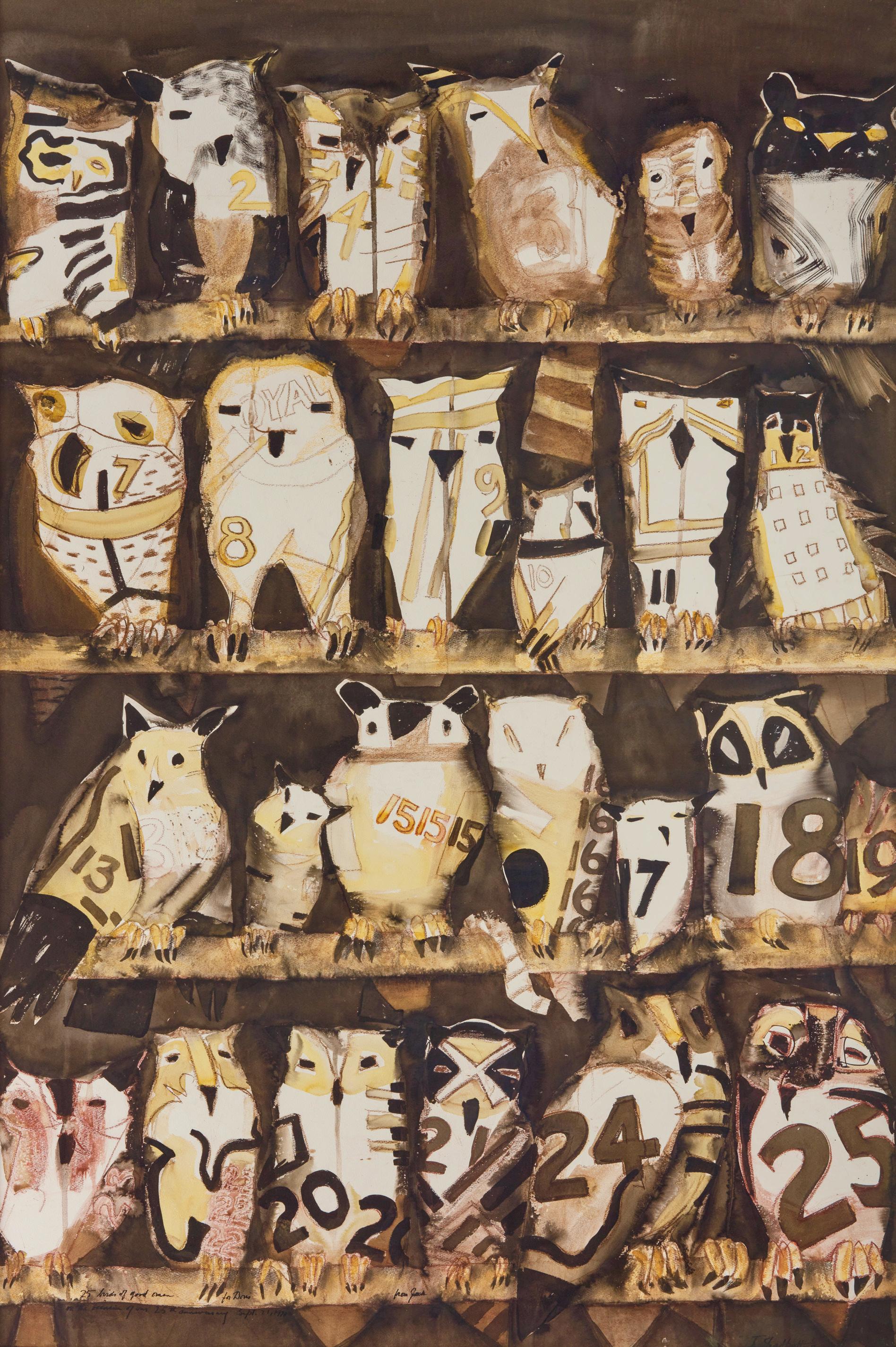
| Live Auction - Spring 2024 81
COWLEY ABBOTT
ALEXANDER YOUNG JACKSON
Eastern Arctic oil on panel
signed lower right; signed, titled, dated 1930, inscribed "Artic" [sic], "Joe McCulley", "owned by "H.V. Ross" and the Naomi Jackson Groves inventory number ("NJG 108") on the reverse 8.5 ins x 10.5 ins; 21.6 cms x 26.7 cms
PROVENANCE
Joseph McCulley, Toronto
H.V. Ross, Toronto
Joyner Waddington's, auction, Toronto, 2 December 2003, lot 53 Masters Gallery, Calgary Private Collection
EXHIBITED
Possibly Arctic Sketches by A.Y. Jackson , Hart House, University of Toronto, November 1930, no. 4 as Neerke, Greenland
Possibly Arctic Sketches by A.Y. Jackson, R.C.A. & Lawren Harris, National Gallery of Canada, Ottawa, 26 November–8 December 1930, no. 4 as Neerke, Greenland
Possibly Arctic Sketches by Lawren Harris and A.Y. Jackson, R.C.A., Art Gallery of Toronto, from 1 May 1931, no. 357 as Nerke, Greenland
A.Y. Jackson , Arts & Letters Club, Toronto, from 3 October 1972
LITERATURE
Library and Archives Canada, Naomi Jackson Groves Fonds, MG 30
D351, Container 52, le 13, A.Y. Jackson’s Arctic Diary 1930, and Container 69-21 Inventory Binder Arctic 1930
A.Y. Jackson, A Painter’s Country, Toronto, 1958, pages 98, 105-108
Dennis Reid, Le Groupe des Sept/ e Group of Seven , Ottawa, 1970, pages 231-234, 237-240
A.Y. Jackson e Arctic 1927, Moonbeam, Ontario, 1982, unpaginated, plate 58
David Silcox, e Group of Seven and Tom omson , Toronto, 2003, page 390

Encampment, Eastern Arctic oil on canvas, 50.8 x 66 cms
Private Collection
Not for sale with this lot
A.Y. Jackson’s trips to the Arctic in 1927 and 1930 are key moments in the artist’s life-long exploration of Canada’s many landscapes. On both trips he travelled on the Canadian government supply boat, the Beothic. In 1927 he was accompanied by Dr. Frederick Banting and in 1930 by fellow artist Lawren Harris. e rst voyage resulted in a large number of drawings, oil sketches and several canvases, one of which, North Shore, Ba n Island (also exhibited as Eskimo Village), acquired by Toronto’s East York Collegiate in 1928, depicted an encampment of tents, houses, dogs and Inuit on a rise in the foreground with an expansive view of the hills of Bylot Island across ice-strewn water. As Jackson later wrote, “Since our time at any of our stopping places was, of necessity, limited, we got into the habit of making notes [i.e. drawings] while ashore. When we were at sea again we made paintings from these notes in our cabin.” is canvas was worked up from a drawing (reproduced as plate 58 in A.Y. Jackson e Arctic 1927 ) made at Pond Inlet in Northern Ba n Island on 16 August 1927 and from an oil sketch (sold at He el Fine Art Auction House, 23 May 2007, lot 146a), possibly painted from the drawing in the artists’ cabin.
e rst part of Jackson’s second trip north followed much the same route as in 1927, but ice and fog were constant variables. e ship’s stop at Pangnirtung on the east coast of Ba n Island resulted in a good number of drawings and the canvases Summer, Pangnirtung Ba n Island (McMichael Canadian Art Collection, 1979.26.4) and Eskimo Summer Camp, Pangnirtung ese paintings rework the composition of the earlier North Shore, Ba n Island , with a foreground encampment, a body of water in the middle ground and distant hills, as does the oil sketch o ered here. But Eastern Arctic was not painted at Pangnirtung but, as Naomi Jackson Groves has noted, at Nerck (or Nerke) on Robertson Bay or Fjord in Northern Greenland. As Jackson wrote in his autobiography, A Painter’s Country, from the rst northern stop at Godhavn, the Beothic headed north to Ellesmere Island then followed the Greenland coast south where Jackson “saw a noble range of big reddish-violet hills covered by glaciers standing in relief against warm grey skies. We called at Nerck … an old settlement of stone igloos…”. Most striking are the dramatic glaciers discharging from the Greenland ice sheet across the water. is composition also began in a drawing, now in the Firestone Collection at the Ottawa Art Gallery,

Lawren Harris
Robertson Bay, Greenland, circa 1930 oil on wooden panel, 29.5 x 37.5 cms
University of Alberta Art Collection
Gift of Alexander (Andy) and Margaret Andrekson
Not for sale with this lot
COWLEY ABBOTT | Live Auction - Spring 2024 82
131
A.Y. Jackson

dated 16 August 1930, three years to the day after Jackson drew the Pond Inlet study for North Shore, Ba n Island. Another, more detailed preliminary drawing sold at Joyner Waddington’s in Toronto, 2 December 2003, lot 54 together with this oil sketch.
Jackson’s a ectionate depiction of the tents, dogs and family group, painted in earth tones with accents of blue and a rollicking rhythm, contrasts strikingly with Lawren Harris’ oil sketch of Nerke (inscribed on the back Robertson Bay, Greenland and Nerke, Greenland North) that he gave to Emily Carr in November 1933 and that is now in the collection of the University of Alberta. Harris’ sketch is an intellectual construct, devoid of human life. e reddish violet hills are colder, as are the grey sky and clouds. In both works the glaciers ow into the sea. Harris worked up his sketch to paint the canvas Greenland Mountains (National Gallery of Canada, 4279).
Eastern Arctic was formerly in the collection of Joseph McCulley, who was warden of Hart House from 1952 to 1965, and was subsequently acquired by Arts and Letters Club member Harry Ross, who, in 1964 (Groves) or 1965 (Silcox), asked Jackson to paint a canvas from this 1930 sketch. at canvas sold with the drawing and oil sketch at Joyner Waddington’s in Toronto on 2 December 2003, lot 52. Ross loaned two untitled canvases and two untitled sketches, most likely including this sketch and the canvas, to the A.Y. Jackson exhibition celebrating the artist’s ninetieth birthday, at the Arts and Letters Club in 1972.
We extend our thanks to Charles Hill, Canadian art historian, former Curator of Canadian Art at the National Gallery of Canada and author of e Group of Seven‒ Art for a Nation , for his assistance in researching this artwork and for contributing the preceding essay.
$70,000–$90,000
COWLEY ABBOTT | Live Auction - Spring 2024 83
MAURICE GALBRAITH CULLEN
View of Quebec from Lévis oil on canvas
signed and dated 1904 lower right; Cullen Inventory No. 1000 16.5 ins x 22.25 ins; 41.9 cms x 56.5 cms
PROVENANCE
Walter Klinkho Gallery, Montreal
Peter Bronfman, Toronto Masters Gallery, Calgary Private Collection
LITERATURE
A.K. Prakash, Impressionism in Canada: A Journey of Rediscovery, Stuttgart, 2015, page 321
Following a six year stay in Paris and further travels through the French countryside, in 1895 Maurice Cullen exhibited at the Salon and was the rst Canadian to be o ered an associate membership to the Societé nationale des beaux-arts. Despite his growing success in France, the artist chose to return to Montreal that same year. Cullen was determined to give Canadians the opportunity to appreciate the impressionist art he admired in Paris, and to portray the Canadian landscape in this preferred style. He began to exhibit his works in 1896, which received overwhelmingly positive reviews.
In the early 1900s Cullen was exhibiting regularly in Montreal and garnered more signi cant recognition from critics. He was awarded a bronze medal at the 1904 World’s Fair in St. Louis, Missouri; this success motivated Cullen, together with William Brymner, to build a studio in Saint-Eustache, northwest of Montreal. Every year he travelled up and down the Saint Lawrence River between Montreal and Quebec to paint his surroundings. Here, Cullen depicts a favourite subject of Quebec painters, View of Quebec from Lévis, in his quintessential impressionist style which lends itself perfectly to the subtle and monochromatic colour palette of the snow and ice-covered river scene. Cullen created a completely new vision of the Canadian wilderness, which in uenced the next generation of landscape artists including the Group of Seven. A.Y. Jackson praised these works, remarking: “To us [Cullen] was a hero. His paintings of Quebec city, from Lévis and along the river are among the most distinguished works produced in Canada.”
$10,000–$15,000
COWLEY ABBOTT | Live Auction - Spring 2024 84
132

COWLEY ABBOTT | Live Auction - Spring 2024 85
ETHEL SEATH
St. Sulpice Garden, 1930 oil on board signed lower right; titled on a label on the reverse 16 ins x 12 ins; 40.6 cms x 30.5 cms
PROVENANCE
A.K. Prakash & Associates, Inc., Toronto Masters Gallery, Calgary Private Collection
EXHIBITED
e Beaver Hall Group Retrospective Exhibition , Walter Klinkho Gallery, Montreal, 13-27 September, 1999, no. 22
LITERATURE
A.K. Prakash, Independent Spirit: Early Canadian Women Artists, Richmond, Hill, Ontario, 2008, reproduced pages 114, 135 and 326 as Nuns, St. Sulpician Garden , 1930
Saint-Sulpice Seminary is located in Montreal and boasts the oldest religious building in the city, which was erected between 1684 and 1687. e grounds included a garden where priests, following a monastic tradition, grew fruits and vegetables. It is regarded as one of the rst gardens of its kind in North America. e geometric design of the garden was borrowed from the French style of the Renaissance. e diagonal aisles are arranged around a central statue.
As a prominent gure in the Montreal art scene for over sixty years, Ethel Seath worked as an illustrator for Montreal newspapers and taught art at a private school for girls for over 45 years. In addition to her successful illustration career, she attended sketching classes and trips with William Brymner, Edmond Dyonnet and Maurice Cullen with the Art Association of Montreal. It was under the tutelage of William Brymner that the artist met fellow artists with whom she would form the notable Beaver Hall Group. e group was known for their equal inclusion of male and female artists and their contributions to modernism. In contrast to the Group of Seven, the Beaver Hall Group was predominantly interested in urban life as we see in St. Sulpice Garden e picture serves as a testament to the rich history of the city. e cloaked gures in the foreground remind us of the site’s function as a religious educational institution. Like Emily Carr’s depictions of missionary structures within the landscape, Seath reminds the viewer of society’s enduring footprint on the land and the complex histories of Canada’s development.
e repeating red and pink brushstrokes create a sense of unity and rhythm throughout the picture and the sinuous trees in the foreground anchor the elements of the picture while lending themselves to the movement of the work. We see the simpli cation of form and bold brushwork inspired by the work of the Impressionists. e volume of form that is characteristic of Seath’s work is on full display in this picture and demonstrates the artist’s desire to be freer in her artistic practice and move away from the more rigid constraints of her graphic art career.
$40,000–$60,000
COWLEY ABBOTT | Live Auction - Spring 2024 86 133
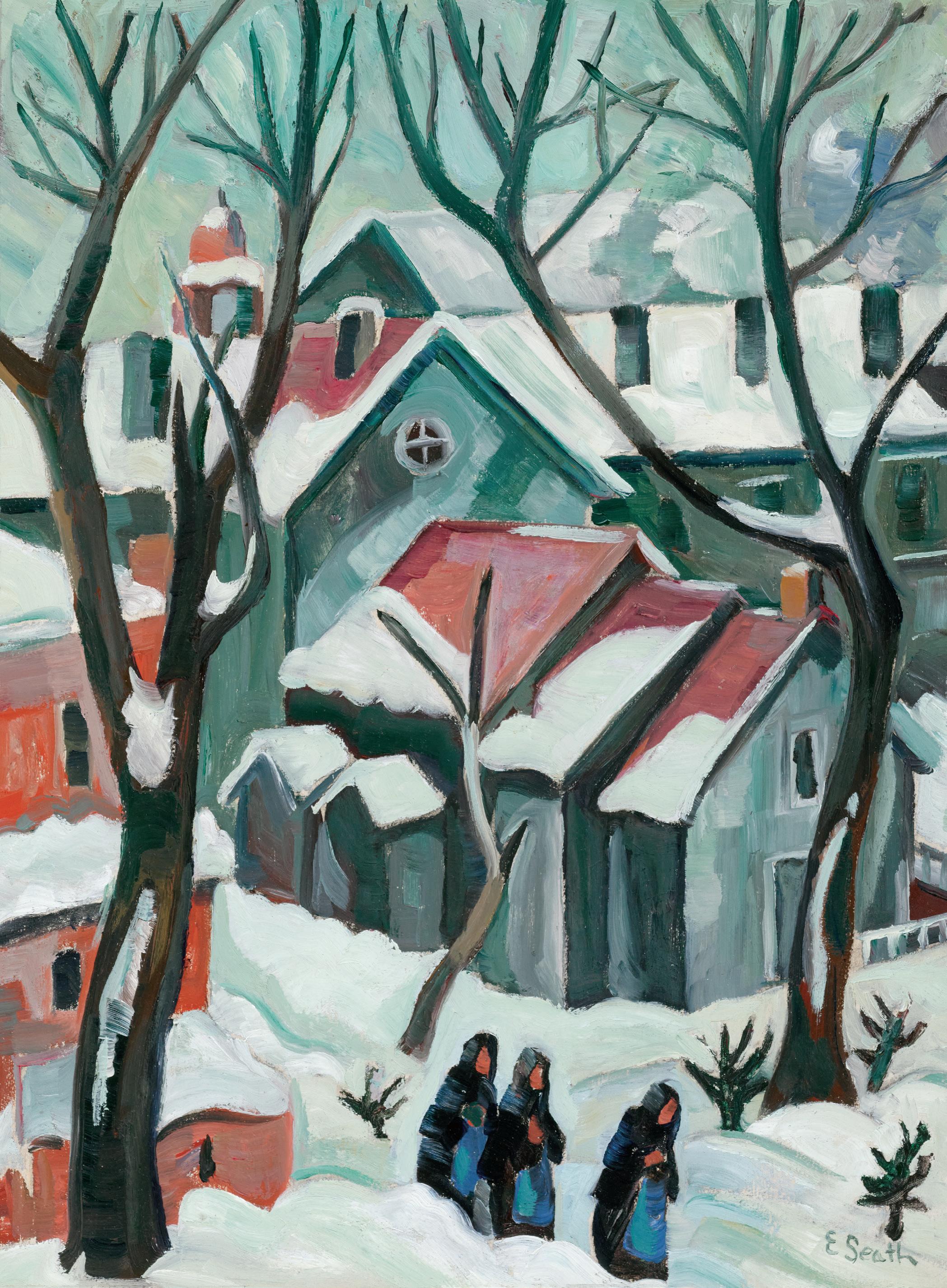
| Live Auction - Spring 2024 87
COWLEY ABBOTT
EDWIN HEADLEY HOLGATE
Madeleine, 1937
oil on board
signed with initials lower left 16 ins x 12.5 ins; 40.6 cms x 31.8 cms
PROVENANCE
Dominion Gallery, Montreal
Madeleine Rocheleau Boyer, circa 1955
Estate of Madeleine Rocheleau Boyer
Masters Gallery, Calgary
Private Collection
EXHIBITED
Edwin Holgate, Montreal Museum of Fine Arts; travelling to the Glenbow Museum, Calgary; McMichael Canadian Art Collection, Kleinburg, Ontario; National Gallery of Canada, Ottawa; Beaverbrook Art Gallery, Fredericton, 26 May 2005-15 April 2007, no. 91
LITERATURE
Dennis Reid, Edwin Holgate, Ottawa, 1976, no. 44, reproduced page 67 Brian Foss, Rosalind Pepall and Laura Brandon, Edwin Holgate, 2005, no. 91, reproduced page 152
Edwin Holgate joined the Group of Seven in 1931 and was a founding member of the Canadian Group of Painters. Holgate established himself as one of the leaders of a modernist current in Canadian painting which centred on depictions of the human gure. His formal training in Paris under Lucien Simon and René Ménard in 1912 had provided him with a highly skilled approach based on careful draughtsmanship and considered compositions. Holgate had exhibited portraits and nudes with the Group of Seven as early as 1924. By the 1930s, he had created many celebrated portraits, while also receiving acclaim for his landscapes and wood engravings. Rather than work on commissioned portraits as a source of income, Holgate’s focus was on the exploration of the formal properties of portraiture.
Holgate’s portrait of Madeleine Rocheleau Boyer alludes to both traditional and modernist conventions of portraiture. e studied composition of the sitter in pro le harkens back to portraits of the early Renaissance. Similar pro le views were favoured in the coins of ancient Greek and Rome. Europe of the fteenth century had seen a revival of the art of antiquity, which coincided with a greater interest in individual identity and a new emphasis on portraiture. While Holgate based Madeleine on these traditional conventions, the model’s hair and makeup root the painting in the 1930s. e subjects of Holgate’s portraits tended to be family and friends of the artist. An artist herself, Madeleine Rocheleau Boyer worked at the studio of Holgate and Ernest Neumann. Popular as an artist’s model, Rocheleau posed for some of Holgate’s most celebrated oils of nudes in landscapes, including Early Autumn of 1938. In later years, she would exhibit her own work regularly in Montreal. Here, her expression appears stoic and introspective. Acclaimed for his portraits and nudes, Holgate’s interest in the formal possibilities of portraiture are evidenced by his methodical, carefully structured works.
$20,000–$30,000
COWLEY ABBOTT | Live Auction - Spring 2024 88
134
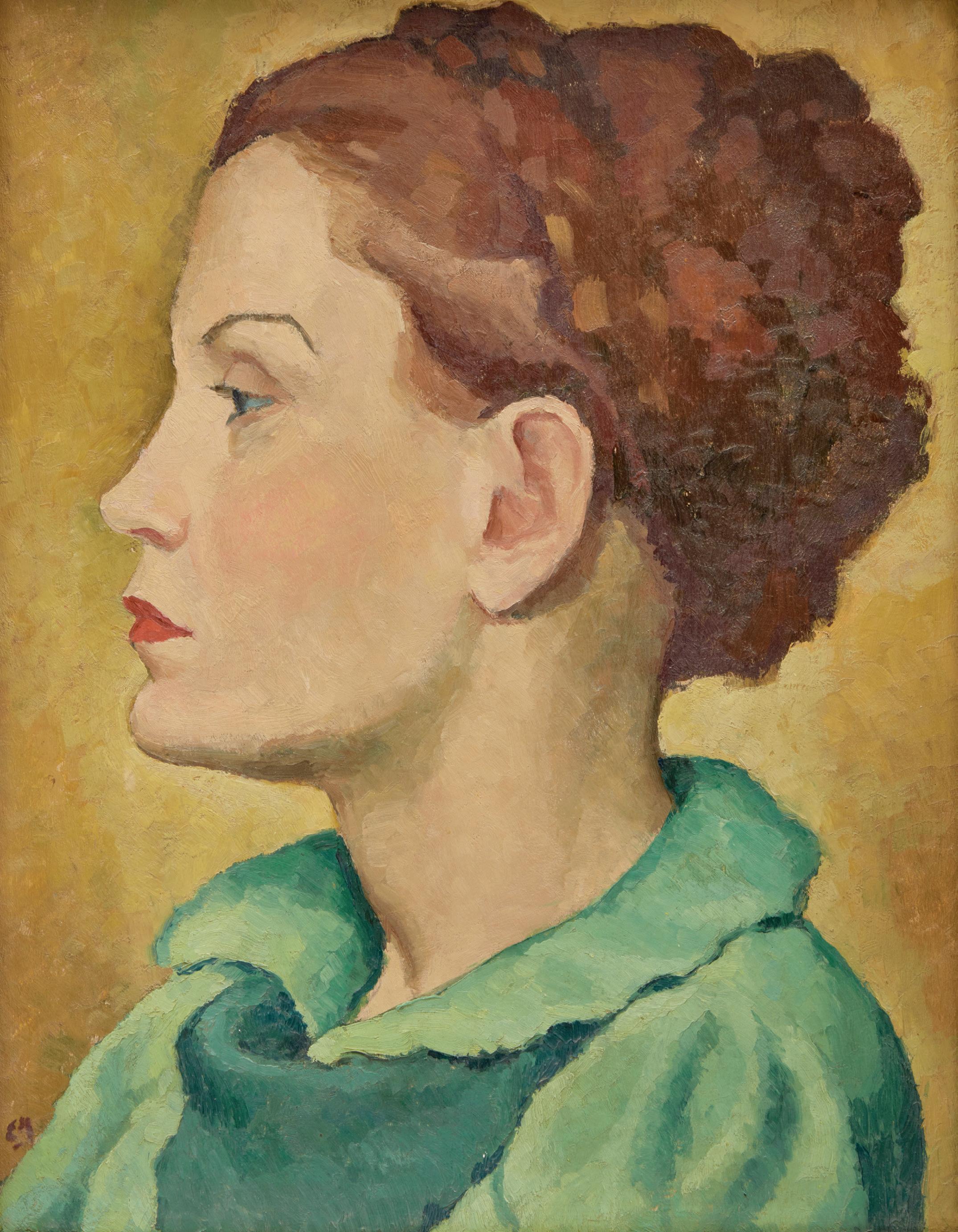
| Live Auction - Spring 2024 89
COWLEY ABBOTT
MARC-AURÈLE DE FOY SUZOR-COTÉ
Indian in the Wood (Indien à la chasse) oil on canvas signed and dated 1907 lower left 25.75 ins x 18.5 ins; 65.4 cms x 47 cms
PROVENANCE
Watson Art Galleries, Montreal
Galerie Bernard Desroches, Montreal Private Collection
EXHIBITED
William Scott & Sons Gallery, Montreal, December 1907-January 1908 as Indian in the Wood 6th Annual Exhibition , Canadian Art Club, Art Museum of Toronto (Public Reference Library Building), Toronto, 29 April-31 May 1913, no. 33 as Indian Hunting in the Woods Watson Art Galleries, Montreal, 16-27 November 1927, no. 3 as Indian in the Woods
50th Spring Exhibition , Art Association of Montreal, 16 March-16 April 1933, no. 308 as Indien chassant à l'arc Suzor-Coté, 1869-1937, Light and Matter, Musée de Quebec; travelling to the National Gallery of Canada, Ottawa, 10 October 2002-11 May 2003, no. 49 as Indian Hunting in the Woods
LITERATURE
"Paintings and Sculpture Shown", e Montreal Daily Star, 24 December 1907, page 12
Laurier Lacroix, Suzor-Coté, 1869-1937, Light and Matter, Québec/ Ottawa, 2002, no. 49, pages 137, 144, reproduced page 145
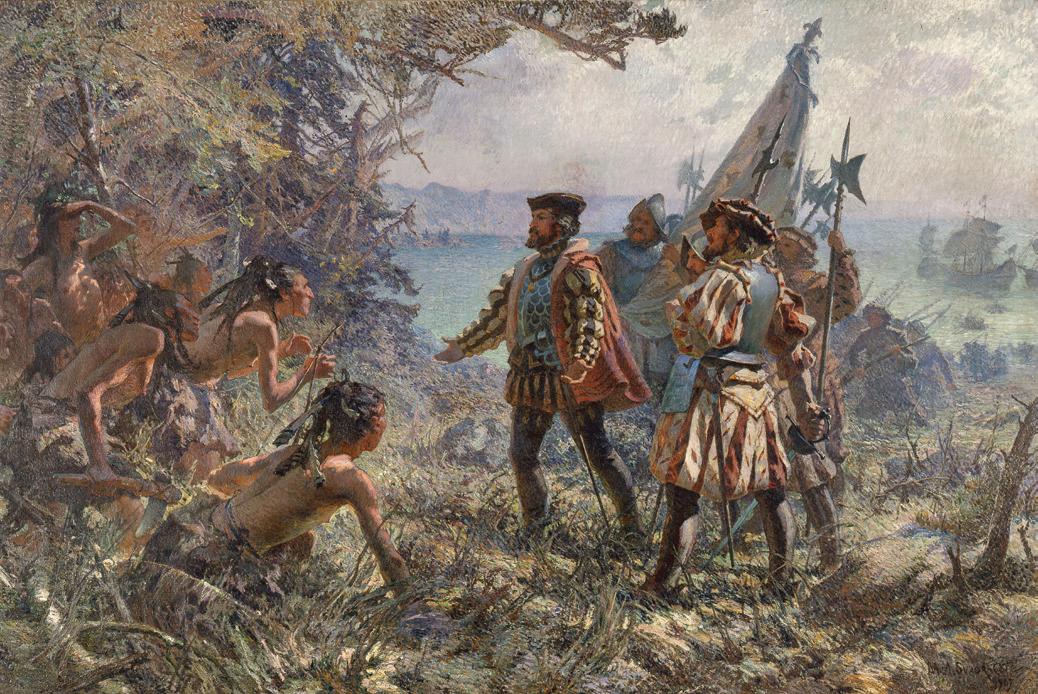
Born in the village of Arthabaska, Marc-Aurèle de Foy Suzor-Coté came from an a uent family. In 1891, he moved to Paris for three years to study ne art at the École de beaux-arts. His art was included in the Paris Salon of 1894. He returned to North America brie y, pursuing commission work, before returning to Europe for an extended period between 1897 and 1907. He had an early interest in landscape painting, however, his academic training held strong and he continued to paint historical pictures until 1902. Suzor-Coté was a very versatile artist and upon returning to Canada in 1907, he began to produce his richly textured style inspired by the Impressionist work he saw in Paris. Indian in the Wood was completed in 1907, the year he left Paris for Montreal. is oil painting demonstrates a clear in uence of French Impressionism, when compared to the artist’s previous works. e colour palette is brighter and more decorative, and the brushstrokes are looser and distinct. Suzor-Coté also adopted their techniques of interpreting light and shadow; ecks of sunlight shine through the forest onto the gure and the ground.
Suzor-Coté would go on to have a successful career as a painter of gures, in oil painting, pastel and bronze. Inspired by French Realist artists such as Jean-François Millet, Suzor-Coté focused on portraying the Québecois peasants in their daily life through portraits and genre scenes. In the early 1900s, Suzor-Coté received many commissions to paint portraits of members of the social elite, as well as one of Sir Wilfrid Laurier in 1909. In these artworks he enlivened the poses and portrayed a more o cial character to his sitters.
Depicting an Aboriginal man hunting, Indian in the Wood is an atypical subject within Suzor-Coté’s category of gural work. e artwork was part of the artist’s brief exploration of the genre of historical painting, serving as a preparatory work for the large painting Jacques Cartier Meeting the Indians at Stadacona, 1535. Laurier Lacroix writes that on Cartier’s second voyage, “he returned from France with the two sons of Chief Donnacana, whom he had taken as guides for his rst exploration in 1534, when the mythical meeting between the two peoples had taken place. In 1535, Stadacona was inhabited by the Iroquois, depicted by Suzor-Coté as the natural sons of the forest.” Lacroix also notes that in 1907, Suzor-Coté painted another version of one of the Iroquois men in the forest, shielding his eyes from the sun, which is Indian in the Wood , depicting the gure with the same arm pose as in the large historical scene.
Jacques Cartier Meeting the Indians at Stadacona, 1535 caused a stir in 1907. e artist’s painting abilities were praised, particularly his separated brushstrokes and his ability to create atmosphere. e content of the painting was criticized, as it was not seen as an accurate historical account, due to Jacques Cartier being too handsome, and the French men’s clothes being too formal and in pristine condition (considering they had just arrived after four months at sea), and the artist “giving into exoticism” when portraying the Iroquois people. Lacroix writes that this painting brought up more general questions surrounding the practice of painting historical events, such as: “How was one to go about representing historical facts four centuries after they took place? How should they be interpreted, and how should the episode be treated both formally and stylistically?”
$50,000–$60,000
COWLEY ABBOTT | Live Auction - Spring 2024 90 135
Marc-Aurèle de Foy Suzor-Coté
Jacques Cartier Meeting the Indians at Stadacona, 1535, 1907 oil on canvas, 264.5 × 401 cms
MNBAQ, Purchased in 1923 (1934.12)
Photo: MNBAQ, Jean-Guy Kérouac Not for sale with this lot

| Live Auction - Spring 2024 91
COWLEY ABBOTT
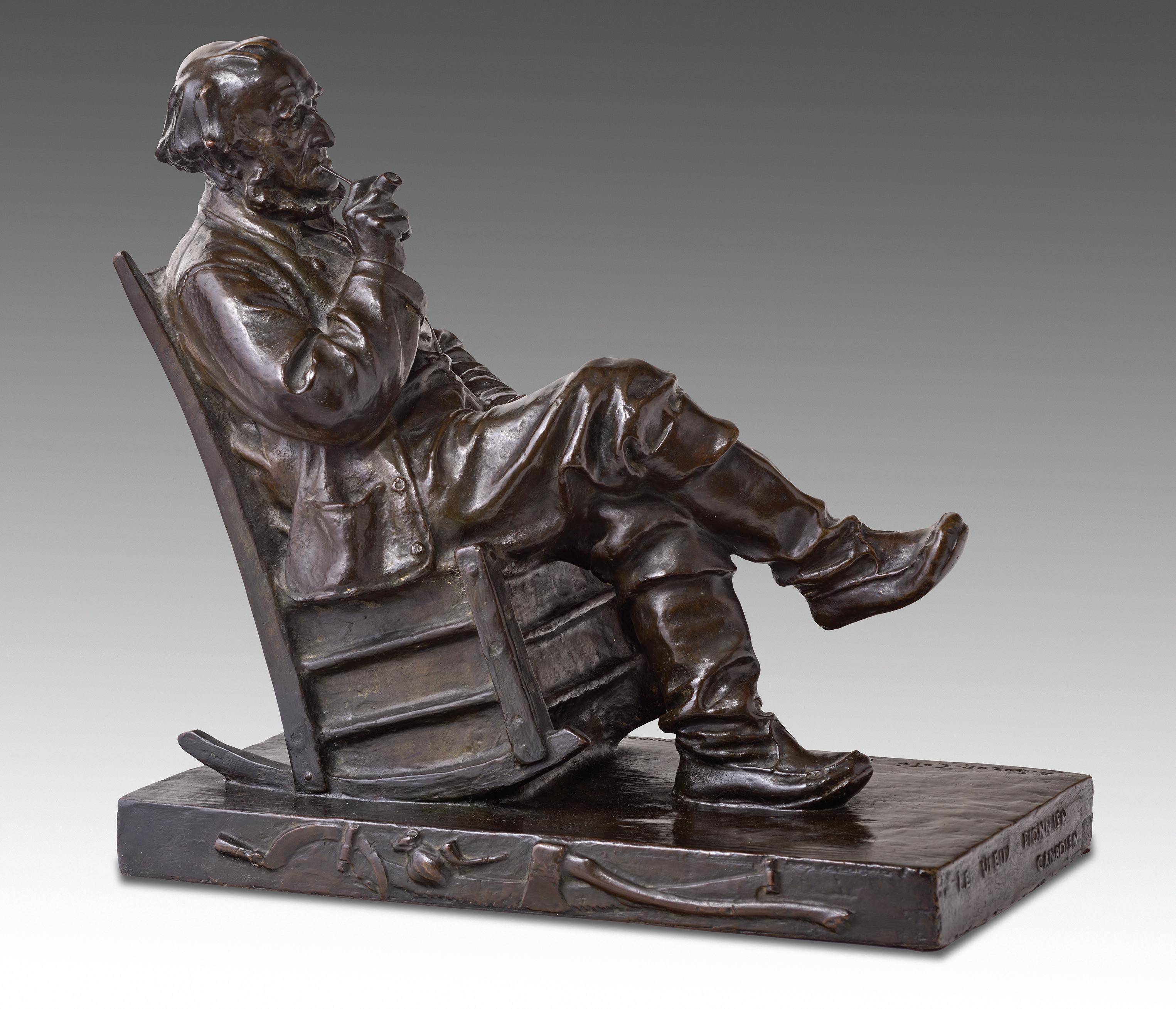
MARC-AURÈLE
DE FOY SUZOR-COTÉ
Le vieux pionnier canadien
bronze signed (incised), dated 1912 and inscribed "Copyrighted-Canada 1914" and "USA" on the base; stamped "Roman Bronze Works N.Y." on the underside of the base
15.75 ins x 16.25 ins x 8.5 ins; 40 cms x 41.3 cms x 21.6 cms
PROVENANCE
Private Collection
LITERATURE
Pierre L'Allier, Suzor-Coté, L'oeuvre sculpté, Quebec, 1991, pages 48-49
e multi-talented Quebec artist was also able to seamlessly shift from painting to working in three dimensions. Marc-Aurèle de Foy Suzor-Coté's bronzes were cast in New York at the Roman Bronze Works and became sought after by collectors in Canada and the United States. He produced over forty di erent bronze gures and groups. Suzor‒ Coté presents Le vieux pionnier canadien as a dreamer, pondering his life, the ri e and varied tools represented on either side of the base testifying to his activities. Suzor‒ Coté depicts the gure in a comfortable seated position, capturing the essence of his subject, the heritage of his people present in the features and attitude of his model. While the artist was renowned for his depictions of the landscape, he was also determined to include images of their rural inhabitants. Inspired by French Realist artists such as Jean‒François Millet, Suzor‒Coté focused on portraying the individuals in their daily life through portraits and genre scenes. e artist had a particular respect and empathy for these people, which is “attributable to the fact that the artist and model shared a common origin.”
$4,000–$6,000
COWLEY ABBOTT | Live Auction - Spring 2024 92 136

MARC-AURÈLE DE FOY SUZOR-COTÉ
La compagne du vieux pionnier canadien bronze signed (incised), dated 1912 and inscribed "Canada Copyrighted U.S.A." on the base; stamped "Roman Bronze Works N.Y." on the underside of the base 15.75 ins x 16.25 ins x 9.25 ins; 40 cms x 41.3 cms x 23.5 cms
PROVENANCE
Private Collection
LITERATURE
Pierre L'Allier, Suzor-Coté, L'oeuvre sculpté, Quebec, 1991, pages 48-49
e faithful companion to Le vieux pionnier canadien , Pierre L'Allier describes La compagne du vieux pionnier canadien as more discrete than her partner, whose strong personality is imposed by the sculptor. Unlike her husband, La compagne's world is de ned within the home. Suzor-Coté included clear detail in the quilted texture of the sitter's skirt (suggesting homespun clothing) and the grained design of the oor beneath her chair. Even at her advanced age, she continues to knit. Suzor-Coté's preoccupation with the gestures of La compagne are evident, paying particular attention to the hands of the old woman, which show clear signs of strength and arthritic wear.
L'Allier notes that Le vieux pionnier canadien and La compagne du vieux pionnier canadien form a pair of inseparable gures, completing a cycle of existence, the husband and wife symbolizing the tenacity and perseverance of rural life.
$4,000–$6,000
COWLEY ABBOTT | Live Auction - Spring 2024 93 137
e provisions of these Terms and Conditions of Sale shall govern any proposed or actual transaction between Cowley Abbott (aka Consignor Auctions Limited) (“CAL”) and the prospective buyer/ bidder (“Bidder”). CAL is acting as agent for the person who has consigned the property to CAL for sale, whether as principal, owner or agent (“Consignor”).
1. e descriptions of items o ered by CAL (“Property”), including artist, title, medium, size, date of execution, provenance, exhibition history, inclusion/reproduction within literature sources, attribution and genuineness, are subject to change leading to the nal sale of said Property (including the process during which bidding is active for the Property during CAL online auctions). Descriptions of Property provided by CAL are not meant to stand as a representation to Bidders and no guarantee or warranty of complete accuracy of the provided descriptions is intended or should be assumed. Bidders are provided the opportunity to view and inspect all Property o ered for sale by CAL through public and/or pre‒arranged private viewings prior to a sale’s completion. No sale shall be rescinded due to a lack of correspondence between the provided description of the Property by CAL and the Property itself, including the illustration of the Property provided by CAL. It is the sole responsibility of a Bidder to make arrangements for the inspection of the Property of interest (by the Bidder itself and/ or by the Bidder’s advisers) prior to sale, and to bid in accordance to this actual inspection and/or reliance upon their advisers’ guidance.
2. e Bidder who has successfully bid on Property (the “Successful Bidder”) con rms that any claims relating thereto shall be claims against Consignor, without recourse to CAL. CAL represents the Consignor exclusively and makes no representation or warranty, express or implied, regarding legal title or ownership of the Property o ered by CAL and has relied upon the Consignor con rming same to CAL, without further independent investigation. e Bidder shall be solely responsible for satisfying itself of the legal title or ownership of the Property and liens or encumbrances a ecting same and the capacity of the Consignor to sell the Property o ered.
However, notwithstanding the stipulations listed above, the Successful Bidder may make arrangements for a recognized and fully‒quali ed authority, who is accepted by CAL, to inspect the Property prior to collection by the Successful Bidder from CAL’s premises. Should this authority submit in writing to CAL a statement regarding the challenge of genuineness and/ or authenticity of the lot in question, the sale can be rescinded by CAL and a full refund will be provided to the Successful Bidder. e above process must take place within seven days of the nal sale of the Property.
3. CAL is pleased to o er a service of providing condition reports on the lots which are o ered through its auctions. Please note that these reports are matters of opinion and are prepared by CAL specialists and are not a substitute for a physical inspection of the artwork by the Bidder or their advisors. CAL specialists are not trained restorers and the provided condition reports are not meant to equal a comprehensive report created by a professional restorer. e reports provided by CAL are meant to provide assistance to the Bidder through observations of the artwork and the report will not disclose any imperfections which might be revealed through the process of subsequent restoration. In all cases, the Bidder is advised to consult their own conservator for a complete report with regard to condition (CAL is happy to provide access to the artwork by conservators through public previews and private pre‒arranged appointments). Bidders should be aware that CAL’s warranties with regard to the Property o ered through their auctions are limited to the terms listed in the Terms and Conditions of Sale and in no case extend to the condition of the artwork.
4. A buyer’s premium of 20% of the successful bid price is to be paid by the Successful Bidder to CAL as part of the purchase price (a buyer’s premium of 21% of the successful bid price is to be paid by the Successful Bidder to CAL as part of the purchase price where the Auction Mobility technology is used to bid successfully during a live/catalogue auction). In addition, 13% HST (Harmonized Sales Tax) is applied to the successful bid (hammer) price and buyer’s premium. However, HST will not be charged on purchased Property which is shipped outside of Canada. Where purchased Property is shipped outside of the Province of Ontario but within Canada, the applicable HST or GST will be charged based on the tax applications within the province or territory of destination. In both cases, the Property must be collected from the o ces of CAL with a waybill provided indicating the destination. It is the sole responsibility of the Purchaser to provide acceptable details and make the necessary arrangements to meet the requirements for altered tax responsibilities based on the destination of the shipped Property. Alterations of invoices and/ or crediting of tax payments will not be completed once CAL has released the Property.
5. e Bidder acknowledges that CAL may collect a commission and associated fees through its agreement with the Consignor of a lot included in a CAL auction.
6. Purchases completed through CAL auctions are not represented to necessarily include copyright allowances to the Successful Bidder for the purchased Property.
7. CAL reserves the right to withdraw any Property from sale for any reason whatsoever and without liability. is withdrawal may occur up to the close of bidding for the Property. CAL also reserves the right to divide lots of Property into smaller lots or to combine individual lots of Property into larger lots. e above can be carried out at the sole discretion of CAL and can occur without notice.
8. Each Bidder must register with CAL, agreeing to the Terms and Conditions of Sale. Registered Bidders represent that they are bidding on their own behalf and are responsible for those lots in which they are the successful high bidder (becoming the Purchaser or Successful Bidder). In the event that a registered Bidder is representing another party, CAL must be contacted regarding this arrangement at least twenty‒four hours prior to the opening of bidding for a particular auction and CAL reserves the right to refuse this arrangement for any reason whatsoever. Failure to abide by this provision shall entitle CAL to deem the Bidder as bidding on its own behalf. Splitting of and/or transferring of an invoice to an individual and/or organization other than the registered Bidder can only be completed at the discretion of CAL and must meet the requirements of such an amendment, including written authorization from both the registered Bidder and its bene cial buyer and the individual or representative of the individual who will become the new invoiced client in such an arrangement.
9. CAL reserves the right to refuse any bid and/or bidd ing registration application at their absolute discretion. Further, CAL also reserves the right to suspend or cancel any account used for bidding at their sole and absolute discretion. CAL also reserves the right to refuse any bid which is not in relation to the provided pre‒sale auction estimate provided by CAL and also reserves the right to not accept a bid recognized to not fall within the set bidding increments during sale. Additionally, CAL reserves the right to accept any bid which does not meet any pre‒established reserve. In no instance may a Bidder withdraw or alter their submitted bid.
10. CAL reserves the right to accept and execute absentee or telephone bids on behalf of prospective purchasers, unable to directly participate in the particular auction. In such a case, CAL provides the service of absentee or telephone bidding as a privilege and shall not be responsible for failure to execute the absentee bid(s)
COWLEY ABBOTT | Live Auction - Spring 2024 94
Terms & Conditions of Sale
for any reason whatsoever and shall also not be responsible for errors and/or omissions related to the process. Bidders who wish to employ CAL in the process of absentee or telephone bidding must complete and sign the required documentation (absentee/ telephone bidding form) prior to the start of bidding for the particular auction. In the event that two identical absentee bids are submitted to CAL, the bid which is received earlier (and which has been submitted through a completed and signed absentee bidding form) will take precedence over the later bid(s), allowing the earlier submitted bid(s) to potentially purchase the lot(s) at bid level submitted.
CAL reserves the right to request and charge a deposit to a Bidder submitting an absentee or telephone bid, in relation to the value of the artwork, to a maximum of $10,000 CAD. CAL reserves the right to hold and apply this Deposit to the invoice, should the Bidder become the Successful Bidder. In the event that nal payment and invoice settlement is not made within 30 days following the completion of the live auction, then CAL shall have the right to rescind the purchase and the Deposit shall be retained by CAL as liquidated damages. In the event that the Bidder is not successful, the Deposit will be refunded within 10 business days following the completion of the auction.
11. CAL is pleased to provide the opportunity for bidders to participate through online bidding during live auctions via Auction Mobility, a third‒party provider of these services. Please be aware that CAL is not responsible for errors or issues associated with this service which may have an adverse e ect on the Client’s ability to bid. A buyer’s premium of 21% of the successful bid price is to be paid by the Successful Bidder to CAL as part of the purchase price where the Auction Mobility technology is used to bid successfully during a live/catalogue auction.
12. At the completion of the sale, the Successful Bidder shall be recognized as the Purchaser and shall then take on complete responsibility and risk for the purchased Property, adhering to all of the Terms and Conditions of Sale. In the event of a dispute between the Successful Bidder and any other Bidder regarding the result of the auction, CAL will have absolute discretion to rescind any transaction with the Successful Bidder and designate a new winning buyer or to withdraw the Property from the auction. In such a case, CAL may choose to re‒o er the Property in a future auction or private sale. In all such cases, nal decision shall be made solely by CAL.
13. e Successful Bidder shall make arrangements with CAL for the payment of the whole invoiced amount following the immediate close of the auction, unless alternate arrangements are agreed by CAL for payment of a portion of the invoiced amount. Until full and nal settlement of the invoice is completed by the Successful Bidder, the purchased Property will not be released to the Successful Bidder. Failure to pay for purchases may lead to the cancellation of the sale with no promise of re‒o ering in a future auction. In the event of failure of payment by the Successful Bidder, CAL reserves the right to suspend and/or delete the bidding account of the Bidder and/or their representatives, all at the sole discretion of CAL. e artwork must be collected by the Successful Bidder or his/her representative or delivered to the shipping destination within 14 days of the invoice date.
14. Immediately following the completion of a CAL online auction, the Successful Bidder shall be charged 10% up to a maximum of $10,000 of the hammer price (the “Deposit”), which amount will be held as a deposit against payment for the Property purchased. e Successful Bidder hereby authorizes CAL to charge the Successful Bidder’s registered credit card with the Deposit. e Successful Bidder shall settle nal payment and collect their purchase(s) from CAL within ve business days following the completion of any CAL auction. Failure to settle payment and/ or collect the property from CAL within ve business days may lead to monthly interest charges of 1.5% in addition to the invoice
amount and/or storage charges for the Property being held on the premises of CAL. Property being held by CAL is being stored at the sole risk of the Successful Bidder and may be stored either on the premises of CAL or at a secondary storage location. In the event that nal payment is not made within 30 days following the completion of the auction, then CAL shall have the right to rescind the purchase and, if it is in an online CAL auction, the Deposit shall be retained by CAL as liquidated damages.
15. CAL, its employees or agents, shall not be liable for the loss or damage of any Property purchased through a CAL auction (through negligence or otherwise) while the Property remains in the possession of CAL and once the allowed ve business days following an auction closure or completion of a private sale has passed.
16. In any event resulting in failure by the Successful Bidder (Purchaser) to pay for Property purchased either through the de ned auction process or a private sale within the ve day period following the sale, CAL, in its sole discretion, may re‒o er the Property in question without limiting the terms in place with the Consignor of the Property. Should CAL reo er the Property, the original Successful Bidder (Purchaser) shall be responsible to CAL and the Consignor for the following: any di erence marked as a de ciency between the price achieved and amount invoiced upon the re‒sale of the Property versus the price achieved and amount invoiced to the Purchaser upon the original sale of the Property; any storage charges to CAL for the holding of the Property between its original o ering and the reo ering; and the total in sales commissions which CAL would have collected had the original sale of the Property been completed.
17. CAL accepts payment by cash, certi ed cheque, wire transfer, VISA, Mastercard and/or American Express (AMEX) for the settlement of invoices. Credit card purchases are limited to a maximum of $25,000 CAD and the credit card holder must be present at the time of payment. Artwork purchased with a certi ed cheque will not be released by CAL until the clearance of the cheque has been con rmed by CAL’s bank. Payments arranged by wire transfer may be subject to administrative charges related to the transfer and banking processes.
18. CAL is pleased to assist clients in arranging for the shipment of their artwork from our Toronto premises. However, it is the responsibility of the Successful Bidder to make these arrangements in full, including the packing, insuring and actual shipment of the Property. Assistance provided by CAL in this regard is provided as a service and CAL carries absolutely no liability through this courtesy. CAL carries absolutely no liability to possible damage of framing (including glass) during shipment arranged by CAL or otherwise.
19. Without limitation, the Purchaser accepts that any lot (Property) purchased through CAL may be subject to provisions of the Cultural Property Export and Import Act (Canada).
20. CAL reserves the right to refuse admission, enrolment and/ or participation in any of their events and/or auctions. Further, CAL reserves the right to refuse admission to their premises to any individual or group of individuals.
21. ese Terms and Conditions of Sale and all agreements related to the business of CAL shall be construed under the laws of Ontario and the parties hereby attorn to the exclusive jurisdiction of the Ontario Courts.
22. is agreement may be executed and delivered in a number of counterparts, each of which when executed and delivered is an original but all of which taken together constitute, as applicable, one and the same instrument.
COWLEY ABBOTT | Live Auction - Spring 2024 95
Spazio Berlendis, Venice
April
to November

Ydessa Hendeles
Organizing Institution:
Art Museum at the University of Toronto
Curator: Wayne Baerwaldt
Project Producer: Barbara Edwards
Exhibition Venue: Spazio Berlendis, Venice, Italy
Hours: Wednesday through Sunday

,
,” gelatin
× cm.
to
pm Image: Ydessa Hendeles, Grand Hotel (detail),
Family-album photograph, “Sommer
silver print, with hand-written annotation in ink on recto, original print:
Collection of Ydessa Hendeles. © Ydessa Hendeles yhvenice2024.com
Now more than 50% sold in advance of the September 2024 release date
JACK BUSH PAINTINGS: A CATALOGUE RAISONNÉ
The definitive record of paintings by Jack Bush in a 4-volume boxed set, including more than 1,600 colour images.
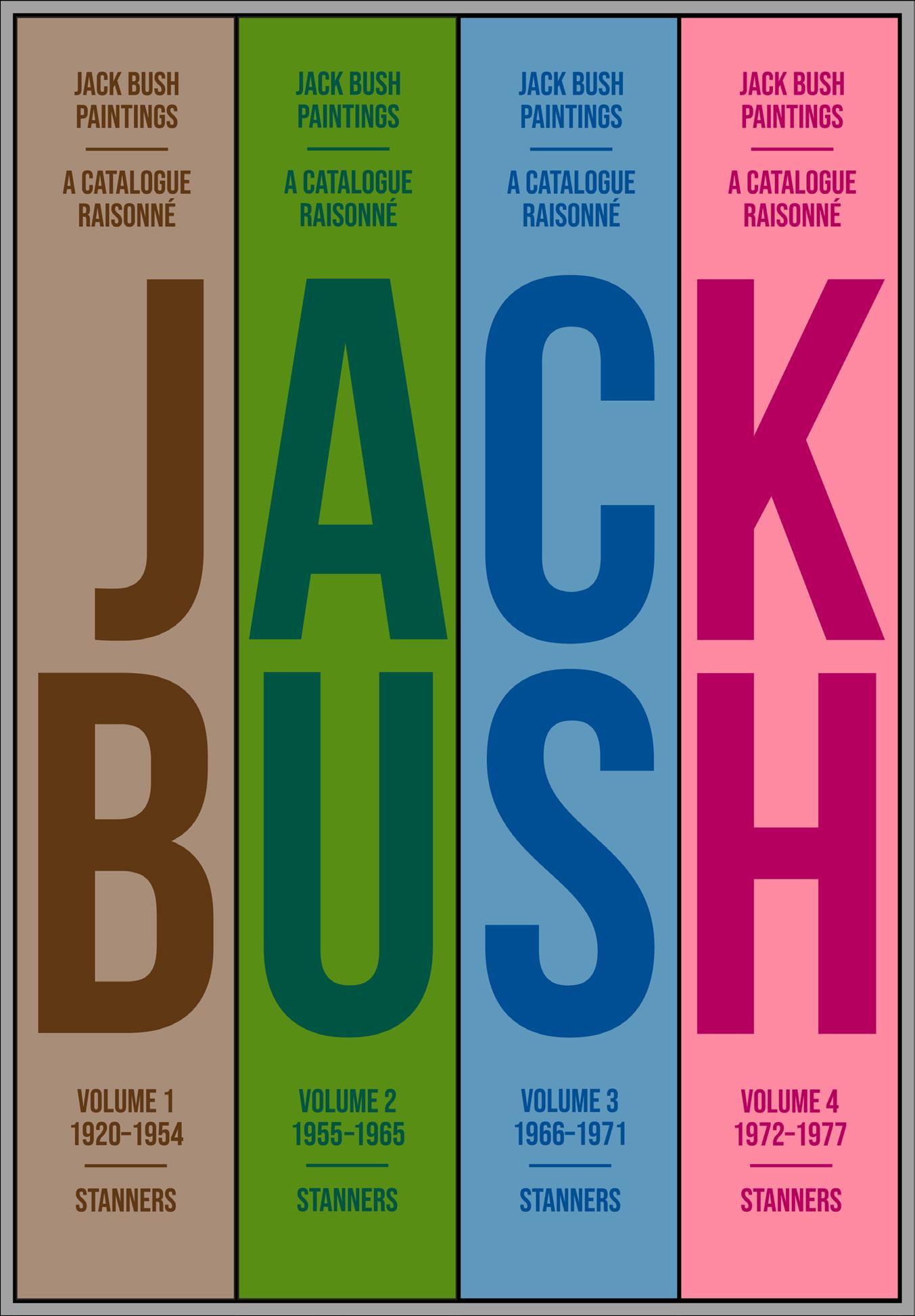
Publishing partners: Coach House Press & DM Books Distributed by: University of Toronto Press Deluxe limited edition of 100 - SOLD OUT Standard limited edition of 500 - selling fast To secure your copy and to learn more: visit www.jackbushcatalogue.com or call 647-323-6459



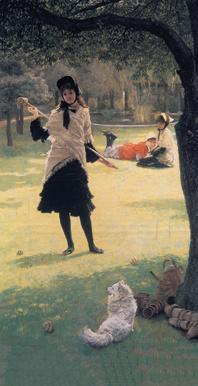
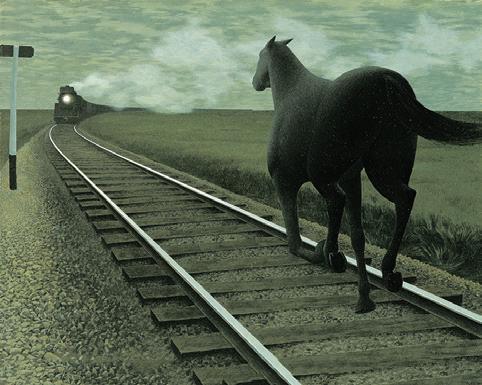

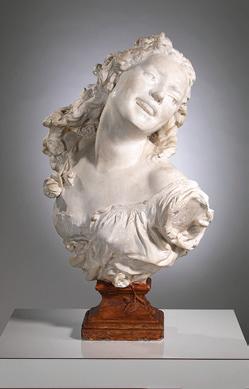



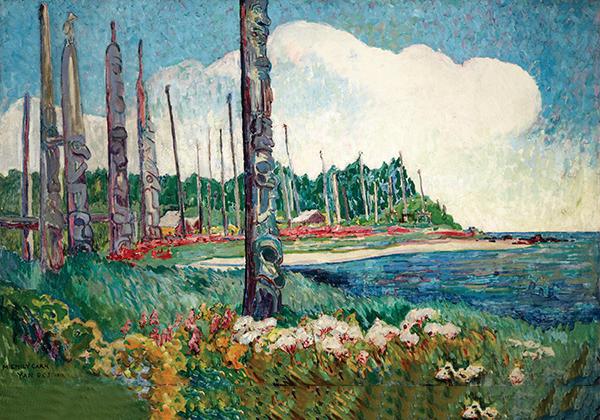
DISCOVER THE OLDEST AND LARGEST PUBLIC ART GALLERY IN SOUTHWESTERN ONTARIO RIGHT HERE IN HAMILTON! 123 King Street West 905.527.6610 x272 artgalleryofhamilton.com Free Thursdays: 11 am - 9 pm Fridays: 11 am - 6 pm Saturdays & Sundays: 11 am - 5 pm DISCOVER the ART GALLERY of HAMILTON CELEBRATING 110 YEARS
credits: Kim Adams (Canadian, born 1951), Bruegel-Bosch Bus 1966-ongoing, mixed media,1960s Volkswagen, figurines. Acquired with the Assistance of the York Wilson Endowment Award at the Canada Council for the Arts, The Muriel Baker Fund, The Russell Nelson Eden Fund and The Walter and Duncan Gordon Foundation, 2001.
Toni
2021., James
1836-1902), Croquet, 1877-1878, oil
canvas. Gift of Dr. and Mrs. Basil Bowman in memory of their daughter, Suzanne, 1965.
Mike Lalich, 2011., Alex Colville (Canadian, 1920-2013), Horse and Train, 1954, glazed oil on hardboard. Gift of Dominion Foundries
Steel, Ltd. 1957.
1877-1917),
1915-1916, oil
Gift of Roy G. Cole in memory of his parents, Matthew and Annie Bell Gilmore Cole, 1967.
2008.,
Bacchante aux Roses
plaster
painted base, The Joey
1912, oil
Gift
Roy G. Cole, 1992.
Mike Lalich, 2008.
Image
Photo by
Hafkenscheid,
Tissot (French,
on
Photo by
and
Photo courtesy of Canadian Conservation Institute., Tom Thomson (Canadian,
The Birch Grove Autumn
on canvas.
Photo by Mike Lalich,
Jean-Baptiste Carpeaux (French, 1827-1875),
n.d.,
with
and Toby Tanenbaum Collection, 2002. Photo by WaveLength,
2004., Emily Carr (Canadian, 1871-1945), Yan Q.C.I.,
on canvas.
of
Photo by







Great advice to grow your wealth. Great advice pays off. When it comes to managing your wealth, our experienced advisors help you navigate whatever comes your way. bmo.com/privatewealth BMO Private Wealth is a brand name for a business group consisting of Bank of Montreal and certain of its affiliates in providing private wealth management products and services. Not all products and services are offered by all legal entities within BMO Private Wealth. Banking services are offered through Bank of Montreal. Investment management, wealth planning, tax planning, and philanthropy planning services are offered through BMO Nesbitt Burns Inc. and BMO Private Investment Counsel Inc. Estate, trust, and custodial services are offered through BMO Trust Company. BMO Private Wealth legal entities do not offer tax advice. BMO Trust Company and BMO Bank of Montreal are Members of CDIC. ®Registered trademark of Bank of Montreal, used under license. 01/23-0159

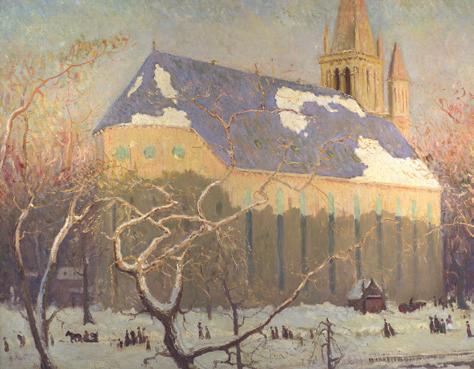
Bertram Brooker (1888–1955), Sounds Assembling (detail), 1928, oil on canvas, 112.3 x 91.7 cm, collection of the Winnipeg Art Gallery, L-80.
Ernest Mayer, courtesy of WAG-Qaumajuq; Robert Pilot (1898–1967), St. Patrick’s Church, Montreal, oil on canvas, 71.7 x 91.4 cm, Comsatec Inc.
Photo:
Home to the Art of Canada An Agency of the Government of Ontario On now through June 2 — Discover a trailblazer of Canadian abstraction, a visionary who sought to unite humanity through art Lead Sponsor Tony Comper C.M. Carol Gray Donald K. Johnson O.C. Bertram Brooker WHEN WE AWAKE! RIVER OF DREAMS Impressionism on the St. Lawrence June 22, 2024 – Jan 13, 2025 mcmichael.com Supporting Sponsors Media Partner
Photo: Heffel Fine Art Auction House
INDEX OF ARTISTS
Brooker, Bertram Richard (1888-1955) 114
Comfort, Charles Fraser (1900-1994) 104 Cullen, Maurice Galbraith (1866-1934) 132
Eyre, Ivan Kenneth (1935-2022) 106
FitzGerald, Lionel LeMoine (1890-1956)
107, 108
Gagnon, Clarence Alphonse (1881-1942) 122
Harris, Lawren Stewart (1885‒1970)
124, 125
Holgate, Edwin Headley (1892‒1977) 134
Jackson, Alexander Young (1882‒1974)
128, 131
Johnston, Frank Hans (1888-1949) 127
Kane, Paul (1810-1871) 116, 117
Krieghof, Cornelius (1815-1872) 118
Kurelek, William (1927-1977) 111
Lismer, Arthur (1885-1969) 103
Lochhead, Kenneth Campbell (1926-2006) 109
MacDonald, James Edward Hervey (1873-1932) 101 Milne, David Brown (1881‒1953) 102, 129
Phillips, Walter Joseph (1884-1963)
105 Pilot, Robert Wakeham (1898-1967) 123, 126
Reid, George Agnew (1860-1947) 113 Robinson, Albert Henry (1881-1956) 112, 121
Savage, Anne Douglas (1896-1971)
119 Scott, Marian Dale (1906-1993) 120 Seath, Ethel (1879-1963) 133 Shadbolt, Jack Leonard (1909-1998) 130 Suzor-Coté, Marc-Aurèle de Foy (1869-1937)
135, 136, 137
Tascona, Tony (1926-2006) 110
Warhol, Andy (1928-1987) 115
Front Cover
Lawren Harris, Brazeau Snowfeld, Jasper Park. Mountain Painting XII (Lot 124)
Back Cover
Clarence Alphonse Gagnon, A Laurentian Homestead, 1923 (detail) (Lot 122)
Inside Front Cover
Arthur Lismer, Georgian Bay (detail) (Lot 103)
Inside Back Cover
Albert Henry Robinson, Les Éboulements en haut (detail) (Lot 121)
Artwork Features
Page 1: Frank Johnston, Sun Song of Algoma (detail) (Lot 127)
Page 2: Alexander Young Jackson, Eastern Arctic (detail) (Lot 131)
Page 4: Ivan Eyre, Café (detail) (Lot 106)
Page 6: William Kurelek, Negrich Family Threshing Outft (detail) (Lot 111)
Page 18/19: Lionel LeMoine FitzGerald, Untitled (Broken Tree in Landscape) (detail) (Lot 107)
Page 32: Andy Warhol, Wayne Gretzky #99 (detail) (Lot 115)
Page 36/37: Paul Kane, Party of Indians in Two Canoes on Mountain Lake (detail) (Lot 116)
Page 42: Paul Kane, Lodges Near Fort Vancouver, 1847 (detail) (Lot 117)
Page 56/57: Clarence Alphonse Gagnon, A Laurentian Homestead, 1923 (detail) (Lot 122)
Page 62/63: Lawren Harris, Brazeau Snowfeld, Jasper Park. Mountain Painting XII (detail) (Lot 124)
Page 67: Lawren Harris, Coronet Mountain, Brazeau Glacier, 1924 (detail) (Lot 125)
Page 76/77: David Milne, The Black Chimney (detail) (Lot 129)
Page 102: Ethel Seath, St. Sulpice Garden, 1930 (detail) (Lot 133)
